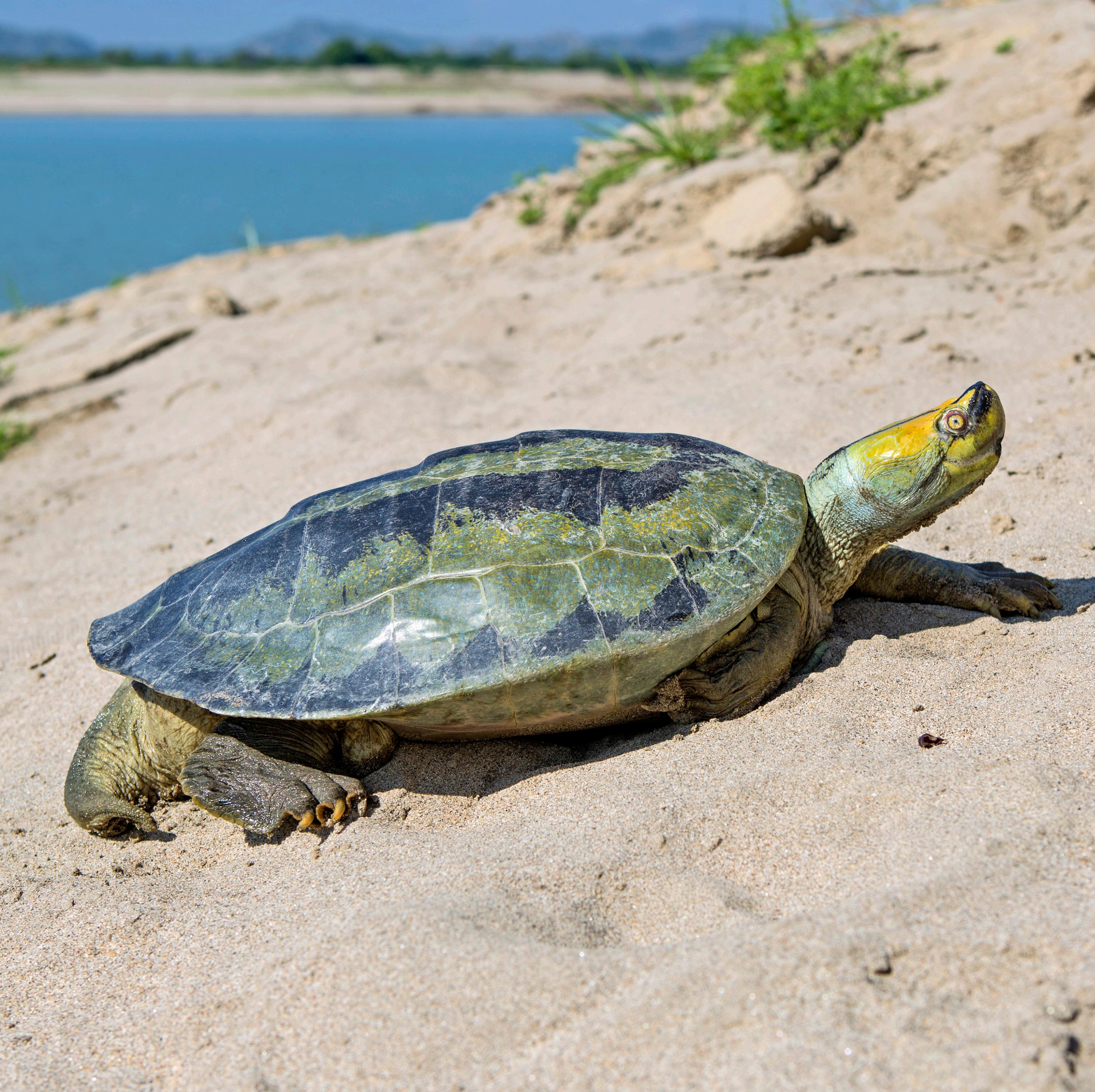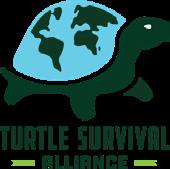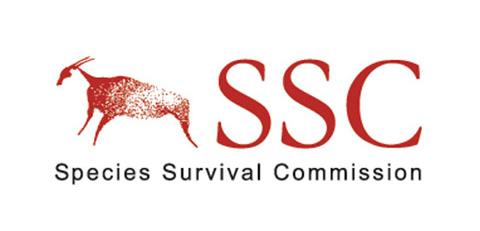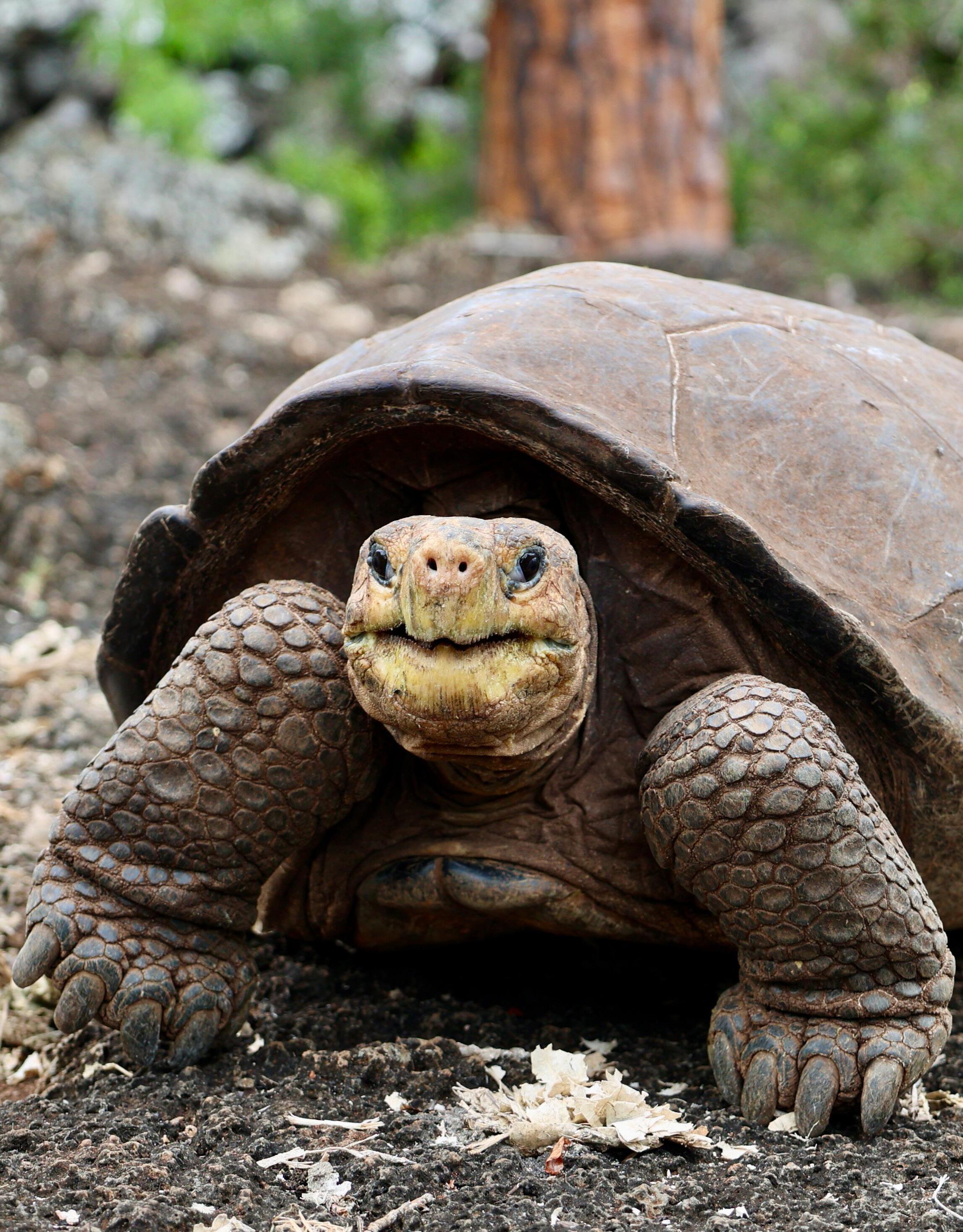

TURTLES IN TROUBLE
THE WORLD’S MOST ENDANGERED TORTOISES AND FRESHWATER TURTLES – 2025
There is no vertebrate group facing greater survival problems today. Turtles saw the great dinosaurs come and go and are now facing their own extinction crisis.
— John L. Behler, former Chair, TFTSG
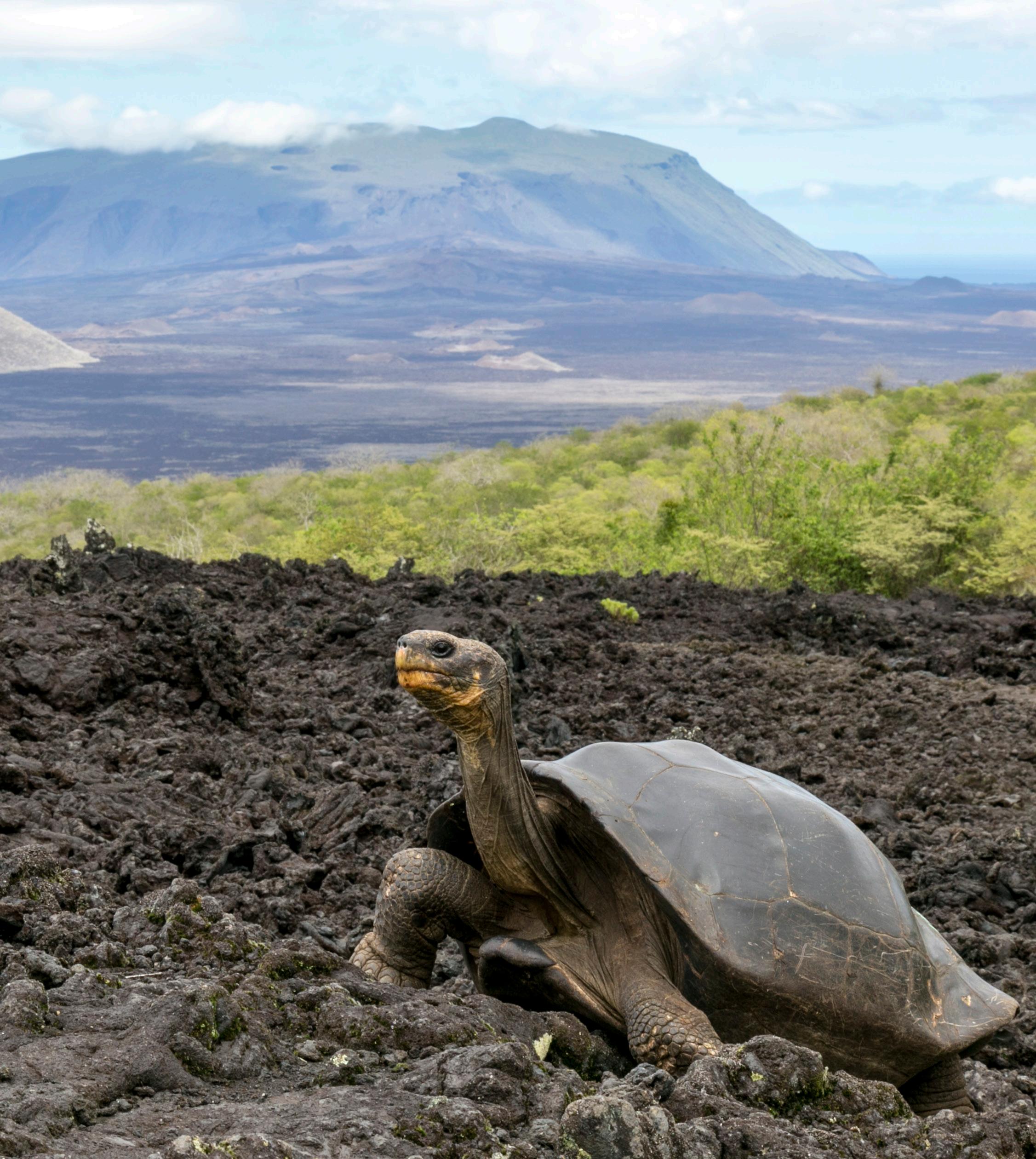
Printed by Inkspot Press, Bennington, Vermont, USA. Published July 2025. Hardcopy available from Turtle Conservancy, P.O. Box 1289, Ojai, CA 93024 USA. Digital pdf copy available for download at www.iucn-tftsg.org/trouble/ and www.turtleconservancy.org/trouble/ Hardcopy and digital pdf copies also available from other Turtle Conservation Coalition participants: Turtle Conservation Fund (www.turtleconservationfund.org) and Turtle Survival Alliance (www.turtlesurvival.org).
Above: Volcán Wolf Giant Tortoise, Chelonoidis niger becki; photo by Paul M. Gibbons, Turtle Conservancy
Front Cover: Fernandina Giant Tortoise, Chelonoidis niger phantasticus; photo by Galapagos Conservancy
Inside Rear Cover: Arakan Forest Turtle, Heosemys depressa; photo by Eric V. Goode, Turtle Conservancy
Rear Cover: Burmese Roofed Turtle, Batagur trivittata; photo by Kyaw Zaw Aung, Myanmar
TURTLES IN TROUBLE:
The World’s Most Endangered Tortoises and Freshwater Turtles – 2025
Presented by the Turtle Conservation Coalition
IUCN SSC Tortoise and Freshwater Turtle Specialist Group, Turtle Conservancy, Turtle Survival Alliance, Turtle Conservation Fund, Re:wild, and Chelonian Research Foundation
Editors:
Craig B. Stanford1,2,6, Anders G.J. Rhodin3,6, Peter Paul van Dijk3,4,6, Torsten Blanck5, Eric V. Goode6, Rick Hudson7, Andrew D. Walde7, Jordan Gray7, Russell A. Mittermeier4, and Vivian P. Páez8
1University of Southern California; 2Los Angeles Natural History Museum;
3Chelonian Research Foundation; 4Re:wild; 5Cuora Conservation Center/Turtle Island;
6Turtle Conservancy; 7Turtle Survival Alliance; 8Universidad de Antioquia
Additional Contributors:
Diverlie Acosta, Maslim As-singkily, Clodoaldo L. Assis, Omar Attum, Dincer Ayaz, Ernst Baard, Yusuf Bayrakcı, Gamaliel Castañeda Gaytán, Pelf-Nyok Chen, Andrea Currylow, Marc Dupuis-Desormeaux, Sreeparna Dutta, Germán Forero-Medina, Natalia Gallego-García, Arthur Georges, Joko Guntoro, Cris Hagen, Sung Yik Hei, Oki Hidayat, Scott Hillard, John B. Iverson, Ayushi Jain, Cristina Jones, James O. Juvik, A. Ross Kiester, Michael Knoerr, Gerald Kuchling, Victor Loehr, Luca Luiselli, Patrick Kinyatta Malonza, Kalyar Platt, Steven G. Platt, Rodrigo Macip Ríos, Pearson McGovern, Thong Pham, Christopher Poyser, Peter Praschag, Eduardo Reyes Grajales, Sabine Schoppe, Haitao Shi, Shailendra Singh, Sitha Som, Ricky Spencer, Washington Tapia, Phun Thorn, Rafael M. Valadão, Christiane Wiese, and Robert Zappalorti
Design and Layout:
Maximilian S. Maurer6 and Abby Roeser6
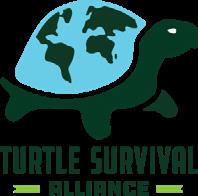


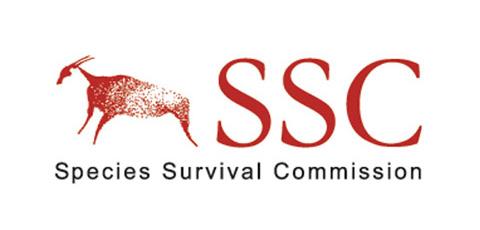
Ojai, California 2025
Turtles and tortoises are among the most threatened of all the major vertebrate groups (Stanford et al. 2020). There are currently 364 generally recognized species and 493 total taxa of modern (non-fossil) turtles and tortoises (Turtle Taxonomy Working Group, TTWG 2021, 2025). This figure includes the seven species of marine turtles, for which the conservation status is determined by the IUCN Marine Turtle Specialist Group. The conservation status of tortoises and freshwater turtles is determined by the IUCN SSC Tortoise and Freshwater Turtle Specialist Group (TFTSG). Of the total of 364 species, all are either already officially assessed and published or currently “in press” to be published soon on the IUCN Red List of Threatened Species (www.iucnredlist.org), or else provisionally assessed by the TFTSG in preparation for inclusion on the list. Of these 364 species, 196 (53.8%) are now considered Threatened using IUCN criteria (categorized as Vulnerable, Endangered, or Critically Endangered), 134 (36.8%) are considered Endangered or Critically Endangered, and 201 (55.2%) are either Threatened or already Extinct. Ten taxa—five species and five subspecies (1.4% of all species, 2.0% of all taxa)—have gone extinct in recent human history, but none since 2012. However, two species are teetering very close to the edge of extinction, with only one or a handful of known animals remaining.
These current numbers and percentages of threatened and endangered turtle species have worsened since our last evaluation seven years ago. Rhodin et al. (2018) estimated that if one also took into account provisional assessments of previously unevaluated species and reassessments in progress by the TFTSG at that time, 179 (50.3%) of 360 species recognized at that time were Vulnerable, Endangered, or Critically Endangered, 114 (32.0%) of all species were Endangered or Critically Endangered, and 186 (52.2%) were either Threatened or already Extinct.
The numbers and percentages of threatened and endangered turtle species have not improved over these last seven years, despite concerted efforts by the many organizations focused on turtle and tortoise con-
servation; in fact, they have worsened. The percentages are more dire for turtles and tortoises than they are for most large groups of vertebrates. Only the nonhuman primates, with approximately 61% of species threatened with extinction, are in a more precarious state (Schwitzer et al. 2019).
The perilous state in which so many turtles and tortoises exist is a tragic irony considering the remarkable set of evolutionary adaptations they possess (Stanford et al. 2020). The shell, evolved over two hundred million years ago, is a remarkable evolutionary adaptation. So are their main evolved strategies: slow growth, high survival rates of adults, and extreme longevity. Unfortunately, these traits do not protect them from human development or human depredations. In fact, the slow maturation time of many species, combined with high juvenile mortality, leaves them extremely vulnerable to human pressures.
Turtles and tortoises are underappreciated for the important roles they play in the ecosystems they inhabit. Historically, they have represented important components of ecosystem biomass (Lovich et al. 2018).
Larger species serve as ecological engineers, consuming plants that allow competing plants to grow. The seeds and spores of many plants, trees, and fungi are dispersed and often germinate more reliably after ingestion by turtles, while their droppings provide instant fertilizer. In neotropical forests, tortoises are dispersers of the seeds of fallen fruit. The Gopher and Desert tortoises (Gopherus) of North America provide habitat for myriad other species in their deep burrows. Diamondback Terrapins (Malaclemys) keep populations of Littorina snails in check, which would otherwise overgraze and denude tidal salt marshes. Snapping turtles and softshell turtles are important scavengers that help to maintain clean aquatic ecosytems. Turtles and tortoises also play an important cultural role in human history, depicted in art and as icons of longevity in many societies. Losing them would not only degrade ecosystems and contribute to the widespread loss of biodiversity; it would destroy an important piece of human culture.
Table 1. Tortoises and freshwater turtles that have gone extinct in modern recorded history, with approximate extinction dates (one genus, five species, and five subspecies = ten taxa).
KINOSTERNIDAE
Viesca Mud Turtle
TESTUDINIDAE
Pinta Giant Tortoise
Santa Fé Giant Tortoise
Floreana Giant Tortoise
Kinosternon hirtipes megacephalum ca. 1970s
Chelonoidis niger abingdonii 2012
Chelonoidis niger, unnamed subspecies ca. 1890s
Chelonoidis niger niger ca. 1850
Daudin’s Giant Seychelles Tortoise Aldabrachelys gigantea daudinii ca. 1850
Reunion Giant Tortoise
Cylindraspis indica ca. 1840
Rodrigues Domed Tortoise Cylindraspis peltastes ca. 1795
Rodrigues Giant Saddle-backed Tortoise Cylindraspis vosmaeri ca. 1795
Mauritius Giant Domed Tortoise Cylindraspis inepta ca. 1735
Mauritius Giant Flat-shelled Tortoise Cylindraspis triserrata ca. 1735
Tortoises and freshwater turtles are today under intense, increasing pressure from humans. Their populations are being decimated and extirpated by development, agriculture, and land and water pollution. They are eaten along with their eggs, collected both by local peoples who have done so for centuries, and on a larger scale to satisfy commercial demands for turtle meat and eggs. In some parts of the world they are used in traditional medicines. The pet trade, both legal and illegal, severely threatens many species, especially the rarest among them. While there are a few success stories, most chelonians are in terrible trouble, with more than a few at the very edge of extinction.
For example, a prominent and widely publicized example of the extinction risk crisis is the Ploughshare Tortoise (Astrochelys yniphora) which has been in dramatic decline for decades, due mainly to illegal poaching. It is likely functionally extinct in the wild, where only a small handful of individuals may still persist. Several dozen live in a forested enclosure, fenced in and under armed guard, in their former habitat at Baly Bay, Madagascar, but hundreds if not thousands languish in illegal captivity with private collectors who see them primarily as status and investment animals. This 2025 edition of the Turtles in Trouble publication is part of an ongoing effort to publicize the plight
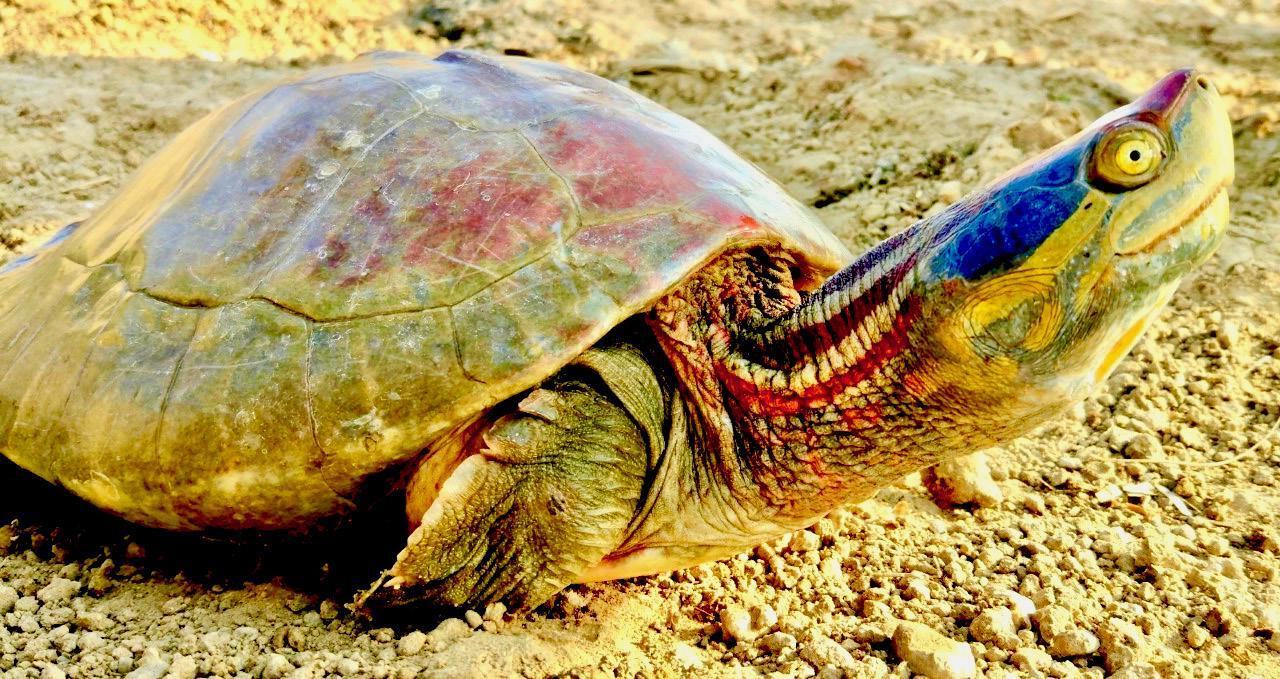
The Red-crowned Roofed Turtle, Batagur kachuga, has been largely extirpated from the Indo-Gangetic plain, but a small population persists along a short section of the Chambal River in India, where it is the focus of intensive conservation efforts.
Shailendra Singh
of tortoises and freshwater turtles by highlighting those species that are at imminent and greatest risk of extinction. We hope that by calling greater attention to these magnificent creatures, we can help to generate more international attention, more resources, and more conservation action to save them. Through the actions of conservationists around the globe, efforts have been underway for several decades to protect the many endangered species of tortoises and freshwater turtles. Time will tell if our actions are enough to prevent many species from sliding into extinction. We humans are the cause of the extinction crisis, but we are also able to provide the solutions. Those of us in the turtle conservation community believe that saving these jewels of evolution is a battle that can and must be won.
TURTLES IN TROUBLE: HISTORY AND METHODS OF THE LISTING PROCESS
Every several years since 2003, a working group of tortoise and freshwater turtle conservationists has published a list of the “Top 25 Most Endangered Turtle Species.” The first Top 25 list was produced in 2003 by the Turtle Conservation Fund, entitled “Top 25 Turtles on Death Row” (TCF 2003). The second edition was issued in 2007 by the IUCN Tortoise and Freshwater Turtle Specialist Group (TFTSG 2007). It expanded the list beyond 25 species and arranged them in rough order of extinction risk; it also presented regional lists. The third edition in 2011 was published by a working group of individuals representing a range of turtle-focused conservation organizations, who adopted the name Turtle Conservation Coalition (TCC 2011) to reflect the collaboration. That update continued to add species beyond the Top 25 (and was then branded the “Top 25+”), recognizing that there are far more than 25 species at imminent and high risk of extinction. While not ranked by extinction risk, the list was categorized into the Top 25, “the other Top 40” and “Others.” A total of 49 species were reviewed. The 2018 edition, also compiled by the Turtle Conservation Coalition (TCC 2018), presented the Top 25 and Top 50 most endangered taxa, with an appendix describing an additional 15 species.
As much as possible, our 2025 list—now titled Turtles in Trouble (no longer including “Top 25+” in the title)—reflects our inclusion of significantly more than 25 species on our list, and prioritizes the estimated risk of extinction of each species over political or market-driven considerations. We polled about 30 leading global turtle conservationists, including many field-based practitioners, most of them members of the IUCN SSC Tortoise and Freshwater Turtle Specialist Group, and then rank-ordered their choices for inclusion on the list. The results are presented here, with some closely related endangered species clustered solely for presentation purposes. We have selected 66 of the 364 chelonian species (18.1%) as being the most endangered of all turtles and tortoises. For some genera and species in which multiple species or subspecies were deemed at critical risk, we chose to group them together on a page or a two-page spread, notably the listing of species of the Asian genera Batagur and Cuora , and the various subspecies of the Rough-footed Mud Turtle, Kinosternon hirtipes, from Mexico.
Like previous editions of the most endangered turtles, this publication has selected species for inclusion based on our consensus of their survival prospects and extinction risks. We did not rank species by conservation efforts needed or based on phylogenetic distinctiveness, lineage history, geographic or taxonomic priority, or ecosystem significance of the species in question.
PATTERNS OF THREAT TO TORTOISES AND FRESHWATER TURTLES
Over the past century, only two subspecies of turtles and tortoises have gone extinct (the Pinta Giant Tortoise, Chelonoidis niger abingdonii, in the Galapagos, and the Viesca Mud Turtle , Kinosternon hirtipes megacephalum, in Mexico; Table 1). No full species have been lost since the mid-1800s when the last of the Mascarene Giant Tortoises (five different Cylindraspis species) were exploited into extinction. However, more than half of all turtles and tortoises are under threat of possible extinction (Table 2), and some hover on its very brink. The geographic distribution of this new
edition of Turtles in Trouble comprises five continents, but is heavily skewed to Asia, the continent with the greatest species diversity: 32 of the most endangered 66 taxa (48.4%) are native there (Table 3). This skewed representation applies to countries as well, with 9 species (13.4%) of the Turtles in Trouble coming from China and 23 (34.3%) from four South or East Asian countries (China, India, Indonesia, and Vietnam; Table 4).
The epicenter of the turtle and tortoise extinction crisis is squarely on the Asian continent. This is partly because turtle diversity is high in the region—meaning more species are affected—but the primary causes are the intense harvesting of adults and eggs, the largely illegal international trade in turtles and turtle products, and the added pressure of some of the highest human population densities in the world.
Taxonomically, the Turtles in Trouble list comprises nine tortoise and freshwater turtle families. The fami-
lies and genera hit hardest are those with species represented in Asia. The largely Asian family Geoemydidae comprises 16 species (23.5%); the tortoise family Testudinidae comprises 13 species (19.4%). Genera that have been hit hardest by extinction threats are Cuora—the Asian Box Turtles—accounting for six species. The large river turtles of the genus Batagur account for five species. In other words, almost one fifth of the most endangered species of turtles on Earth are from just two genera, both of them Asian. India and Indonesia are third and fourth on the list of countries with the largest number of endangered species, followed by Madagascar.
Nearly all endangered turtle species fall into one of three distinct, partially overlapping, clusters: 1) the prehistoric trend of widespread extinctions of large tortoises endemic to islands (Cylindraspis, Chelonoidis , etc.), which has continued into historic and
Table 2. Conservation status according to IUCN Red List criteria of all 364 currently recognized species of tortoises, freshwater turtles, and marine turtles, including officially published and “in press” Red List assessments, plus provisional assessments by the IUCN SSC Tortoise and Freshwater Turtle Specialist Group (TFTSG).
Table 3. Geographic distribution by continent of the 66 most endangered species and subspecies (taxa) of turtles and tortoises included in this Turtles in Trouble report.
Table 4. Top countries with the most endangered species of turtles and tortoises included in this Turtles in Trouble report.
Table 5. Taxonomic distribution of the most endangered species of turtles and tortoises included in this Turtles in Trouble report.
present times (Turtle Extinctions Working Group, TEWG 2015); 2) large riverine and estuarine turtles with predictable nesting sites and times (Batagur, Podocnemis) or easily recognized nesting tracks (Chitra, Pelochelys, Rafetus, Cyclanorbis); and 3) restricted-range species that are very specifically targeted for exploitation because of their tasteful meat (Dermatemys), their perceived medicinal use (genera Cuora and Mauremys), and/or their desirability as pets (Cuora species , Chelodina mccordi, Astrochelys species , Geochelone platynota, Pyxis species , Testudo kleinmanni).
Like previous versions of the Turtles in Trouble/ Top 25+ publications, this document has selected the species for inclusion based on their survival prospects and extinction risks, but not ranked in order of our perception about how critically endangered they are in regard to each other. Of course, since only one living animal of the recently rediscovered Fernandina Giant Tortoise, Chelonoidis niger phantasticus, is known to exist, it is clearly the rarest chelonian on the planet at this time and at an extremely high risk to go extinct. It
is followed closely by the Red River (or Yangtze) Giant Softshell Turtle, Rafetus swinhoei, of which perhaps only a handful of living individuals are known and is also highly likely to go extinct unless more animals can be found.
The list is also not explicitly based on phylogenetic uniqueness or lineage history of the species in question. The EDGE approach (Evolutionarily Distinct, Globally Endangered; see Isaac et al. 2007), developed for mammals, presents a possible prioritization method which weighs evolutionary uniqueness as well as threats. An EDGE analysis for turtles would be very informative for conservation prioritization, but needs better resolution of turtle phylogeny and dating of the splits in turtle relationships; as such we choose to not incorporate a formal EDGE analysis in the current document. Some generalities emerge, however, from a preliminary analysis, including the very high EDGE values for monotypic genera, families, and subfamilies known to have deep phylogenetic ages (Joyce et al. 2013; Crawford et al. 2015; Shaffer et al. 2017). Turtle EDGE species include the
Central American River Turtle (Dermatemys mawii), the Pig-nosed Turtle (Carettochelys insculpta), the Asian Big-headed Turtle (Platysternon megacephalum), the Western Swamp Turtle (Pseudemydura umbrina), and the Madagascan Big-headed Turtle (Erymnochelys madagascariensis). Meanwhile, EDGE values for relatively young genera with multiple highly endangered species such as the Asian Cuora or Batagur species are significantly lower.
Asia is the epicenter of the chelonian extinction risk crisis. The long-term historical exploitation in Asia of turtles for food, traditional medicines, and more recently as pets, has been an important part of the increased global use of turtles and tortoises. Economic development in China and other Asian countries has elevated the exploitation of chelonians for both food and pets to unsustainable commercial levels. The impacts of the growing turtle trade in Asia have been well-detailed (van Dijk et al. 2000; Horne et al. 2012); they have only increased in the years since. Turtles and tortoises are highly valued as symbols of good luck and longevity in Asian culture, and the pet trade there has skyrocketed. Combined with the rapid decline of many Asian species, an expanding illegal marketplace now exists in which the sale of an individual turtle may command an astronomical price, creating an economic incentive for intense collecting, poaching, and smuggling. This trend, sadly, extends globally: the Asian countries have surpassed the West as mass importers of turtles from other regions, and protected species from North America, Latin America, Africa, and elsewhere are now being smuggled there.
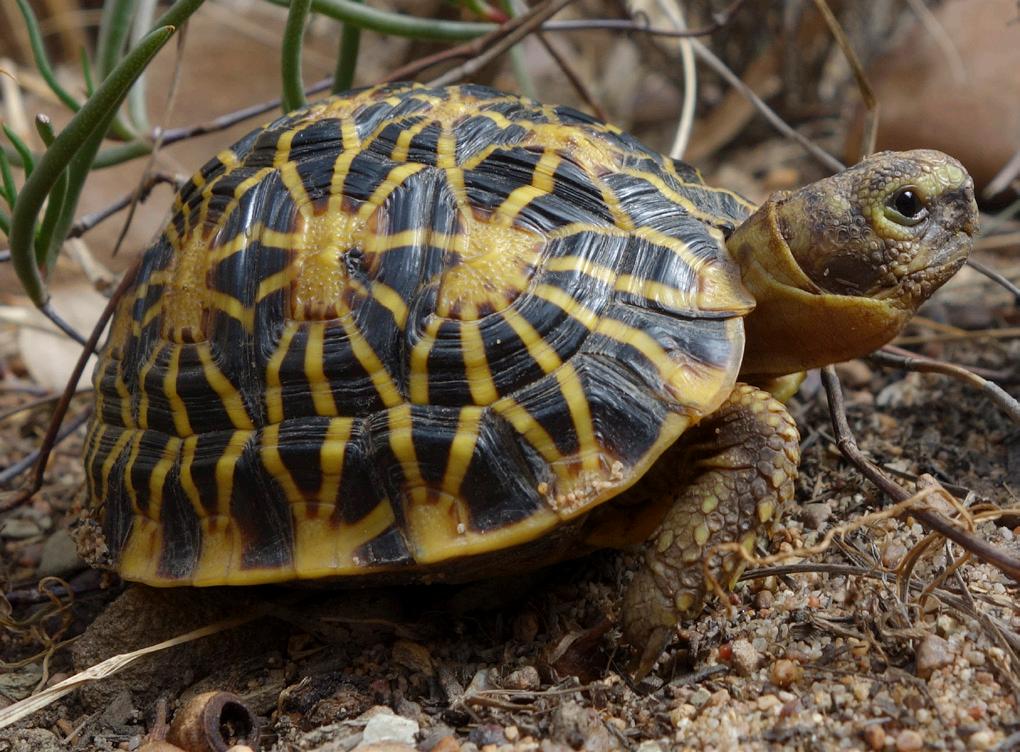
RECENT PROGRESS AND SUCCESS IN CHELONIAN CONSERVATION
In the midst of a crisis of imminent extinction risk to so many chelonian species, there is also progress to report. In-situ conservation success should always be the top priority—protecting and saving wild populations before they are extirpated is preferable to attempting large-scale captive breeding projects followed by reintroductions. However, when wild populations are in critical decline and facing likely extinction, the priority must also be on building up numbers in protected situations as a safeguard against extinction. Although captive breeding and reintroductions involve risks, including the need for husbandry and breeding expertise, sometimes with species that are delicate or difficult to breed in captivity, they are an important component of a comprehensive conservation strategy when warranted. Important considerations are the financial cost of the staff and equipment for supporting the rescue centers that rehabilitate and maintain animals prior to reintroduction and then for post-release monitoring. Other considerations include the need for thorough disease screening to reduce the possibility of introducing pathogens to wild populations, site fidelity of animals following release, and the protection of reintroduced populations from resumed poaching.
The Galápagos Islands, scene of our only recent tortoise extinction in the past 40 years, is also the setting for dramatic successes. Captive breeding of the last 13 surviving saddle-backed Española Giant Tortoises, Chelonoidis niger hoodensis, has led to reintroduction of their offspring and restoration of a breeding population on Española Island. Because of their close genetic relatedness to the extinct Santa Fé Giant Tortoise (Chelonoidis niger, unnamed subspecies), more than 200 have also been introduced to Santa Fé Island. A similar triumph is unfolding on Pinzón Island, where after more than 100 years of no reproduction, clearing
The recently created 437-hectare private Geometric Tortoise Preserve in South Africa holds the largest population of this species remaining in the wild.
that island of invasive rats has allowed reintroduction of juveniles of the Pinzon Giant Tortoise, C. niger duncanensis, to its native habitat, where successful reproduction is now occurring. In the Indian Ocean, the Aldabra Giant Tortoise, Aldabrachelys gigantea ,, whose numbers were decimated in the late 19th century, has rebounded on Aldabra atoll, and the species is abundant in captive and semi-captive settings across the islands of the Indian Ocean and around the world.
The rarest of all Australian turtles and perhaps the rarest Australian reptile, is the Western Swamp Turtle, Pseudemydura umbrina . The turtles’ existence was recognized as being under threat at least 75 years ago, leading to the establishment of two small nature reserves around their wetland habitats for protection. It has long been classified as Critically Endangered by both the Australian government and the IUCN Red List. But an ever-dropping water table, road traffic that crushes migrating turtles, and increasingly severe annual brush fires—exacerbated by climate change and prolonged drought—continued to hammer the species. By the 1980s, only a few dozen remained in the wild.
This species was brought back from the brink of extinction through captive breeding, head-starting, and reintroductions, to a still-precarious but tenfold increase from 30 to 300 animals. And instead of trying to protect a habitat doomed by climate change, the decision was recently made to initiate assisted migration to a new site. This meant relocating an entire population of the species to a novel site farther south, where rainfall was greater, and models predicted a more optimal future climate. The assisted migration of Western Swamp Turtles, directed by Gerald Kuchling and colleagues, appears to have succeeded, although only long-term monitoring will determine if self-sustaining new populations will become established. This is a potential solution for other species as well, and although it would not necessarily work everywhere, it will likely become a more frequent strategy in the decades ahead.
Assisted migration and rewilding has already been initiated for the Bolson Tortoise, Gopherus flavomarginatus, from northern Mexico. An ongoing effort to establish a new population is underway in New Mexico, part of the species’ former range, where cli-
mate change is not yet predicted to affect the species as severely as farther south in its currently reduced native habitat.
The Madagascan Big-headed Turtle, Erymnochelys madagascariensis, has been successfully bred for a long time at a captive breeding center at Ampijoroa, Madagascar, and successful reintroductions into native habitats have been undertaken and are being monitored. In southern Madagascar, efforts are underway to reintroduce Radiated Tortoises, Astrochelys radiata , confiscated from the illegal trade. Thousands have been released into protected forests, where they, too, are under close monitoring.
The Geometric Tortoise, Psammobates geometricus, endemic to a small area of South Africa, has lost over 90% of its natural habitat and populations, but persists mainly in a few small reserves. But efforts by local and international turtle conservation organizations have gradually led to increased protected acreage and larger populations of the species, serving as a model for how private land purchase can make a significant difference for the survival of a species.
The critically endangered Dahl’s Toad-headed Turtle, Mesoclemmys dahli, endemic to northern Colombia, has also benefited from the private purchase of habitat, as well as from the first-ever genetic rescue strategy for a turtle species. This pioneering effort involves translocating individuals from a genetically compatible subpopulation to establish a more genetically robust, recovering population. Early results are promising, as conservation genetics begins to play an ever increasingly important role in conservation decisions regarding populations that need restoration.
Conservation of the critically endangered Painted Terrapin, Batagur borneoensis, in Aceh, Sumatra, has been carried out by local conservationists since 2012. Efforts include nest patrols to protect nests and eggs from illegal harvesting and natural predation, rescuing terrapins accidentally caught in fishing gear, conducting community outreach with villagers near the species’ habitat, developing mangrove-based educational tourism, and encouraging fishermen to participate in conservation. In 2024 alone, 110 nests containing more than 1,900 eggs were saved by providing incentives to
local fishermen to protect nests and eggs. The number of nests found and protected during the nesting season has remained relatively stable, with a gradual increase observed over the past decade. As of April 2024, more than 3,200 hatchlings had been released back into the wild.
All of these species and others provide examples and hope that focused conservation efforts for species that are at high risk of extinction benefit from population recovery strategies carried out by dedicated individuals and organizations. In short, these critically endangered species need all the help they can get, and we are all focused on helping to provide that help and to raise the support needed to be increasingly successful.
Habitat protection via land acquisition is one key aspect of the conservation effort to protect turtles and tortoises. When natural areas have been officially designated by governments as National Parks, Wildlife Refuges, Sanctuaries, and Reserves, turtle populations have benefited from the resulting protection. Although few protected areas have been designated primarily for tortoises and freshwater turtles, there are notable exceptions. The Galapagos Islands National Park, where the giant tortoises of the Chelonoidis niger species complex were part of the rationale for protection, is a prime example. Also, two nature reserves were created through land acquisition in Western Australia in 1962 specifically for the protection of the Western Swamp Turtle, Pseudemydura umbrina , and Huocheng National Nature Reserve in Xinjiang, China, was established in 1983 specifically for the protection of the Asian Steppe Tortoise, Testudo horsfieldii.
The private purchase of land for conservation purposes also has a long history, and in recent years
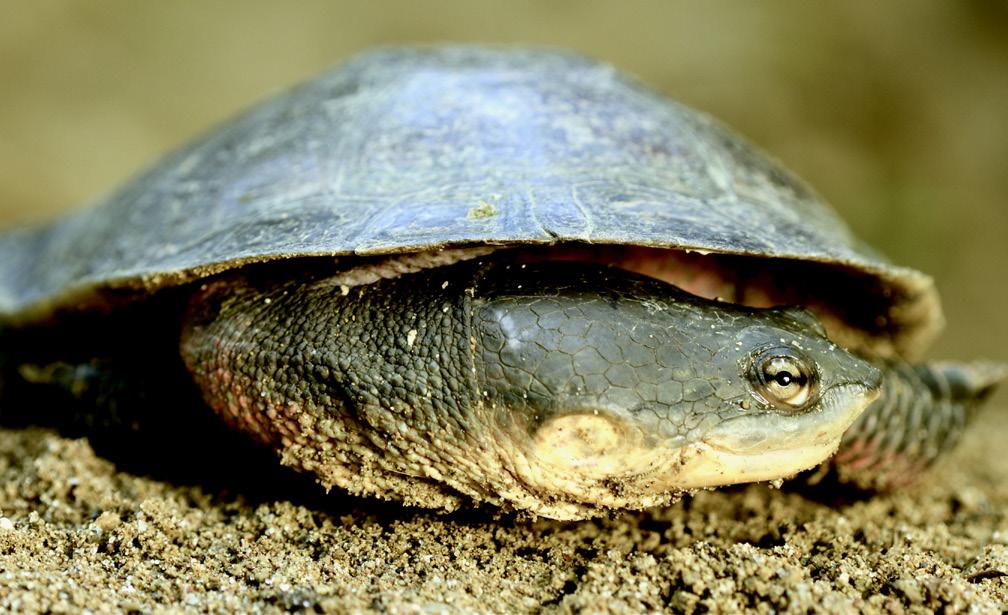
has increasingly included privately-owned and managed protected areas established specifically for tortoises or freshwater turtles. Through this strategy of species and habitat conservation by land acquisition and preservation, one of the organizations in the Turtle Conservation Coalition already owns and manages large tracts of land, including in South Africa for the Geometric Tortoise, Psammobates geometricus, and in northern Mexico for the Bolson Tortoise, Gopherus flavomarginatus. Another large tract of land was recently acquired to protect three restricted-range turtle species in the Cuatro Ciénegas Valley in northern Mexico (the Coahuilan Box Turtle, Terrapene coahuila; the Cuatro Cienegas Slider, Trachemys taylori; and the Black Spiny Softshell, Apalone spinifera atra).
In addition, land has also been purchased by organizations working in concert to protect the bestknown nesting habitat for Hoge’s Side-necked Turtle, Ranacephala hogei, in southeastern Brazil, key habitat for the Palawan Forest Turtle, Siebenrockiella leytensis, in the Philippines, and critical habitat in Colombia to establish a reserve for Dahl’s Toad-headed Turtle, Mesoclemmys dahli. In addition, the recent purchase of Cox Lagoon in Belize has been a major acquisition to protect and manage critical habitat for the Central American River Turtle, Dermatemys mawii
Land purchase alone is of course not enough to safeguard the animals on it. Building infrastructure— including fencing, protection from fire, water level changes, predators and invasive species, anti-poaching patrols, and biodiversity monitoring—are all essential supplements to land acquisition. Working with local communities to build a cooperative, collaborative relationship is essential. For land acquisition to succeed,
The recently established 220-hectare private La Carranchina Natural Reserve in Colombia represents the first in-situ genetic rescue program for a turtle and safeguards 30% of the Dahl’s Toad-headed Turtle’s genetic diversity.
Mauricio Salcedo
the investment of resources, time, and funding in the site and species must be intensive and long-term. Land stewardship, monitoring and evaluation, adaptive management, and enforcement are all necessary components of effective conservation programs.
Legal protection of specific species is a cornerstone of conservation, and tortoises and freshwater turtles have been among the species prioritized for restrictions on offtake or possession, or subject to outright legal prohibition. A wide range of laws, regulations, and conventions are in effect at local, national, and international scales concerning most turtle species, with effects ranging from the designation and protection of critical habitat through restrictions on collection, possession, and local, national, and international trade, to supporting research and trade monitoring. The effectiveness of laws and regulations are often difficult to judge, particularly as illegal activities may continue with little risk of effective prosecution. Nevertheless, many turtle species have avoided excessive impacts from exploitation and trade, and for others, those impacts have been restrained—threats and impacts could have been much worse without laws or regulations, particularly for the Mediterranean Testudo tortoises, the North American Terrapene box turtles and Alligator Snapping Turtle (Macrochelys temminckii), some Asian geoemydids and softshells, and many more.
When in-situ conservation efforts fail or are unsustainable, conservationists often turn to captive breeding with plans to eventually reintroduce head-started juveniles and reconstitute the species in the wild. The feasibility of this approach in the short term depends entirely on the local situation. Whether appropriate habitat still exists is a primary concern, as is whether the original cause of population extirpation is still in effect. Poaching must be curtailed and local communities must be educated about the value of having the animals living near them.
While we believe that conservation of wild populations is the preferred strategy for saving species, there are some that are truly on the brink of extinction or already functionally extinct in the wild and dependent on captive breeding and management for their surviv-
al. While not a panacea for all species, ex-situ captive breeding populations have a strong role to play for some of the more endangered taxa, such as Ploughshare Tortoises, Astrochelys yniphora , and Asian Box Turtles, genus Cuora , in particular. If these captive populations are to remain relevant as true assurance colonies, and preserve future options for the recovery of wild populations, they must be closely managed with the goal of maintaining the maximum level of genetic diversity as possible.
Success in conservation work is often fragile. Considered ecologically extinct in the wild just two decades ago, the Burmese Star Tortoise, Geochelone platynota , has been captive-bred and reintroduced for a decade in Myanmar, and more than 20,000 captivebred hatchlings have been produced and raised in assurance colonies. The current captive population is growing at a rate of 37% per year in three captive breeding centers. Several recent releases of a total of 2,800 head-started tortoises into two protected areas have on the whole been successful. Intensive monitoring of released tortoises via radiotelemetry documented high survivorship, and reintroduced tortoises began to reproduce in the wild—these were likely the first Burmese Star Tortoises hatched in the wild in over a decade. However, the recent civil war in Myanmar has now threatened all the conservation progress that has been achieved and placed these successful results at risk. But despite the civil unrest, conservation work continues in the country for the Burmese Star Tortoise and other critically endangered species.
HOW DO WE DEFINE CONSERVATION SUCCESS?
An important metric of success in the turtle conservation world is the successful reproduction of a population of turtles, either persisting in or reintroduced into the wild, leading to a long term viable population. This alone, however, may not be enough to declare a program successful in the long term. We must also place our programs in a long-term ecological and evolutionary conservation context by combining in-
formation on demography, ecology, genetics, and management measures to demonstrate that our efforts have achieved self-sustaining wild populations. This will require an understanding of the changing environment, including climate change and alterations in land use, so that these can be factored into demographic projections. Resistance and resilience of a population to change are important considerations in assessing success of either in-situ protection or reintroduction programs. When all three metrics—demography, ecology, and genetics—are incorporated into monitoring, evaluating, and adapting a program, we can make specific determinations of success and also direct future efforts based on those data. Success is not just producing more juvenile turtles; instead we must recruit more turtles into habitats where they can fulfill all their life history stages and resume their ecological role within their ecosystem over many generations. This is a difficult task because reducing human-caused mortality must occur simultaneously with increases in recruitment and survivorship if we are to see population growth or recovery. As a conservation community, we must work together to define how these metrics of success should be prioritized. Evaluating our programs using these metrics will enable us to make informed decisions on the management of a given species and what conservation actions may be required.
For example, the Vietnamese Pond Turtle, Mauremys annamensis, is functionally extinct in the wild but is being bred in sizeable numbers in Europe, the United States, and Vietnam. Although the species has been removed from an extinction trajectory, suitable
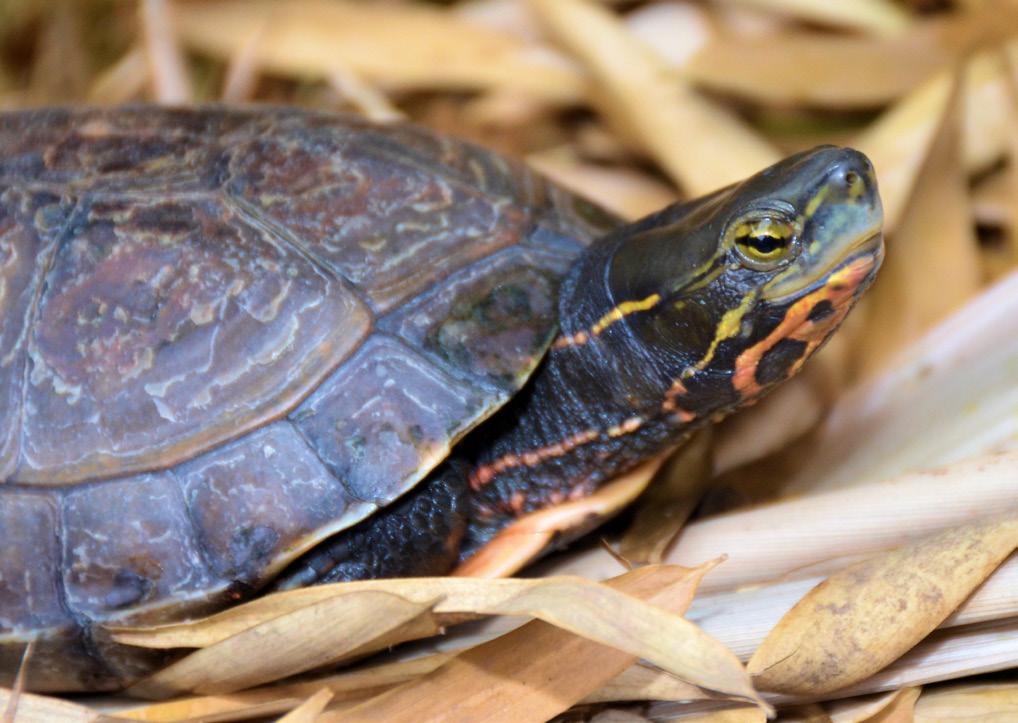
habitat has not been protected for this species and turtles have not been returned to the wild. Moreover, the species has yet to garner the turtle conservation community’s attention in a manner that would allow for sufficient restoration efforts. Multiple generations have been raised in captivity, but unfortunately, large-scale captive breeding often results in the artificial selection of traits and/or individuals that survive better in captivity but may not thrive when reintroduced into the wild. Continuing the trend of ex-situ turtle “conservation warehousing” without proactive and innovative adaptive management at an in-situ landscape scale may result in ecological failure, despite the abundance of a particular turtle or tortoise in captivity.
THE FUTURE OF TORTOISE AND FRESHWATER TURTLE CONSERVATION
The mission of the individuals and groups working to protect turtles and tortoises is to ensure that no species, especially those on this most endangered list, slides into extinction. We should strive for the full ecological conservation or recovery of all turtle and tortoise species in the wild. Such recovery must include genetically diverse and robust populations combined with a functional restoration of each species’ demography, life history, and ecology. These factors will guide us when it comes to determining conservation success. As a community dedicated to chelonian conservation, we have not always done this as well as we would have wished. To better manage our remaining wild populations, we must gather more data on the current status
The Yunnan Box Turtle, Cuora yunnanensis, was thought to be extinct for nearly a century and was only rediscovered in an isolated population in China in 2004. Turtles are in the unenviable position of being one of the most threatened vertebrate groups on Earth.
Torsten Blanck
of essentially all species across their entire ranges, and not just from limited focal study areas for the most endangered species. This must also include species that are currently considered at lower risk of extinction. In many ways, these species of less immediate concern provide a critical foundation to their ecosystems and to turtle conservation. Focusing all of our energy, money, and time on only the most endangered species can have the unintended effect of an unnoticed increase in threats on less endangered, vulnerable, near-threatened, and lower concern species. We need to try to keep our common species common, while working to prevent the most threatened and endangered species from going extinct.
Millions of dollars are spent annually on large mammals such as elephants, rhinos, and tigers in need of large-scale conservation efforts. We should encourage funding organizations to include largescale chelonian projects within their granting parameters. We would benefit from better baseline data to determine which turtle populations are decreasing across their range, and how rapidly. We should encourage academic scientists, conservation organizations, and governments to share data to
combine broader and longer surveys of population demographics. Without such studies, we limit our ability to counter the effects of threats from habitat destruction and degradation, hunting for eggs and meat, and the pet trade, as well as incidental mortality from fishing, agriculture, motor vehicles, or other human-induced impacts.
For a few species, extinction risk has been eliminated through captive breeding, even though a safe habitat to reintroduce them into the wild no longer exists. For many others, their future hangs in the balance. Without further conservation action, many of the species detailed in the accounts that follow will be extinct in the near future. Some could even disappear completely before the publication of the next edition of this list. Conservation monitoring and conservation action are constant—extinction is permanent. This series of Turtles in Trouble publications is therefore intended to raise awareness of the turtle survival crisis, to inform the nature of the threats, and to summarize the species most at risk of disappearing before our eyes, forever. Let us hope that in the next edition of this list, we have even more success stories to report, and not a single extinction event.
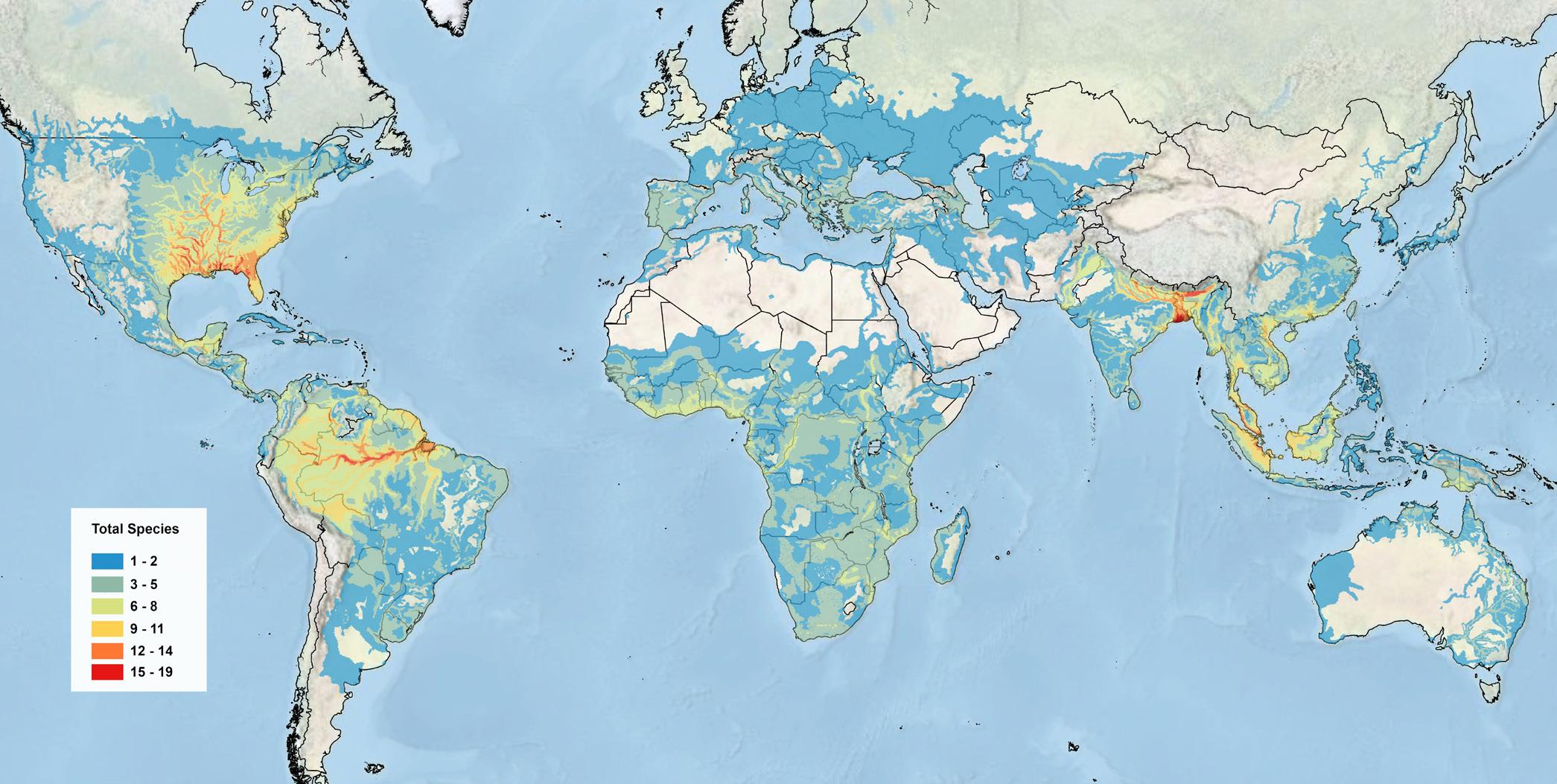
Global turtle and tortoise species richness map for all 352 extant tortoise and freshwater turtle species (not including the five extinct Indian Ocean species or the seven marine turtle species) as presented in the most recent Turtles of the World: Annotated Checklist and Atlas (10th Ed.) by the Turtle Taxonomy Working Group (TTWG 2025).
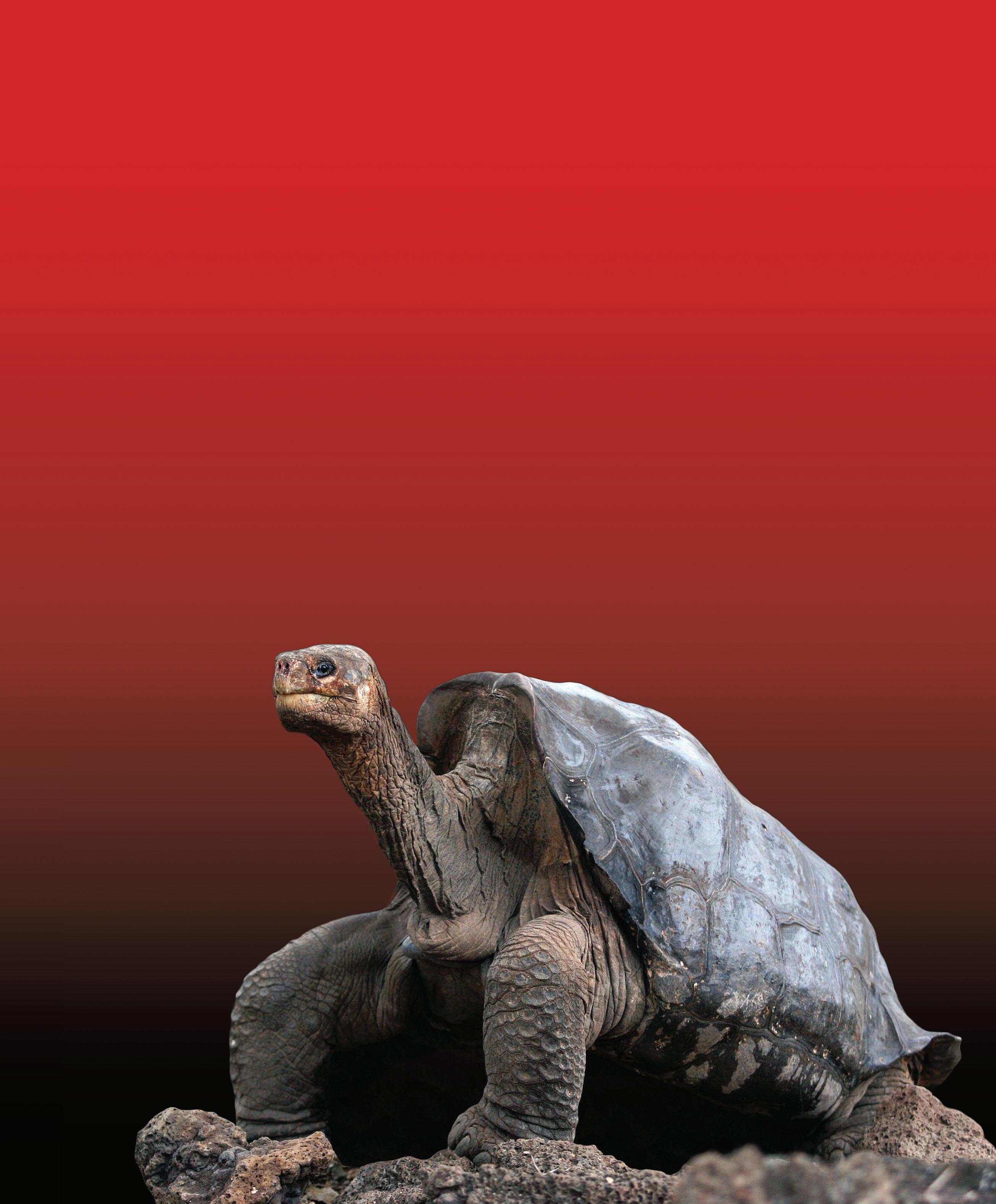
TURTLES IN TROUBLE:
The World’s Most Endangered Tortoises and Freshwater Turtles – 2025
The last Pinta Giant Tortoise, Chelonoidis niger abingdonii, went extinct on 24 June 2012. The Turtle Conservation Coalition is a group of organizations working to prevent any further turtle or tortoise extinctions.
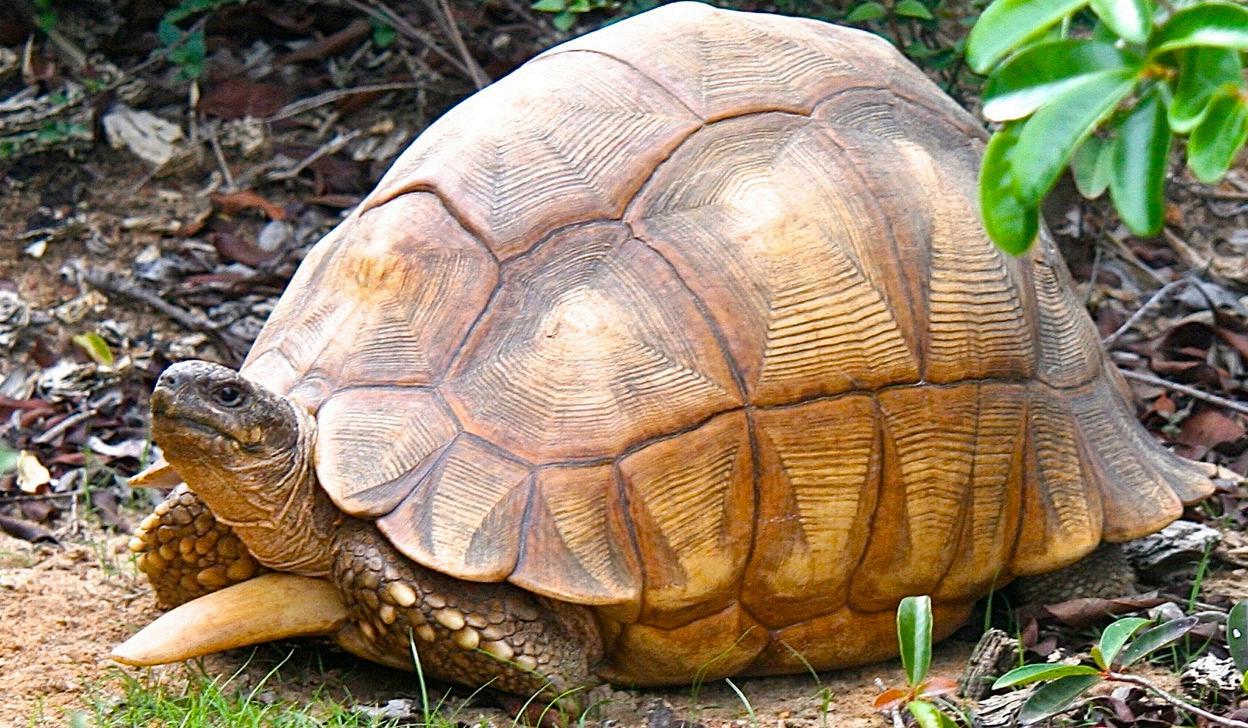
Ploughshare Tor T oise
Astrochelys yniphora (Vaillant 1885) Madagascar
The Ploughshare Tortoise, Astrochelys yniphora , may be the most critically endangered tortoise in the world. Males have an elongated plough-shaped projection extending from the front of the plastron used in combat with other males. The species is restricted to a single protected area, Baly Bay National Park, on the northwestern coast of Madagascar, establish in 1998 to protect this species. A captive breeding program was established at Ampijoroa in 1985 to produce and raise Ploughshare Tortoises for eventual reintroduction to the wild. The initial release target of 100 captive-bred and released tortoises was reached in 2015. The breeding center at Ampijoroa now holds more than 700 Ploughshares; the only conservation breeding groups outside Madagascar are in the Mascarene Islands and in California.
IUCN Red List: Critically Endangered
This species is extremely close to extinction in the wild; there are likely no more than a few dozen wild adults still remaining, with a semi-wild population of fewer than 100 animals kept under guard in a habitat exclosure in Baly Bay National Park. Pressure from illegal collecting and smuggling for the high-end pet trade is still intense, despite collaborative efforts by NGOs and governments in Madagascar and the main importing countries in East Asia.
Current efforts to save the Ploughshare Tortoise involve protecting the few remaining wild tortoises and those in the forest exclosure, mitigating the poaching threat, and establishing multiple assurance colonies for potential future reintroduction.
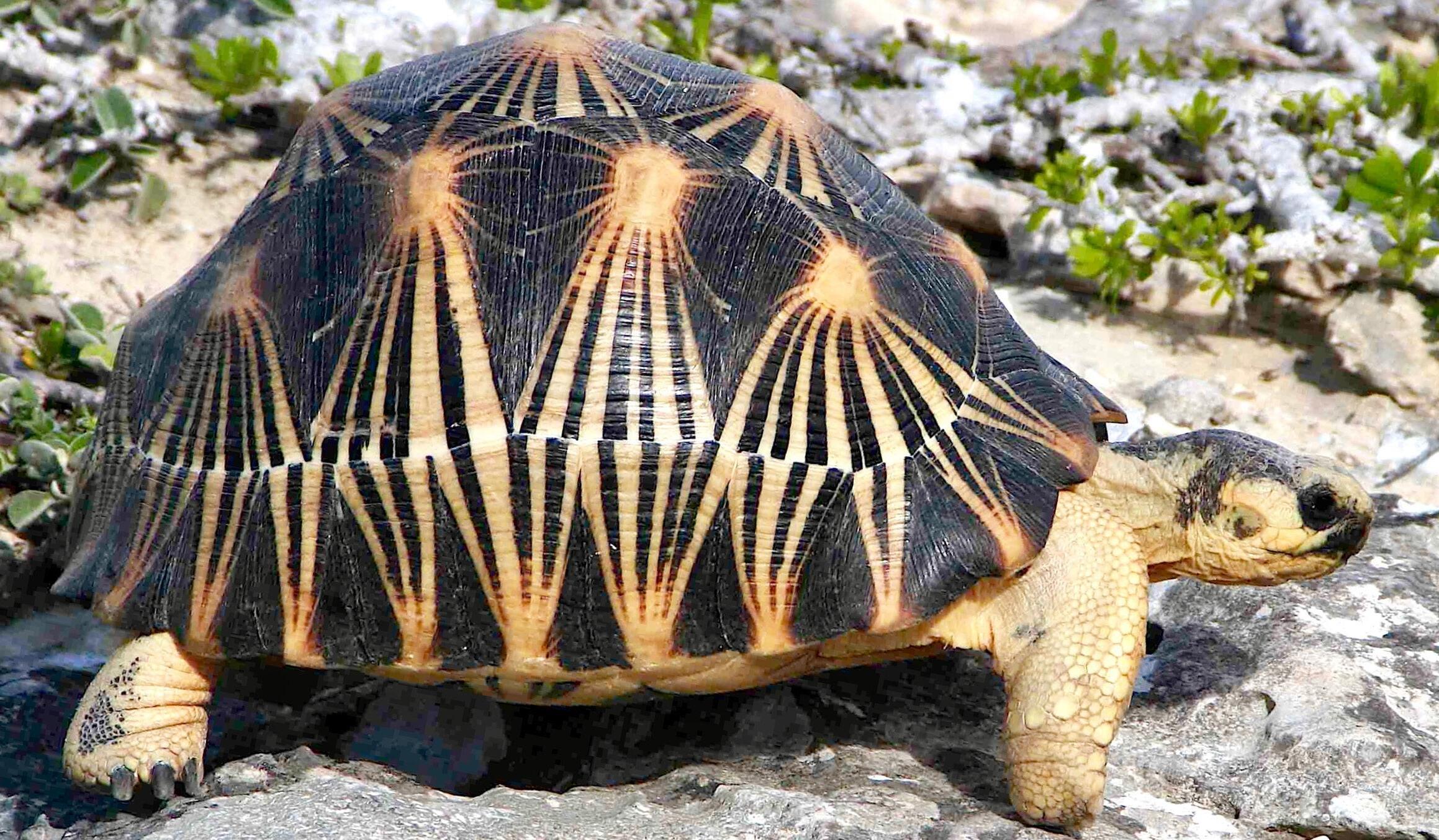
Radiated t oR toise
Astrochelys radiata (Shaw 1802) Madagascar
The Radiated Tortoise, Astrochelys radiata, is one of the world’s most beautiful—and threatened—tortoises on Earth. Once believed to be one of the most abundant tortoise species, occurring at extremely high densities in parts of southernmost Madagascar, it has disappeared from more than 65% of its native range, and its population is estimated to have declined by about 80%. Causes of this rapid rate of decline include habitat destruction for agriculture and charcoal production; however poaching of adults for bushmeat and local consumption, and the collection of smaller sizes classes for the illegal pet trade, is the leading threat pushing this species toward extinction. In less than two decades, Malagasy authorities have confiscated tens of thousands of
IUCN Red List: Critically Endangered
tortoises, and we are witnessing catastrophic declines and local extinctions across the species’ range. Widespread corruption and lack of anti-poaching enforcement, along with extreme poverty and a breakdown of traditional taboos against harming tortoises, are allowing poaching to increase in both scale and frequency. Local and international conservation organizations working in concert with governmental agencies are engaging communities across southern Madagascar to rescue confiscated animals and create community protected areas where rehabilitated tortoises can be returned to the wild. A large-scale reintroduction program is underway, and since 2021 over 5,000 tortoises have been repatriated in an effort to restore depleted populations.
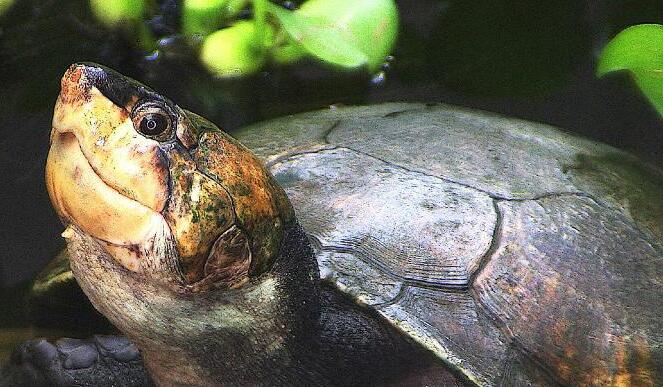
MadagascaN Big-headed t u R tle
Erymnochelys madagascariensis (Granidier 1867)
Madagascar
The Madagascan Big-headed Turtle, Erymnochelys madagascariensis, reaches 50 cm shell length and 17 kg and is the only paleotropical representative of the family Podocnemididae. Full-grown adults have large heads with strong temporal helmets, or casques. They are omnivorous, feeding on molluscs, fish, and amphibians seasonally as water levels rise and fall, as well as on aquatic vegetation, including fruits and seeds from trees and palms. Formerly widely distributed in western Madagascar’s west-flowing rivers and floodplain lakes, the current distribution of the species is extremely fragmented due to overexploitation. It can be found in seven protected areas in Madagascar: Ankarafantsika, Baly Bay, and Bemaraha National Parks, and the reserves of Manambolamaty, Ambondrobe, Menabe-Antimena, and Mahavavy-Kinkony. The species
IUCN Red List: Critically Endangered
is heavily collected for its much-desired meat, both for local subsistence and commercially. Increasing pressure from a rapidly growing human population and the trend in fishing habits towards the use of nets, which results in substantial bycatch of this species, as well as harvest of eggs and nesting females, is having dramatic deleterious effects on its populations. Survey data over the past three decades document an ongoing decline of the species. International conservation organizations, along with Madagascar authorities, manage a conservation program for the species, engaging local communities, protecting nests, and reintroducing head-started turtles at several sites. Close integration of local cultures and traditional natural resource management practices is a key to its success, and populations at Ankarafantsika are demonstrating some increase.
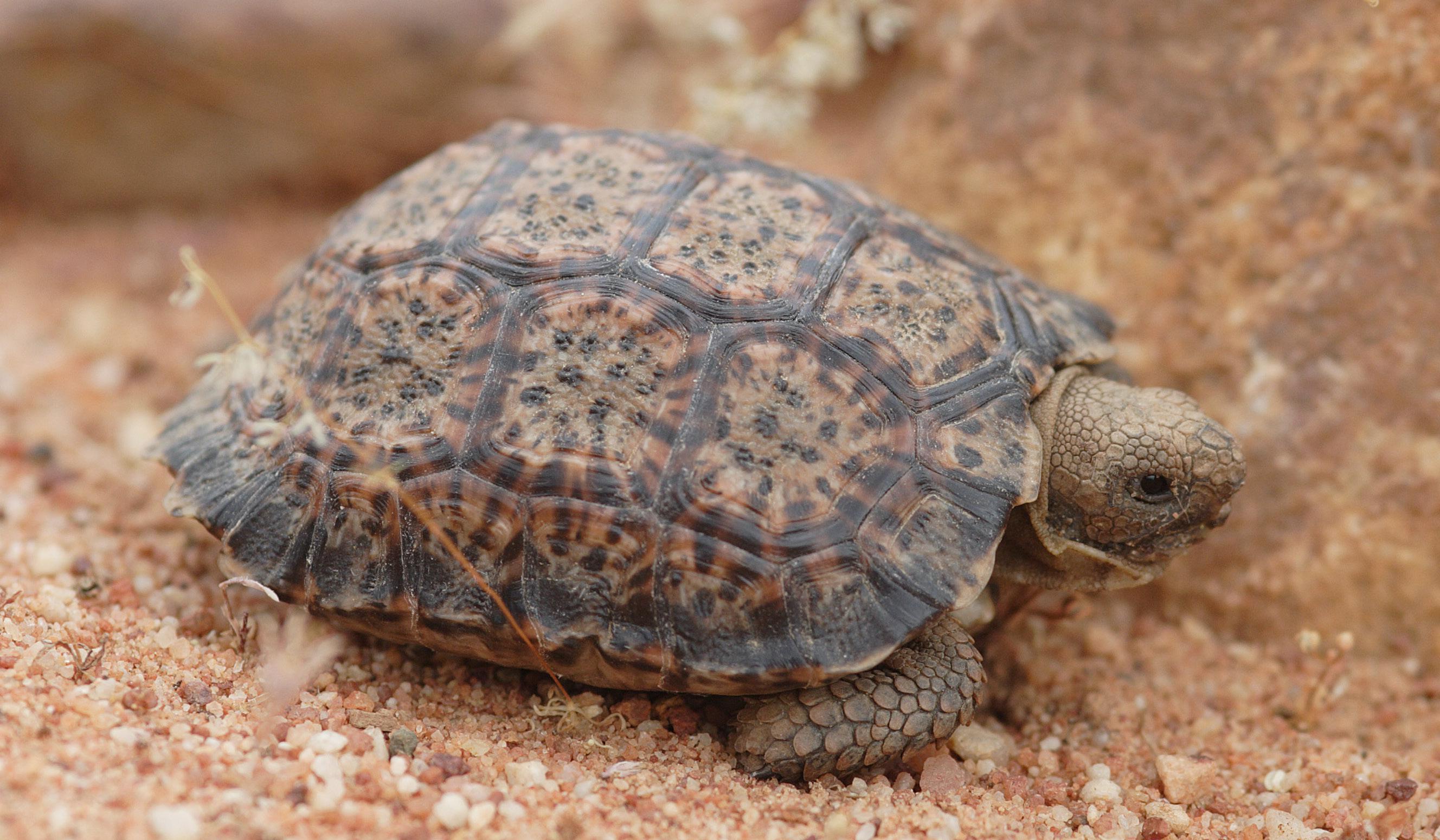
sPeckled
Chersobius signatus (Gmelin 1789)
South Africa
dwarf Tor T oise
The Speckled Dwarf Tortoise, Chersobius (previously Homopus) signatus, is the world’s smallest tortoise species. Average male and female shell lengths are 75 and 82 mm, respectively. It is a habitat specialist endemic to rocky hillslopes in northwest South Africa. Its habitat is arid (<150 mm annual rainfall) with most rains falling in winter. Consequently, activity of the tortoises coincides with the brief, massive flowering of annual and perennial plants in late winter and spring that the area is renowned for. From 2000 to 2015, studies on the species were conducted that covered most aspects of its ecology (e.g., health, behavior, thermoregulation, diet, body condition, growth, reproduction, home ranges, population dynamics). Remarkable characteristics of the species include its slow growth (>10 years to reach maturity, despite the small body size), sedentary
nature (home ranges <3,500 m2), its ability to shrink its shell when resources are scarce, and pelvic kinesis in females to pass eggs wider than pelvic width. Habitat degradation due to agriculture (livestock and crops in the north and south of their range, respectively) and habitat destruction (mines, housing, infrastructure) has fragmented the species’ population. Remnant local populations are threatened by increased drought as a result of climate change, crow predation, road mortality, and poaching. Some viable local populations may be present in protected areas, but these need confirmation, monitoring, and targeted conservation efforts. A small-scale conservation breeding program by European private keepers and zoos, under the auspices of Dwarf Tortoise Conservation, has been in place since 1995.
IUCN Red List: Endangered
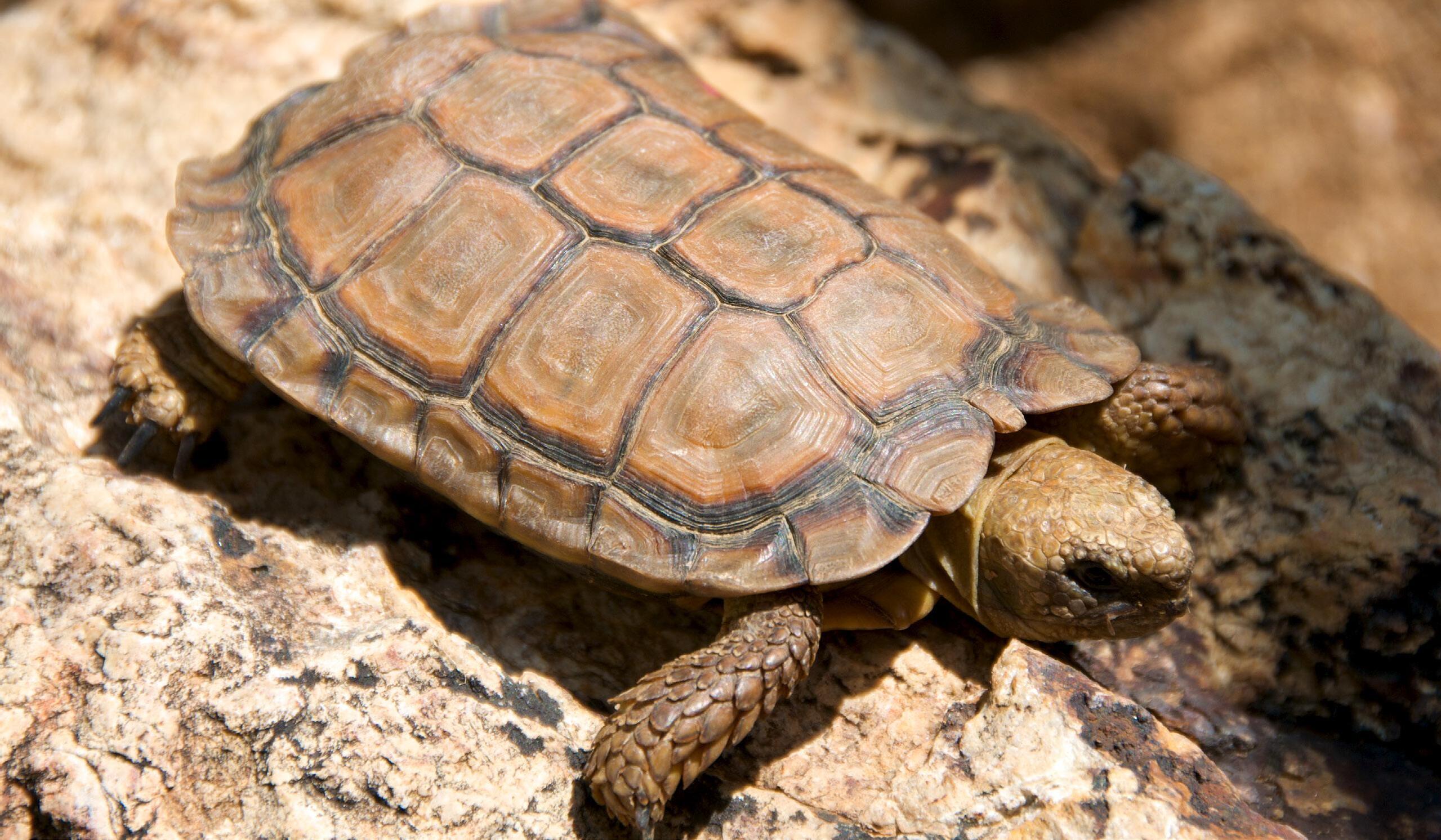
Nama PadloPer
Chersobius solus (Branch 2007) Namibia
The Nama Padloper, Chersobius (previously Homopus) solus, is a small (shell length to 110 mm), cryptic species endemic to southwestern Namibia and closely related to the Speckled Dwarf Tortoise (C. signatus) and Karoo Dwarf Tortoise (C. boulengeri) in adjacent South Africa. The Nama Padloper inhabits rocky outcrops in the hyper-arid Namib Fog Desert (annual rainfall 40-180 mm plus frequent ground fog) and ranges in scarce, isolated, and low-density populations from the Tiras Mountains up to 200 km from the Atlantic coast, and southward to the Orange River. It has also been occasionally recorded from near-coastal areas of the 26,000 km 2 Tsau Khaeb (Sperrgebiet) National Park. In this harsh environment, individual tortoises remain concealed most of the time and have a home range typically much less than one hectare. A
IUCN Red List: Vulnerable TFTSG Provisional Red List: Endangered
long history of domestic livestock overgrazing on large (now failed), pastoral farms within the species’ range, plus emerging climate change effects on drought frequency and intensity are thought to be significantly impacting the remaining tortoise populations. Other threats to tortoise habitat include pending, massive energy development schemes in this fragile desert ecosystem focused on newly discovered offshore oil deposits and the extraction of “green” hydrogen through the exploitation of abundant solar and wind resources in this region. A single, sustainably reproducing captive assurance colony of this species has been privately maintained in Windhoek for several decades, documenting valuable biological and husbandry information on this poorly known tortoise.
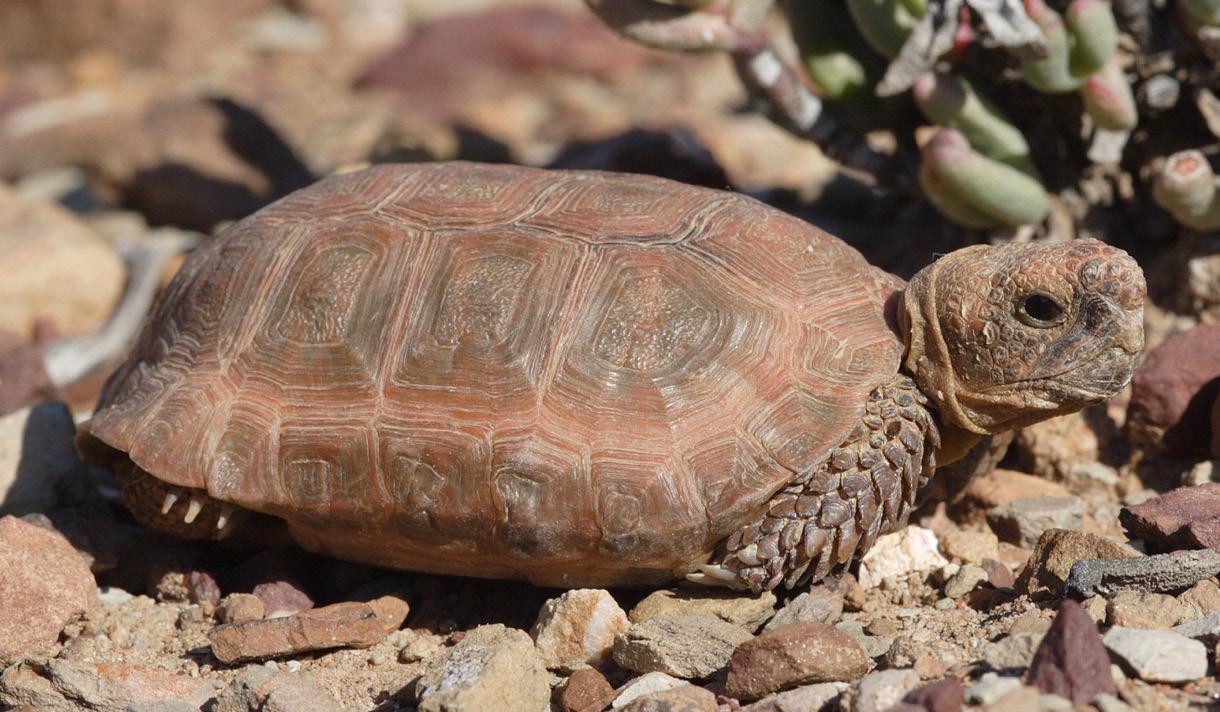
k aroo dwarf Tor T oise
Chersobius boulengeri (Duerden 1906)
South Africa
The Karoo Dwarf Tortoise, Chersobius (previously Homopus) boulengeri, is a small tortoise species (average male and female shell lengths 83 and 94 mm, respectively). It is a habitat specialist, endemic to arid (<200–400 mm of rain per year), rocky slopes in south-central South Africa, where most rains fall in summer. The tortoises are most abundant in exposed and eroded dolerite sills. Although their size and shape resemble Speckled Dwarf Tortoises (C. signatus), the species have very different ecologies. Various aspects of its ecology (e.g., behavior, thermoregulation, diet, reproduction, home ranges, habitat use, population dynamics) were studied between 2018 and 2022. Tortoises spend more than 90% of the daytime in retreats, even during the rainy and growth season, and use the radiant heat of rocks to thermoregulate. Their main diet consists of perennial
IUCN Red List: Endangered
dwarf shrubs, from which they disperse viable seeds. It appears to be the only tortoise with two distinct egg-laying seasons, autumn and spring. Although the species was once considered abundant, its population has declined severely as a result of habitat degradation (primarily due to overgrazing by livestock, especially during drought), population fragmentation, local extinctions driven by increased drought from climate change, and predation by crows, ravens, and baboons. Currently, only two viable local populations are known, despite multiple surveys conducted between 2005–2023. These populations need targeted conservation measures and monitoring, while surveys for other remnant populations should continue. A small-scale conservation breeding program by European private keepers and zoos (particularly Basel Zoo in Switzerland) was started in 2019.
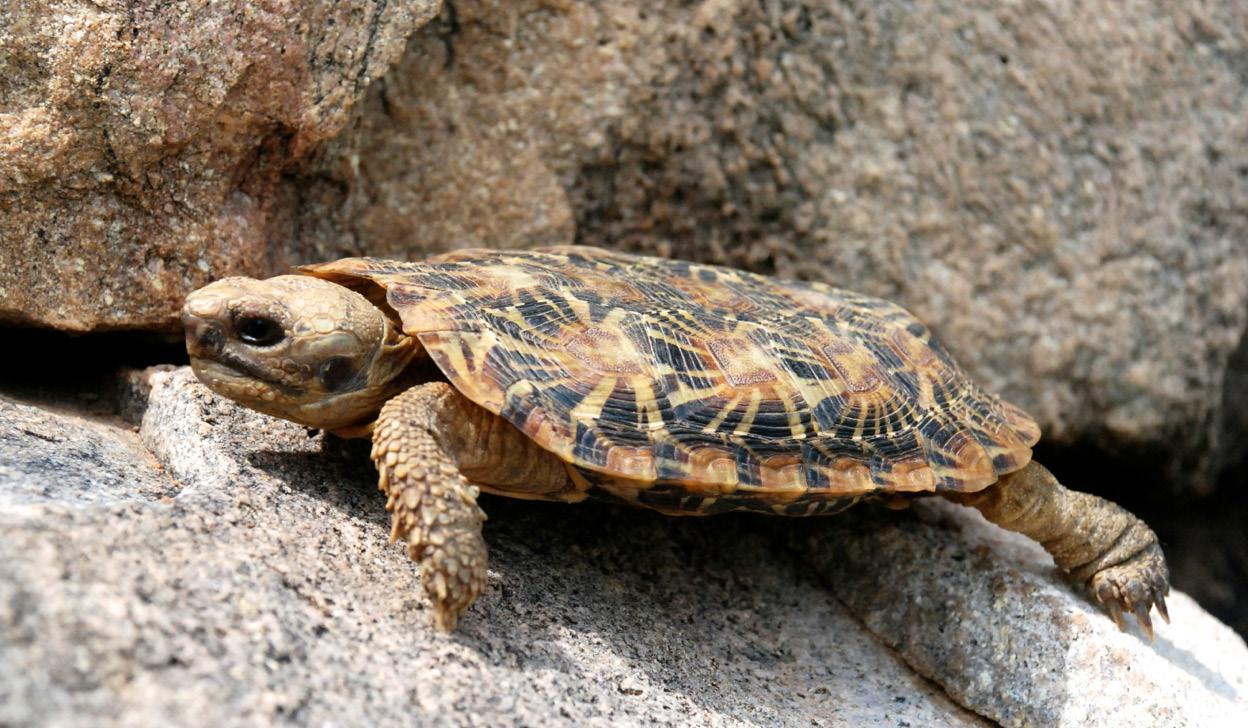
Pa Ncake T or T oise
Malacochersus tornieri (Siebenrock 1903) Kenya, Tanzania, Zambia
The Pancake Tortoise, Malacochersus tornieri, is a small species; adults are less than 20 cm in shell length and weigh a maximum of about 500 g. It has an unusual flexible dorso-ventrally flattened shell and inhabits rock crevices, where it wedges itself in. It is found in Precambrian granite kopjes, rocky hills, and rock outcrops in arid and semi-arid areas of southeastern, eastern, central, and northern Kenya, northern, eastern, and central Tanzania, and a small area of extreme northern Zambia. Pancake Tortoises are agile climbers and are very adroit at righting themselves. The combination of these unusual behaviors and its beautifully patterned shell has made it popular in the international pet trade. This species has an extremely low reproductive potential in the wild, only laying one or two eggs per year. By virtue of its strict habitat requirements, the limited and often fragmented habitat availability, and its low reproductive potential, this species
IUCN Red List: Critically Endangered
is highly vulnerable to local extinction when removed from its habitat for the pet trade. Unfortunately, before 2019, this species was heavily overexploited by the pet trade and its populations have been decimated in certain areas.
Other population threats include habitat loss (through slash-and-burn farming or cultivation) and micro-habitat destruction (rock breaking and extraction for construction ballast). It is these threats that have led to the species to be currently listed in the IUCN Red List of Threatened Species as Critically Endangered and in CITES Appendix I. The remaining population size and extant range of the Pancake Tortoise is currently not well known. However, the government of Kenya has recently developed and just published a national species recovery conservation action plan, so there is hope for increased conservation efforts directed at this unusual and critically endangered species.
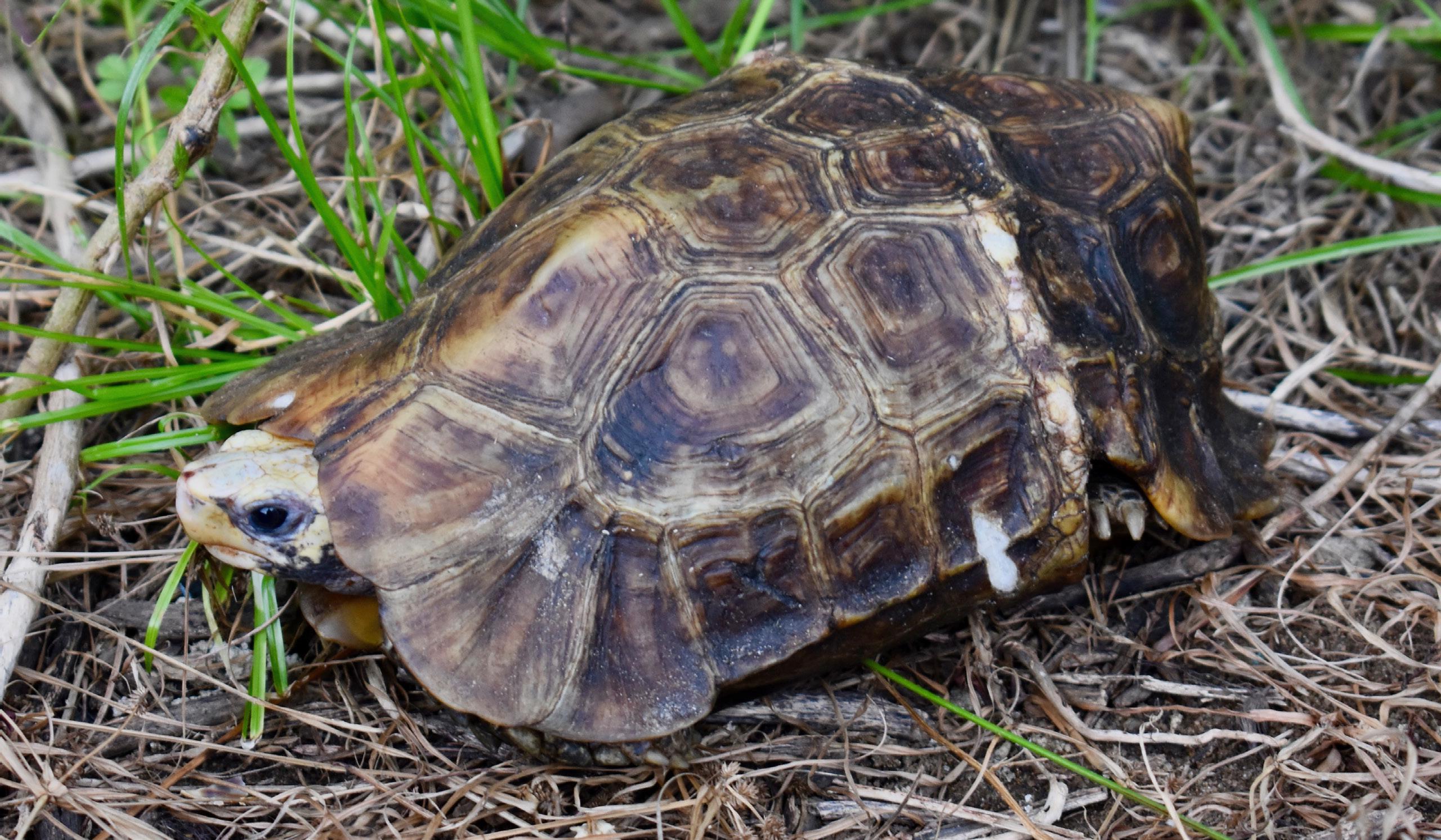
home’s h i Nge-Back Tor T oise
Kinixys homeana (Bell 1827)
Benin, Cameroon, Equatorial Guinea, Ghana, Ivory Coast, Liberia, Nigeria, Togo
Home’s Hinge-back Tortoise , Kinixys homeana, is limited to the rainforests, especially coastal ones, of West Africa from Liberia to western Cameroon. Nigeria and Cote d’Ivoire (Ivory Coast) are the two countries where it is still somewhat common and reasonably widespread, whereas the species has been nearly extirpated from Ghana, Benin, and Togo. In Togo, it still survives in a few isolated forests in the hilly region bordering Ghana. Field studies have demonstrated that the density of this species tends to decrease from east (Nigeria) to west (Liberia), although there are still good populations in western Côte d’Ivoire. On the contrary, the density of the ecologically similar Forest Hinge-back Tortoise, K. erosa , tends to increase from east to west, suggesting that the two species may be subject to interspecific competition when in sympatry.
IUCN Red List: Critically Endangered
Home’s Hinge-back Tortoise is a species with a very specialized ecology, limited to shady and very humid forests. It has an omnivorous diet in which mushrooms, invertebrates, and carrion represent the majority of the diet. During the rainy season, males often let themselves be carried by the floodwaters of swamps and streams to disperse in search of females. The species has declined sharply over the last twenty years due to the extreme deforestation underway in West Africa, and the harvesting of adults by local people for subsistence purposes. The species inhabits the same microhabitats as snails of the Achatina genus, and is therefore collected together with them and sold in local bushmeat markets. The distribution of the tortoise is now highly fragmented, and even in protected areas it tends to inhabit only small patches of optimal habitat.
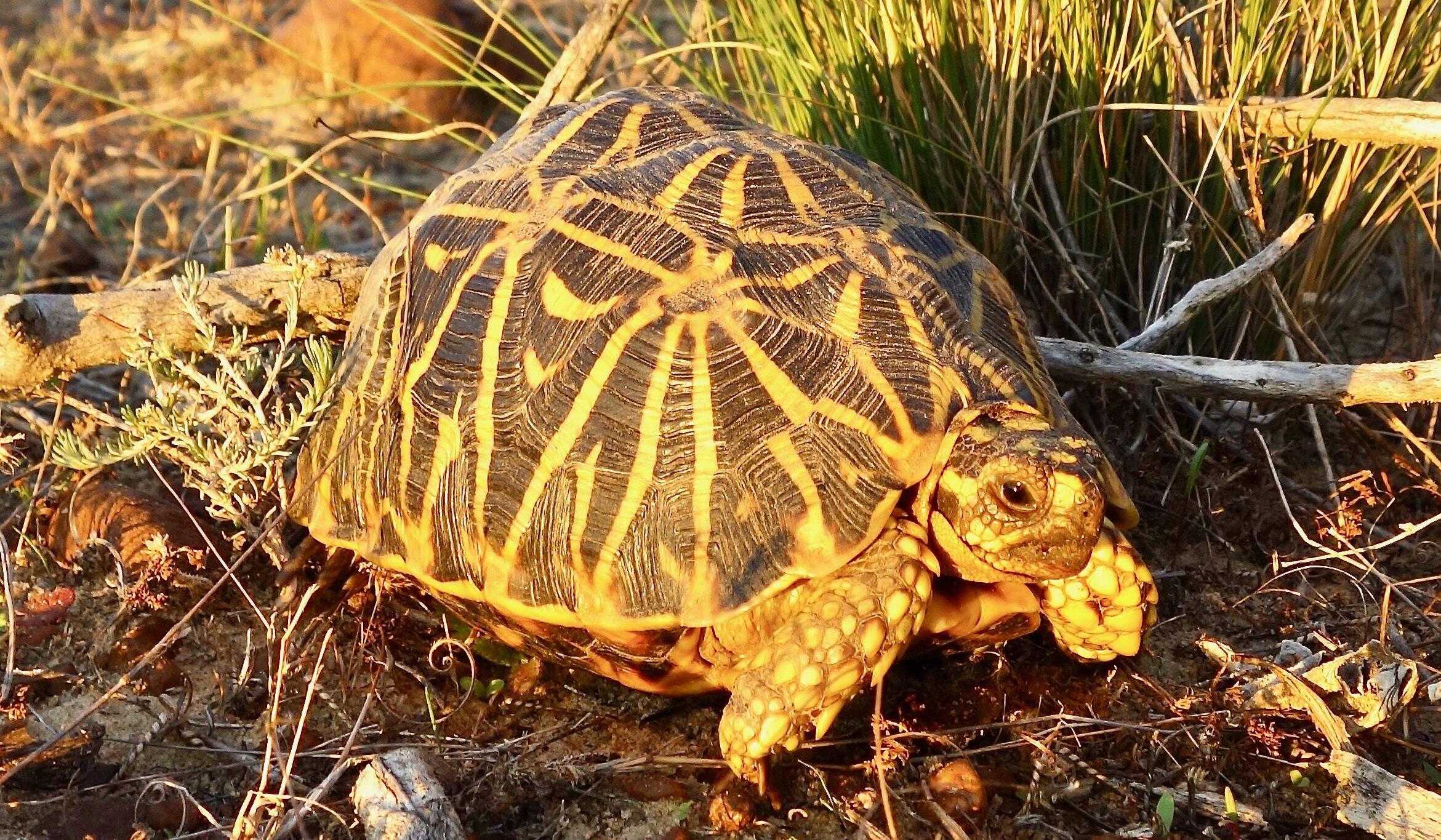
geome T ric T or T oise
Psammobates geometricus (Linnaeus 1758)
South Africa
The Geometric Tortoise, Psammobates geometricus, is endemic to a small area of the Western Cape Province of South Africa. It is an attractive, small (12–15 cm shell length) species, restricted to the unique and botanically diverse Alluvium Fynbos/Shale Renosterveld shrubland, forming part of the Greater Cape Floristic Region. This ecosystem is naturally fire-adapted to the region’s hot, summer-dry, Mediterranean-type climate with winter rainfall varying between 350–600 mm annually. It is one of the most critically endangered tortoise species, with a wild population estimated at fewer than 1,000 individuals, and is a top National and Provincial (CapeNature) conservation priority. The species’ distribution is now limited to a tiny fraction of its historic range from sea level to 600 m altitude, as more than 90% of its habitat has been lost over the last three centuries to urbanization around Cape Town and agricultural transformation of the surrounding
IUCN Red List: Critically Endangered
Cape lowlands and adjacent Breede and Ceres Valleys. Approximately 400 km2 of its historical distribution range remains, and most of this habitat only survives as small, isolated patches on private farms that cannot support significant tortoise numbers. The remaining, potentially sustainable tortoise populations largely survive on three nature reserves (about 2,000 ha) managed by a consortium of local and international conservation organizations, including the Southern African Tortoise Conservation Trust, the Mapula Trust, and CapeNature. These nature reserves have suffered from increasing wildfires as rapid local climate change is increasing summer temperatures and altering seasonal precipitation patterns. Subsidized predators in nearby agricultural and urban areas, including crows and ravens, target juvenile tortoises. Head-starting programs have now been implemented to reverse fire and predator losses and augment populations.
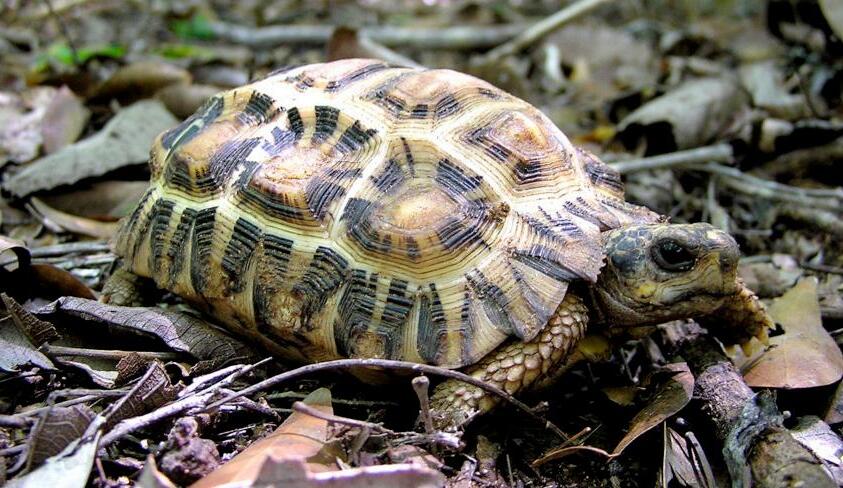
flaT - T ailed Tor T oise
The Flat-tailed Tortoise, Pyxis planicauda , is found only in a limited area of dry deciduous forest in the coastal lowlands of western Madagascar known as the Menabe region. Noted for having a distinctly flat tail, this species has a low reproductive rate and is severely threatened by habitat loss and previous over-collection for the international pet trade. Since being placed on CITES Appendix I in 2002, legal exploitation for the pet trade ceased and its severe population decline was halted. Local people do not consume or harm the tortoises, which are only active during the hot wet season from November/December to March/April and remain hidden under leaf litter and dormant for the rest of the year. Because of this sedentary lifestyle, this species adapts poorly to captive conditions, and has a history of poor captive survivorship. Only a few institutions
and private breeders outside Madagascar manage to breed this species, but it reproduces regularly in Durrell Wildlife Conservation Trust’s tortoise breeding facility in northwestern Madagascar. While slash and burn agriculture has long been a threat to this species, in the winter of 2021 massive, wholesale burning by drought-displaced people from southern Madagascar destroyed vast swaths of habitat in the Menabe-Antimena Protected Area, a crisis that mobilized the global conservation community. Conservation measures focus on better protecting this unique ecosystem, which supports other Malagasy endemic species. Though viable wild populations were greatly reduced by the recent fires, enforcement efforts to protect these vulnerable forests have improved, in particular in the Kirindy Forest, where a small population of the species survives.
Pyxis planicauda (Grandidier 1867) Madagascar
IUCN Red List: Critically Endangered
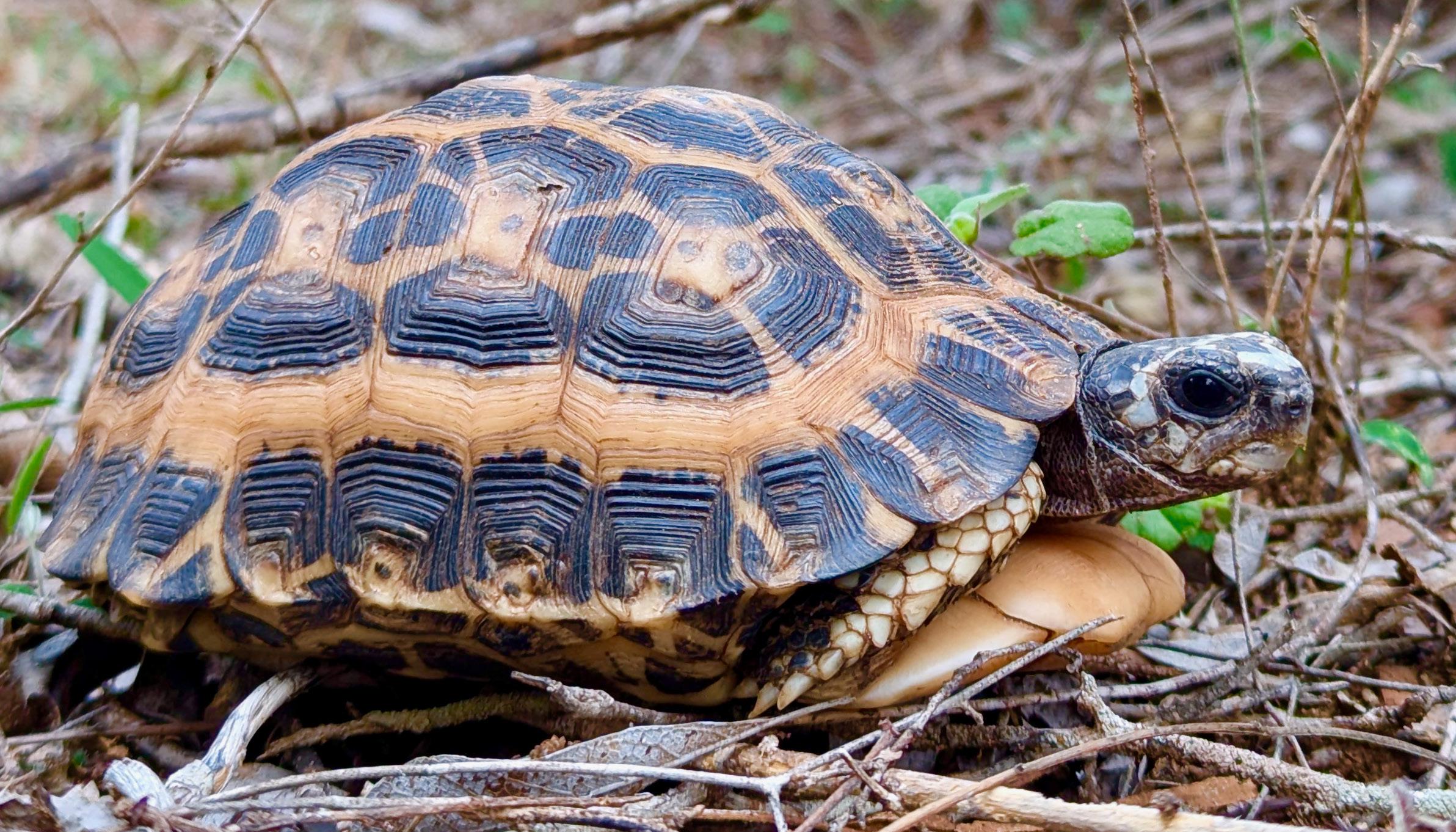
The Spider Tortoise, Pyxis arachnoides , is one of the smallest tortoise species in the world and the smallest tortoise endemic to Madagascar. This species lives in the spiny forest of southern Madagascar, in some of the same habitats as the Radiated Tortoise ( Astrochelys radiata).
Spider Tortoises are variable in color and pattern but are usually dark brown with an array of converging yellow streaks on the shell, from which they get their name. Their populations are highly fragmented and all occur in low densities, though individuals of this species occupy surprisingly large home ranges for such a small chelonian. There are currently three subspecies recognized, which some experts feel war-
rant being split into three separate species. All are in demand in the illegal pet trade.
Threats to the Spider Tortoise include habitat conversion to cattle pastures, illegal collection and export for the pet trade, and depredation by wild dogs.
These threats, combined with the species’ low reproductive output, have extirpated it from many historical areas. Poaching persists despite laws to protect the species. The most recent population surveys have shown widespread declines and have identified a few remaining populations. Working closely with local communities may help mitigate the threat posed by illegal collection.
Pyxis arachnoides ( Bell 1827) Madagascar
IUCN Red List: Critically Endangered
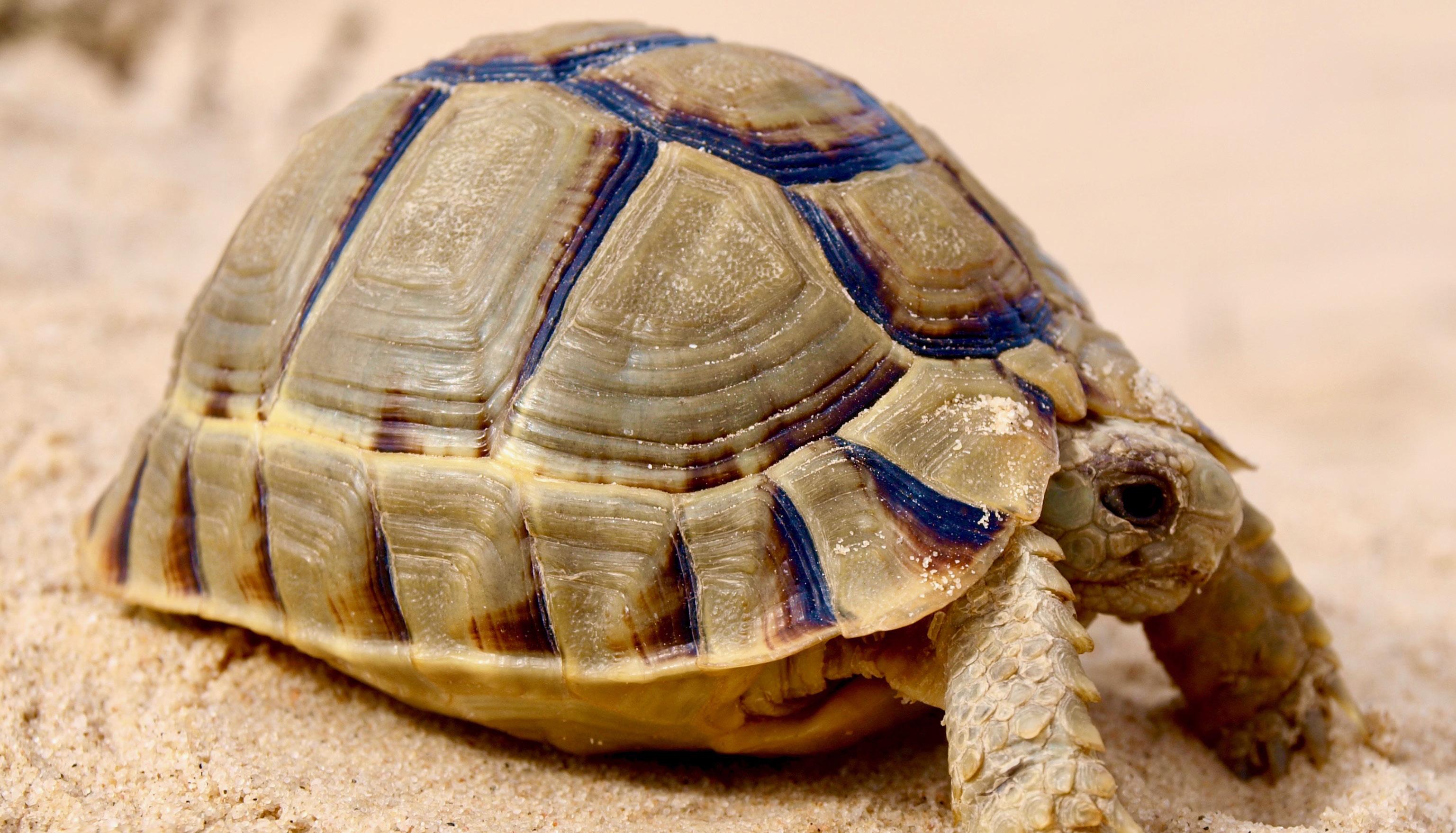
e gy PT ia N Tor T oise
Testudo kleinmanni Lortet 1883 Egypt, Israel, Libya
The Egyptian Tortoise, Testudo kleinmanni, is the smallest and most endangered tortoise of the Mediterranean basin. Being so small and “cute,” people have found them irresistible, and they have been collected heavily for the pet trade. The majority of captive pet animals died, and wild populations have crashed. Now, the few remaining populations are threatened by coastal urban development, as the southern Mediterranean coast is prime real estate. In recent years, captive husbandry techniques have improved, and the species is now successfully bred in captivity. A long-term population study at the Zaranik Protected Area in Sinai, Egypt, conducted by local and international conservationists provides some hope for the wild populations.
IUCN Red List: Critically Endangered
While some populations have high extinction probabilities, some very small populations, less than 25, are projected to be viable. The key to the viability of these few small populations is high adult female survival, periodic years of high rainfall to offset drought, no additional habitat loss, and no human-caused mortality. This suggests that the key to protecting the Egyptian Tortoise is local conservation initiatives. Despite some small populations being viable, they will remain critically endangered in the foreseeable future due to low recruitment and a lack of substantial population growth. This means that the Egyptian Tortoise will require ongoing human support if there is any hope of protecting the species.
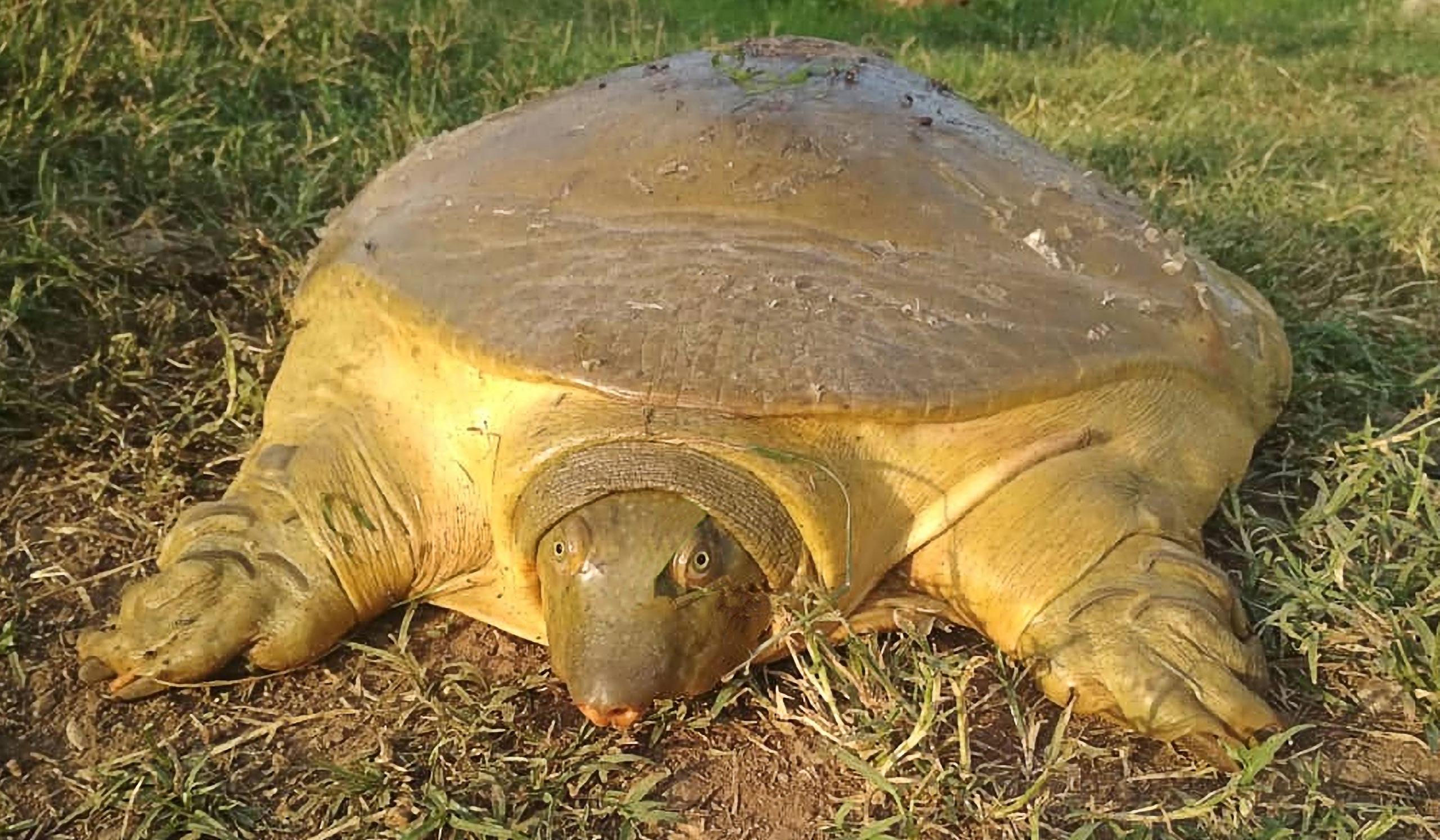
Nu Bia N f la P shell T ur T le
Cyclanorbis elegans (Gray 1869) South Sudan, Uganda
The Nubian Flapshell Turtle , Cyclanorbis elegans, is the largest and most endangered freshwater turtle species on the African continent. Once widely distributed from Ghana to South Sudan along the main rivers crossing the dry savannas of the continent, the species now appears to be extirpated nearly everywhere except for South Sudan and northern Uganda. It is hypothesized that its reproductive habits, specifically, nesting-site fidelity, with several females ovipositing eggs on the same beaches year after year, have facilitated the collection of eggs and the killing of adults for subsistence nearly everywhere within its former range. However, after decades of no records from the wild,
IUCN Red List: Critically Endangered
it was recently rediscovered in 2017 along the White Nile in South Sudan, and in 2021, a previously unknown population was discovered in the far north of Uganda. The species is hunted for food by local people and is also exported to China by the local Chinese expatriate community. Moreover, it is highly threatened by overharvesting and environmental devastation due to the presence of large settlements of refugees fleeing the various regional conflicts, causing increased threats to the few remaining populations. These regional refugee camps are located near the few known areas of occurrence of the species, and makes the species’ continued survival tenuous in the coming decades.
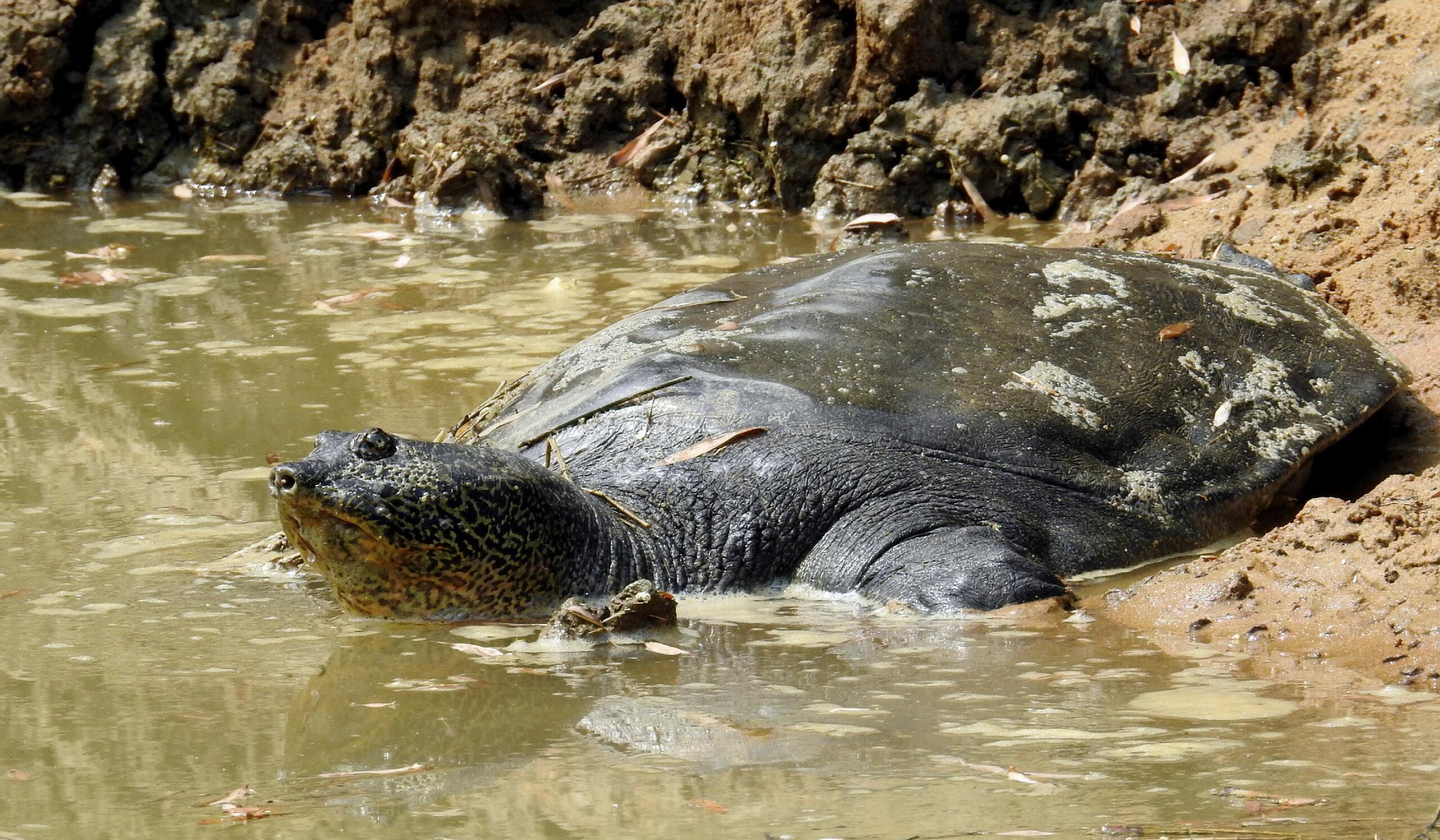
Rafetus swinhoei (Gray 1873) China, Vietnam
Probably the largest freshwater turtle in the world, reaching 120 kg, the Red River (or Yangtze) Giant Softshell Turtle, Rafetus swinhoei , is currently only known from the Red River drainage in China and Vietnam. It was formerly also known from the lower Yangtze River floodplain in China, from which it is now extirpated. Capture for consumption, river damming, wetland destruction, and water pollution have reduced the global population to likely just a few individuals, including a few adults spotted occasionally and one photographed with a floating camera trap in a small impoundment north of Hanoi (along the Red River course), and an old captive impotent male from the former Yangtze River subpopulation residing in Chi-
IUCN Red List: Critically Endangered
na in Suzhou Zoo. His previously potential zoo mate, an over 80-year-old female, died in 2019. The only other confirmed wild female died in Vietnam in 2023. Recent intensive surveys in Vietnam have suggested that a few additional specimens are likely to exist in the wild, in at least one lake along the Red River and at a few sites along the Da River, including near the border between Vietnam and Laos. Several local fishermen and former professional Rafetus hunters claim that juveniles (locally called “flower turtles”) are still found occasionally along one riverine area. It is very likely that the species is highly secretive and, while officially Critically Endangered, perhaps slightly less on the brink of extinction in Vietnam than previously feared.
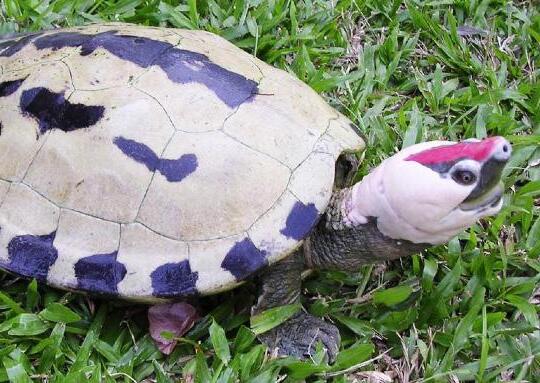
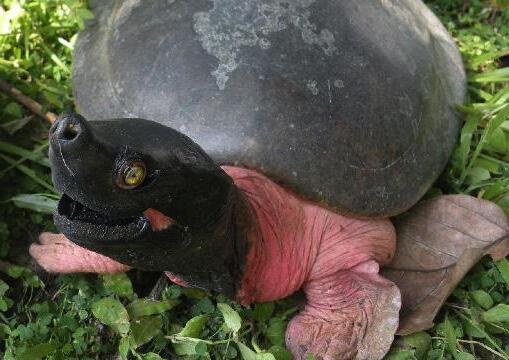
Critically Endangered northern r iver t erra Pin
Brunei, Indonesia, Malaysia, Thailand
a unique and beautiful freshwater turtle that was abundant across its wide distribution some decades ago. Tens to hundreds of nests could be found in one night during the nesting season at that time. However, since the 1990s, the wild population has plummeted by more than 70 percent.
Unsustainable levels of egg harvesting for consumption and sale in local markets and poaching of adults in the 1990s and later were the main causes of population decline and loss. Deforestation of riverbanks for agriculture and ponds caused the loss of riparian vegetation which is needed by the species.
A conservation plan has been implemented in Malaysia comprising egg rescue and the establishment of Terrapin Conservation Centers since the 1960s. The species has been legally protected in Indonesia since 2018. Conservation work has focused on Sumatra, especially in the provinces of Aceh Tamiang and Langkat, strongholds for remnant populations. Egg protection, head-starting and wild-release, confiscations, and community outreach and empowerment through sustainable mangrove management are carried out by the local SatuCita Foundation together with the Agency of Conservation of Natural Resources. The results of post-release monitoring indicate survivorship and there is optimism in Aceh Tamiang. If further overharvesting can be controlled, the prospect of recovery for this species is bright.
Batagur baska (Gray 1830) Bangladesh, India, Myanmar
IUCN Red
extinct in the wild. The species has suffered steep declines due to nesting habitat loss and over-harvesting of adults and eggs. No recent nesting has been reported in the Sunderbans of India and Bangladesh, but the occurrence of a few wild juveniles suggests that some breeding still occurs. Currently fewer than 100 adults are known from six different captive locations. Turtle teams are working to bring this species back from the brink. Indian efforts are guided by a 10-year Species Recovery Vision plan. An assurance colony of 456 adults and juveniles has been established in the Indian Sunderbans, with the release of 20 tagged subadults. The project in Bangladesh maintains a colony of 22 founders and 543 juveniles, with recent release and monitoring of 92 individuals. With mature females ready for nesting, this project aims to expand the scope of recovery. Ex-situ conservation breeding programs have been set up at Madras Crocodile Bank Trust and internationally.
The Red-crowned Roofed Turtle, Batagur kachuga (see photo in introduction), is a beautiful species extirpated from most of the Indo-Gangetic Plain, except along a short section of the Chambal River, India, where about 500 adults survive in the National Chambal Sanctuary. A nest protection program with head-starting, monitoring, and community outreach is ongoing.
The Painted Turtle, Batagur borneoensis, is
Batagur borneoensis (Schlegel & Müller 1845)
IUCN Red List: Critically Endangered Painted t erra Pin
The Northern River Terrapin, Batagur baska, is likely functionally
List:
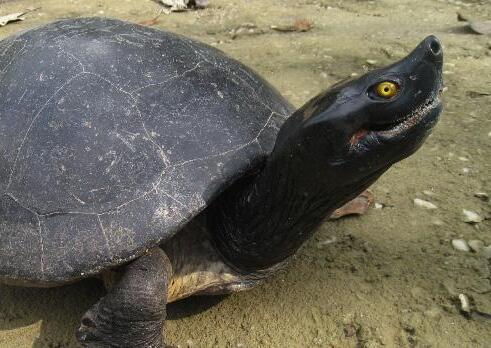
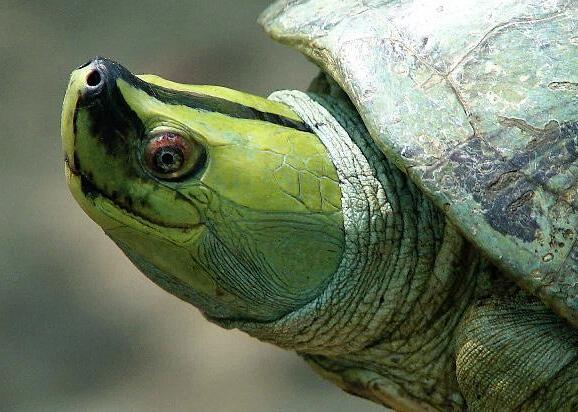
Batagur affinis (Gray 1830) Cambodia, Malaysia
IUCN Red List: Critically Endangered Southern r iver t erra Pin
The Southern River Terrapin, Batagur affinis, inhabits large freshwater rivers along the coastal areas and is classified as two distinct subspecies: B. a. affinis in western Peninsular Malaysia and Indonesia, and B. a. edwardmolli in eastern Peninsular Malaysia and Cambodia. The species was thought to be extinct in Cambodia until a small population was rediscovered in the Sre Ambel River in 2001. The species has been extirpated from Indonesia, Vietnam, Singapore, and Thailand, while both subspecies still occur in Malaysia. Large and small-scale sand mining, dam construction, riparian forest degradation, and accidental and purposeful captures for consumption and pet trade have sharply exacerbated this species’ decline.
Intensive conservation efforts are ongoing in both Cambodia and Malaysia to restore viable wild populations. Conservation interventions in both countries include nest protection programs, captive assurance colonies, head-starting, and the reintroduction of head-started individuals. Other conservation initiatives include education and outreach activities, law enforcement, livelihood development for local villagers, policy advocacy, and habitat management plans.
Burme S e roofed t urtle
Batagur trivittata (Duméril & Bibron 1835)
Myanmar
IUCN Red List: Critically Endangered
Myanmar, where it was once common. Populations declined as a result of chronic egg-harvesting over more than 100 years and loss of adults entangled in fishing gear. By the late 1990s the species was feared extinct. In 2001, two small remnant populations were rediscovered in the Dokhtawady and Chindwin Rivers; the Dokhtawady population was driven to extinction shortly thereafter when a newly constructed hydropower reservoir inundated critical nesting habitat and facilitated an influx of migratory fishers. In 2005, the Myanmar Forest Department, in collaboration with international conservation organizations, began protecting nesting sandbanks along the Chindwin River, incubating eggs at a secure site, and head-starting hatchlings. Additionally, six assurance colonies have been established—five in Myanmar and one in Singapore—that house 340 breeding adults. The assurance colonies in Myanmar produce 200–250 hatchlings each year; successful reproduction has yet to occur in the Singapore colony. Currently, well over 2,000 B. trivittata reside in assurance colonies, and almost 800 offspring are being head-started for release. To date, eight releases of 217 head-started turtles have been conducted in the Chindwin River. The recent ongoing civil war in Myanmar poses a serious threat to the continued recovery of this impressive and beautiful species.
The Burmese Roofed Turtle, Batagur trivittata, is endemic to rivers of
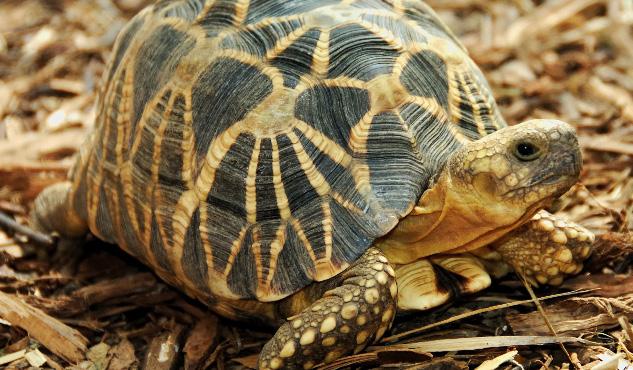
Burmese sT ar Tor T oise
The Burmese Star Tortoise, Geochelone platynota, is a rare species endemic to the Central Dry Zone of Myanmar, a desert-like region in the rain shadow of the western mountains. Within the Dry Zone, the species occur in variety of habitats, including thorn-scrub, dry deciduous forest, bamboo, grasslands, and agricultural fields. Long exploited by rural Burmese for food, wild populations were decimated in the mid-1990s by overharvesting to meet the burgeoning demand from wildlife markets in southern China, where the tortoises were sold for food and incorporated into traditional Chinese medicines. Subsequently, the species became highly prized in the international pet trade and by the early 2000s was ecologically extinct in the wild. Three in-country assurance colonies now house approximately 800
breeding adults that annually produce 1,000 to 2,000 hatchlings for head-starting and eventual release. A National Action Plan published in 2012 resolved to return the species to every protected area within its historical range. Progress was made towards achieving this objective with the release of 2,800 captive-bred, head-started tortoises into two wildlife sanctuaries. Successful reproduction by translocated females has since been documented in both protected areas. Theft from assurance colonies and poaching of translocated tortoises remain serious threats to the recovery of wild populations. Myanmar’s ongoing civil war (2021 to present) now jeopardizes previous conservation successes and the future prospects for recovering the Burmese Star Tortoise are uncertain.
Geochelone platynota (Blyth 1863) Myanmar
IUCN Red List: Critically Endangered
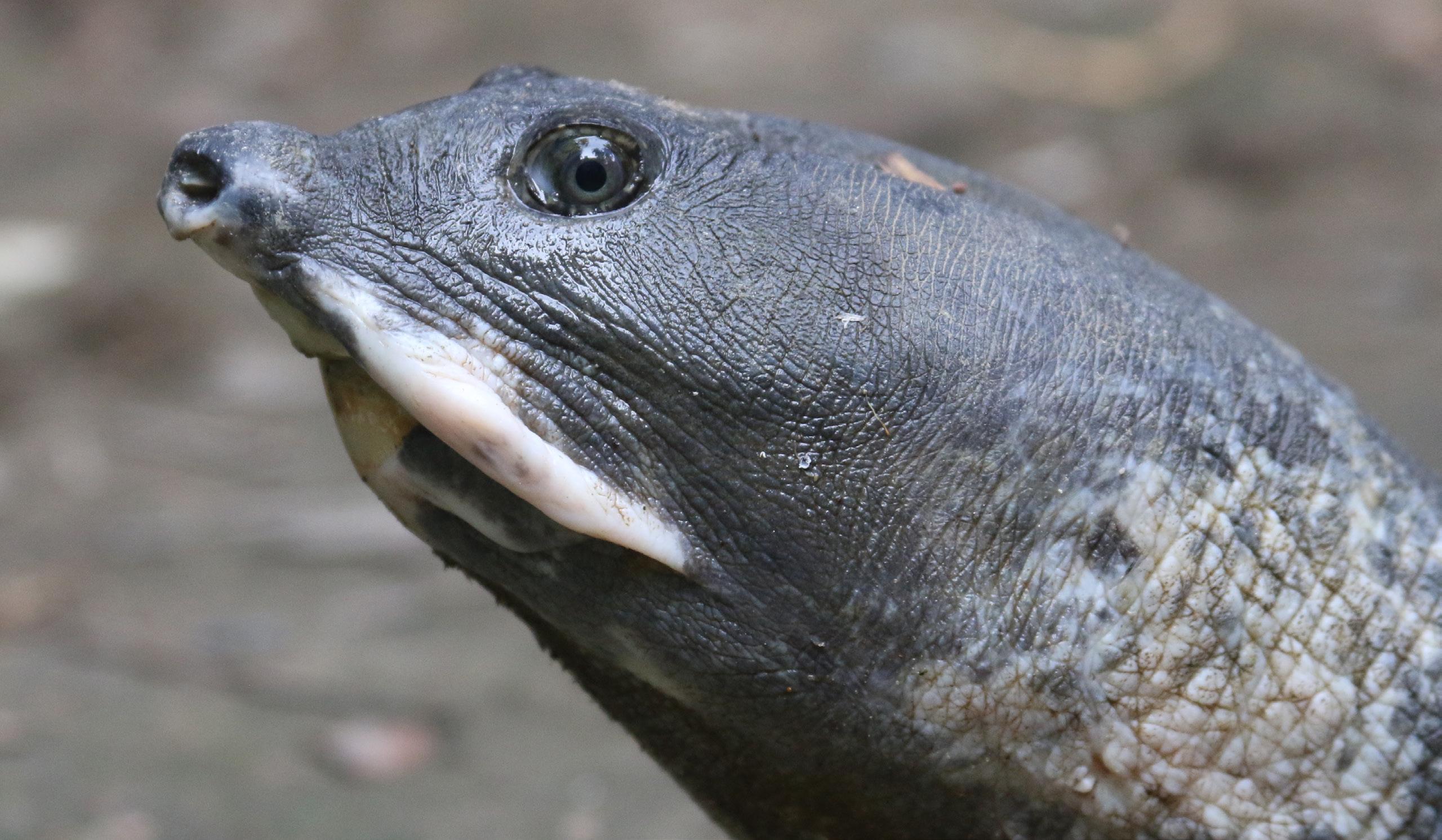
Black s of T shell Tur T le
Nilssonia nigricans (Anderson 1875) Bangladesh, India, Nepal
The Black Softshell Turtle or Bostami Turtle, Nilssonia nigricans, was long believed to be a species uniquely inhabiting a single temple pond in Bangladesh. Only with a better understanding of the species’ morphological changes from juvenile to old adult, combined with surveys of numerous temple ponds in Bangladesh and northeastern India, was it realized that the species occurs more widely and survives in the wild in the Brahmaputra, Meghna, and Karnaphuli river basins, as well as the 2022 discovery of a population in the Betana Wetland of southern Nepal. Bostami Turtles are large softshells, potentially reaching 78–91 cm shell length and body mass up to 57 kg.
While the individuals residing in temple ponds are securely protected, they unfortunately have little or no opportunity to reproduce, unless humans evacuate eggs or hatchlings for headstarting and release in suitable wetlands.
The remaining wild animals continue to be under threat from targeted hunting, fisheries bycatch, and environmental degradation, with fishermen reporting its populations in decline across its range. While strictly protected by national legislation and a CITES ban on commercial trade, enforcement of these protective regulations remains inadequate. Similarly, while it inhabits a number of protected areas in the Brahmaputra lowlands, fishing activities continue inside these areas and continue to impact softshell turtle populations. Priority conservation actions therefore are improved engagement between protected area managers and local fishing and hunting communities to agree to return any softshells unharmed to the rivers, and stricter enforcement where exploitation and trade continue. The collection of eggs from temple ponds for headstarting and release across the natural range should be increased where possible.
IUCN Red List: Critically Endangered
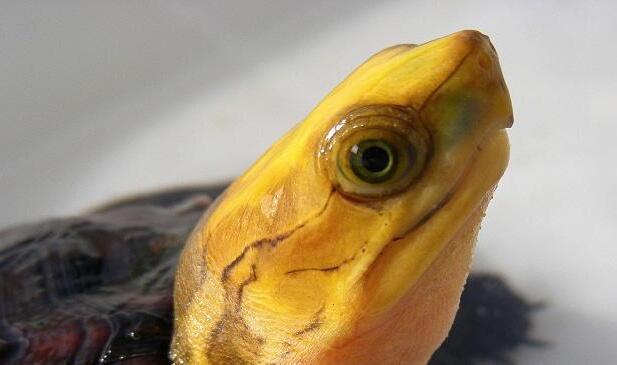
Golden-headed Box t urtle
Cuora aurocapitata
Luo & Zong 1988 China
IUCN Red List: Critically Endangered
The Golden-headed Box Turtle , Cuora aurocapitata, is a highly aquatic Asian box turtle. Males are smaller than females, have a flatter shell and a longer, thicker tail. In 2017, the species was split into two subspecies: C. a. aurocapitata from southern Anhui, and the newly described C. a. dabieshani from central Anhui. The species’ original scientific description in 1988, based on specimens obtained from markets, triggered its decline. While local villagers had collected and consumed this species for centuries, the pet and medicinal trades quickly became interested in its striking golden-headed appearance, leading to unsustainable collection from the wild. By the late 1990s, the species was nearly extinct due to overcollecting, pollution, and habitat destruction. It was not until 2004 that scientists discovered the species in the wild.
The species’ habitat continues to face threats from sand mining, river regulation, hydroelectric dams, and harmful fishing practices, such as poison and dynamite fishing. No new specimens have been recorded since 2013. The captive population is estimated at about 800. Hybridization of the two subspecies unfortunately occurs frequently and poses a threat to assurance colonies. Potential future release projects are hindered by the lack of suitable existing intact habitat.
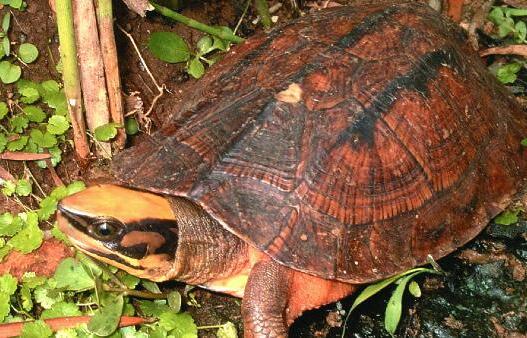
Chine S e t hree- S tri Ped Box t urtle
Cuora trifasicata (Bell 1825) China
IUCN Red List: Critically Endangered
The Chinese Three-striped Box Turtle, Cuora trifasciata, is sought after in Chinese traditional medicine, making it one of the most valuable turtles in China. It is farmed in large numbers, but wild populations have dwindled due to intense collection and habitat destruction. Fewer than 10 wild-caught specimens are reported annually. Illegal trapping and poaching continues, especially in Hong Kong and Hainan. Conservation efforts are further hindered by the release of hybridized turtles.
The Vietnamese Three-striped Box Turtle , C. cyclornata (photo not included), once thrived in hilly streams and marshes in Vietnam, Laos, and possibly Cambodia. Intense hunting since the early 1990s, combined with deforestation, has led to its near extinction. Fewer than five captures are reported annually. Like C. trifasciata , captive breeding is hampered by hybridization and the ongoing demand for wild specimens.
Pan’s Box Turtle, C. pani (photo not included), the most cold-tolerant species in the genus , inhabits fast-flowing streams in mountainous central China. Overexploitation has caused a sharp decline, with a few hundred wild individuals estimated to remain. No field observations have been made in more than two decades, and the species is on the verge of being classified as extinct in the wild. Captive breeding efforts are still limited.
Box t urtle
IUCN Red List: Critically Endangered mC
Cuora mccordi Ernst 1988 China
McCord’s Box Turtle , Cuora mccordi, has a striking yellow head and chestnut-brown shell, reaching a shell length of 14 to 23 cm. Males are smaller than females and possess a thicker, longer tail and a more elongated, flatter shell. In 2005, scientists discovered the species’ natural habitat in Guangxi, where it was already nearly extinct. It is semi-aquatic and inhabits bamboo patches in broad-leaf forests. In the 1970s, the
Yunnan Box t urtle
Cuora yunnanensis (Boulenger 1906) China
IUCN Red List: Critically Endangered
The Yunnan Box Turtle , Cuora yunnanensis, was described in 1906 from Yunnan, China, then disappeared from records. In 2000, it became the first freshwater turtle declared Extinct by the IUCN, but in 2004, a specimen was photographed in China, and another appeared in the pet trade. In 2006, one was found in a Yunnan market, and by 2008, its natural habitat was located. About 30 individuals are now in captivity, descended from 10 original specimens. Around 40 wild-
Zhou’S Box t urtle
Cuora zhoui Zhao 1990 China
IUCN Red List: Critically Endangered
Zhou’s Box Turtle , Cuora zhoui, was described in 1990 based on specimens from markets in Guangxi, southern China, near the Vietnamese border. The species has a brownish to black carapace, a black plastron with a yellow central figure, and an olive-colored head. Adults reach a carapace length of 15–22 cm.
Despite nearly three decades of intensive searches, the species has never been found in the wild. Fewer than 200 specimens entered the wildlife trade between
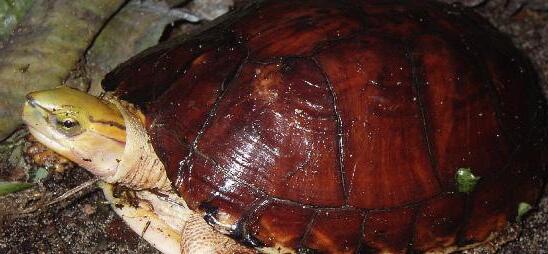
species was still common, but populations collapsed in the 1980s due to trade. No wild specimens have been observed since 2010; the species is now likely extinct in the wild. Less than 5 km 2 of its primary habitat may remain. It is being captive-bred in growing numbers, with a global population of about 1,000 individuals. Conservation must focus on preserving it in captivity and restoring habitat for future reintroduction.
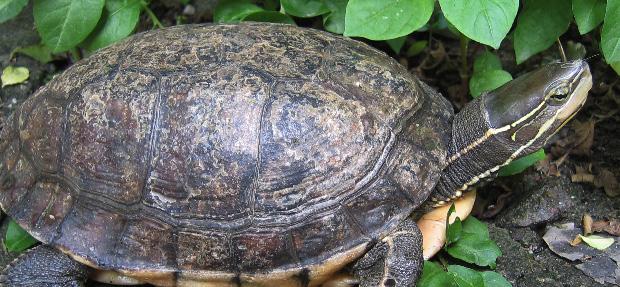
caught turtles have been sold in China, and more than 70 captive-bred specimens now exist. Though unnoticed for nearly a century, its rediscovery has placed the species in grave danger. The tiny, isolated populations face severe threats from habitat destruction, drought, and environmental degradation. Over 98% of its natural habitat has been lost, placing it on the brink of extinction once again.
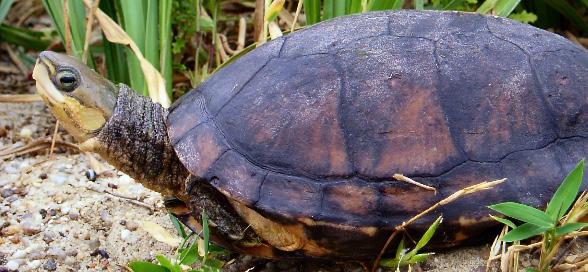
1990 and 2010, suggesting the species has an extremely limited range. No new individuals have been documented since 2009, and it may already be extinct in the wild. In captivity, the situation is dire; only a handful of breeders have produced offspring, and the global captive population totals about 190 individuals. With no known habitat and limited genetic diversity, the future survival prospect of this species is most uncertain.
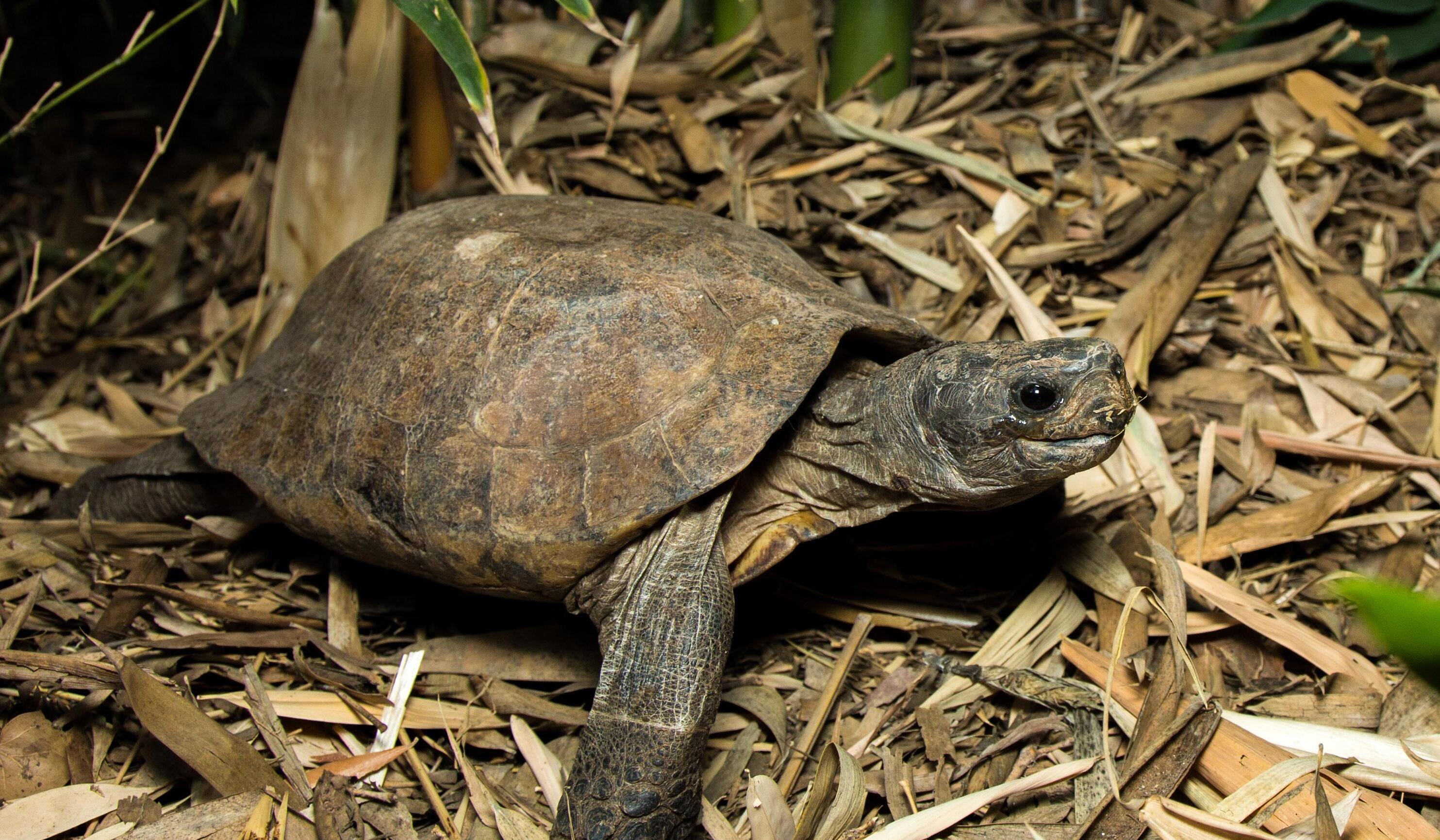
a raka N f ores T Tur T le
Heosemys depressa (Anderson 1875) Bangladesh, Myanmar
The Arakan Forest Turtle, Heosemys depressa, occurs in the Arakan and Chin Hills of western Myanmar, and Chittagong Hill Tracts of Bangladesh. The species is found in a variety of low and mid-elevation (to 700 m) habitats, including primary evergreen forest, second-growth forest, and bamboo brake. Little is known concerning its natural history; radio telemetry studies suggest the species is largely terrestrial, active primarily during the wet season, spends the cool dry season in a state of semi-dormancy, and has a varied diet of vegetation and fruits. The species is widely harvested for food by indigenous peoples in the region, but commercial hunting appears minimal. Some populations are threatened
IUCN
Red List: Critically Endangered
by habitat destruction. The Rakhine Yoma Elephant Sanctuary (RYES) harbors globally significant populations and expansion of this protected area would go far towards insuring the continued survival of the Arakan Forest Turtle. The species also occurs in the smaller Kyauk Pan Taung Wildlife Sanctuary of northern Rakhine State. A small assurance colony (ca. 50 adults) established at RYES was recently transferred to Hlawga Wildlife Park near Yangon because of Myanmar’s on-going civil war. Prior to the move, the assurance colony was producing 10–15 offspring each year. The species is also maintained at several institutions outside of Myanmar where reproduction has likewise been reported.
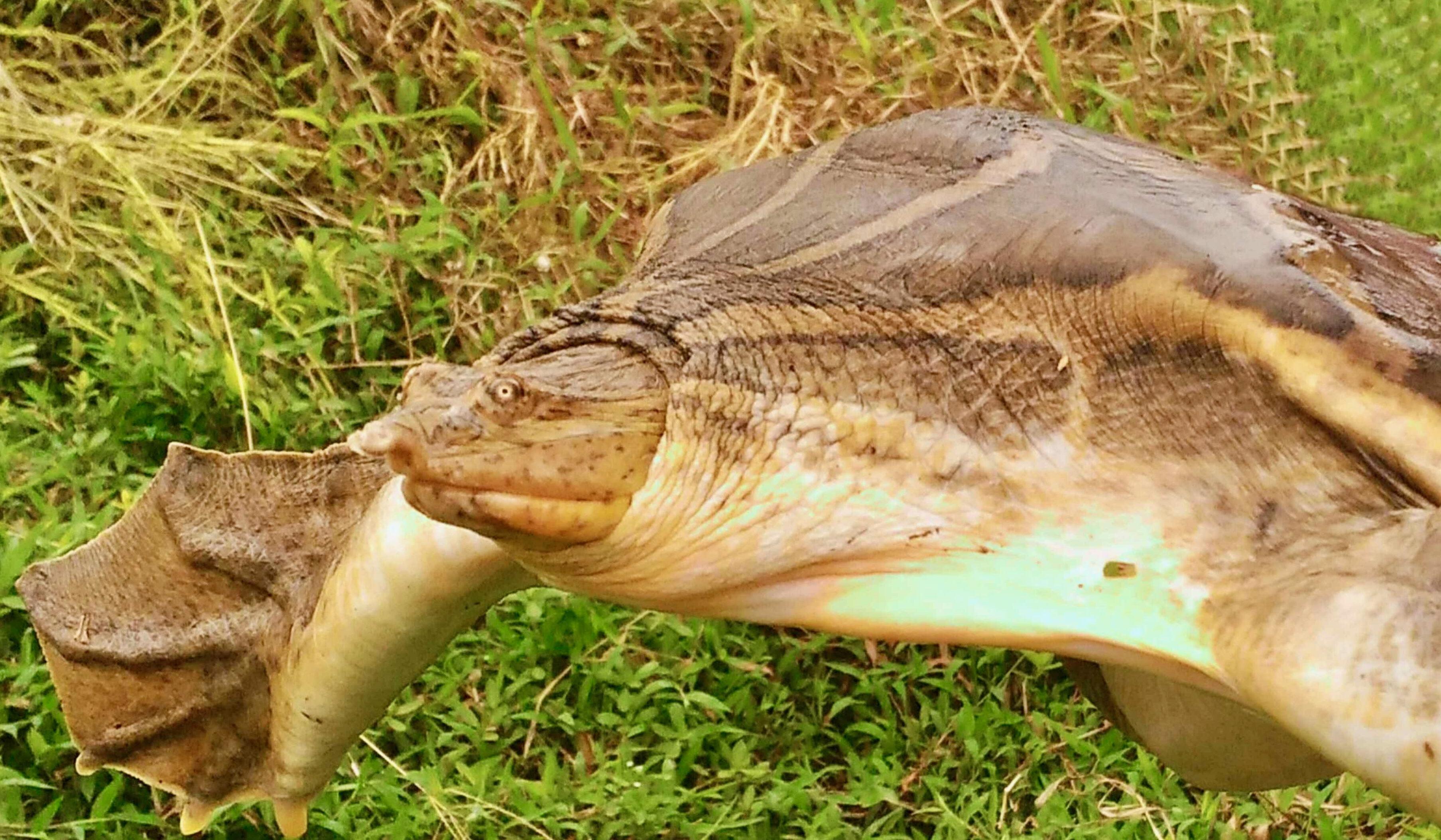
Chitra chitra Nutaphand 1986 Indonesia, Malaysia, Thailand
The Asian Narrow-headed Softshell Turtle, Chitra chitra , inhabits mainly sandy-bottomed, clearwater river sections in Indonesia, Malaysia, and Thailand. The subspecies C. c. chitra occurs in West Malaysia and Thailand, while the subspecies C. c. javanensis is known from rivers in Java and eastern Sumatra, Indonesia. These are huge turtles, with shell lengths of 130 cm to 140 cm reported. The species is completely aquatic except when females emerge to nest; these shy and cryptic turtles are almost never seen and only rarely captured using baited hooks or by probing the river bed with steel-tipped spears. Available information indicates that all populations are sparse and in decline, the result of decades, if not
IUCN Red List: Critically Endangered
centuries, of egg collection, targeted hunting, and fisheries bycatch, as well as degradation of their riverine habitat by damming, deforestation and resulting siltation, loss of nesting habitat from sand mining, unseasonal flooding by water released from upstream reservoirs, and riverside development. Conservation efforts to protect habitat and restore water quality need to be expanded, in-situ nest protection and in-country ex-situ captive breeding efforts to increase population recruitment must be stepped up, community engagement to reduce collection pressure is essential, and existing legal protection in all range countries and international trade regulation need diligent enforcement.
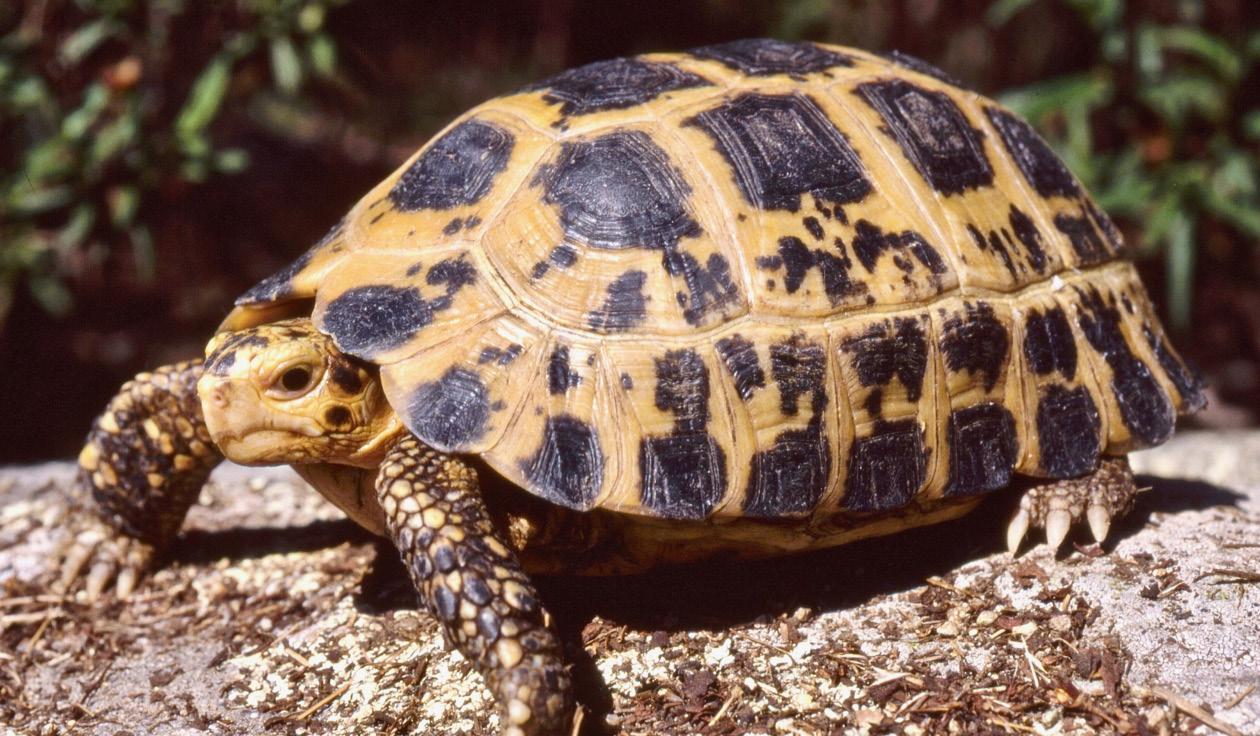
sulawesi (fors T e N’s) Tor T oise
Indotestudo forstenii (Schlegel & Müller 1845) Indonesia
The Sulawesi (or Forsten’s) Tortoise, Indotestudo forstenii , is a medium-sized tortoise (up to 32 cm and 2.5 kg) found only on and near the long northern peninsula of the Indonesian island of Sulawesi. The species has a long low-profile shell, yellow with central dark spots on each scute. The head is pale, sometimes approaching white. It bears a close resemblance and kinship with the Elongated Tortoise (I. elongata) of mainland Southeast Asia and the Travancore Tortoise (I. travancorica) of southern India. It inhabits mostly lowland forests and forest edge habitat.
Although once common and widely exported, today the Sulawesi Tortoise is critically endangered; recent surveys have had difficulty finding any specimens
IUCN Red List: Critically Endangered
outside protected areas in its very limited geographic range. Although the Indonesian government set a zero export quota in 2024, previous export quotas failed to prevent the species from being driven toward extinction in the wild. Local collectors use dogs to find these secretive tortoises, selling them to local animal dealers who ship them across Asia and elsewhere for the pet trade. Although some collection was probably sustainable in the past, it has caused the extirpation of the species from most of its known locales in the past two decades. Local consumption no doubt still occurs as well. Captive populations exist and are bred, but the species is not as hardy or prolific in captive conditions as some other species. Its future is certainly tenuous.
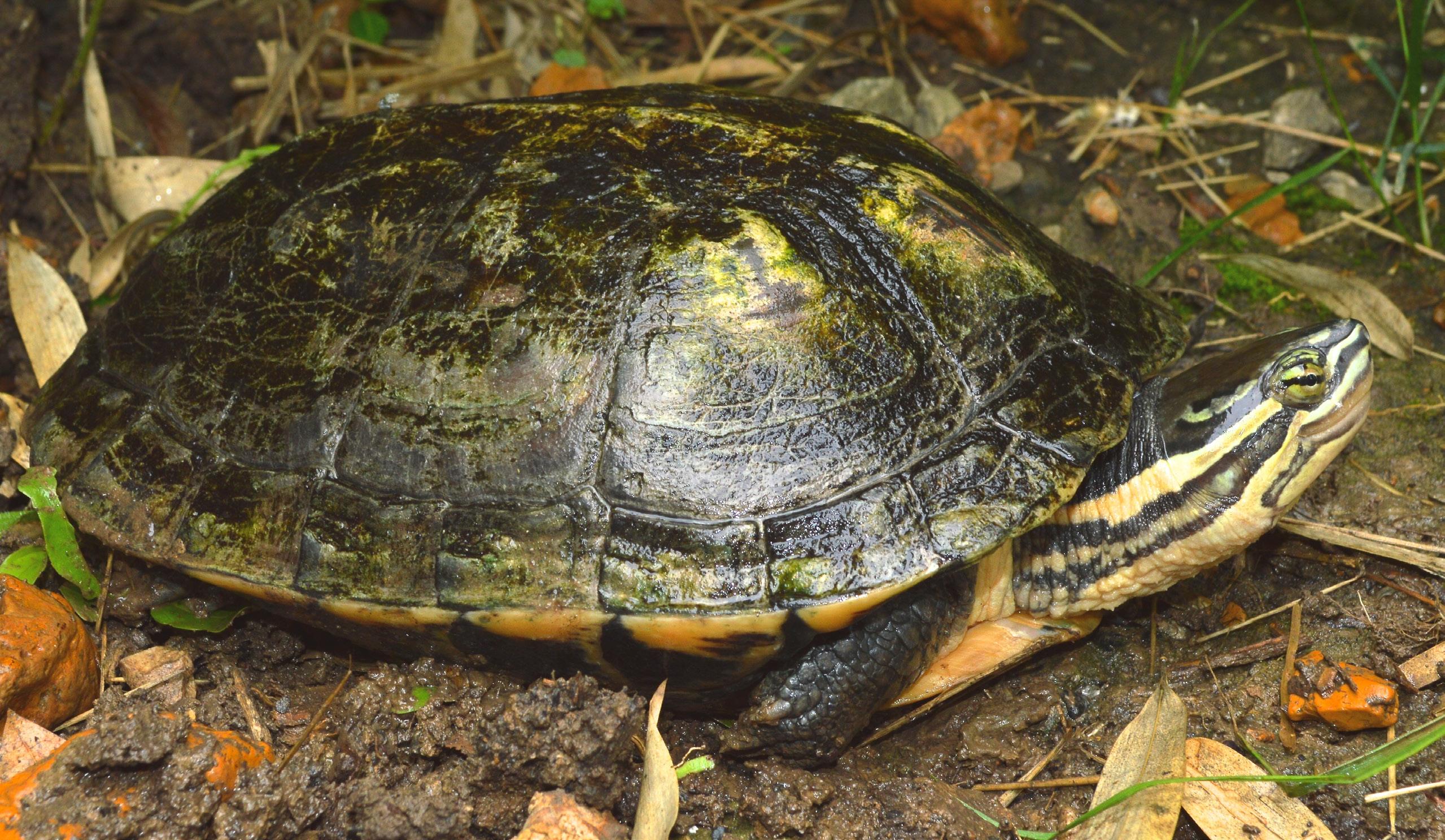
V ie TN amese P oN d Tur T le
The Vietnamese Pond Turtle, Mauremys annamensis, is a medium-sized turtle (females to 29 cm, males to 23 cm), endemic to central Vietnam, where it is restricted to lowland wetland areas below 200 m elevation. Geographic barriers appear to limit the species’ range. The species occurs sympatrically with the Chinese Stripe-necked Turtle (M. sinensis), with hybrids seen in the wild. The closely related Yellow Pond Turtle (M. mutica), is found in close proximity in Hue province, although no hybrids have been identified.
Although common in the past, the Vietnamese Pond Turtle is now extirpated throughout most of its former range. Habitat degradation and loss have been severe, mainly by agricultural conversion of wetlands
for rice cultivation. As recently as 2013, specimens that were apparently caught locally appeared in the pet trade in Vietnam. Collection for the Chinese food and traditional medicine markets in the 1980s and 1990s placed intense pressure on the species. Large-scale collection has ceased due to the rarity of the turtle, but the species is now farmbred in large numbers on turtle farms in Vietnam and China. This breeding has increased demand for more breeding stock, with a proliferation of farms in the region. Because the species is prolific in captivity, its market price and demand in the pet trade have dropped. The survival of the species in captivity appears assured. Whether reintroductions will be possible given the lack of remaining natural habitat is highly uncertain.
Mauremys annamensis (Siebenrock 1903) Vietnam
IUCN Red List: Critically Endangered
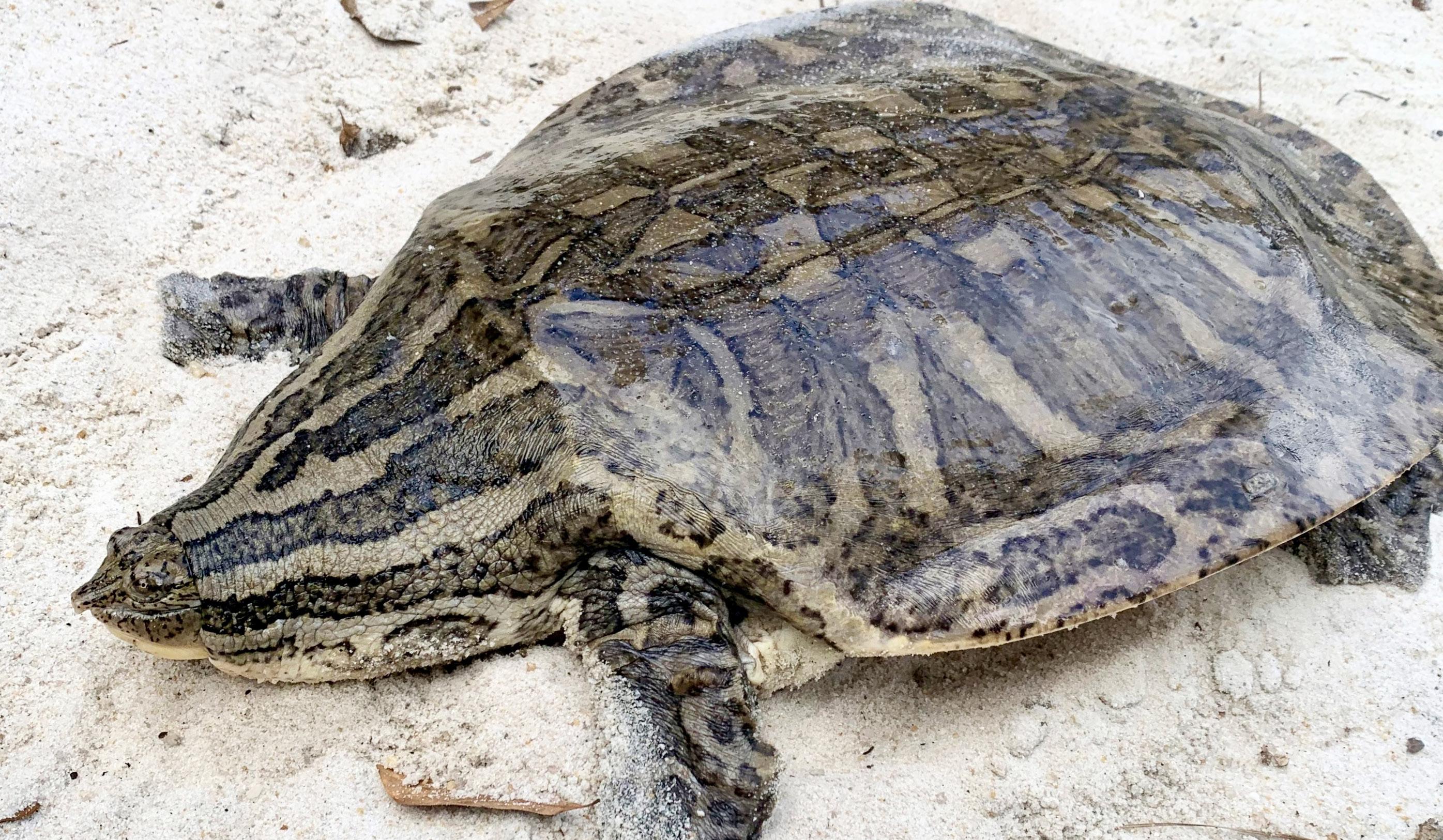
The Burmese Narrow-headed Softshell Turtle, Chitra vandijki , proves that large animals can be elusive and easily overlooked: while these animals can reach shell lengths of 80–100 cm or more, their occurrence in the Ayeyarwady and Thanlwin rivers of Myanmar and adjoining Thailand was not documented until the 1990s. The animals are shy, cryptic, and elusive, and thus hardly ever seen by humans and difficult to survey; but even passive trapping, netting, or baited hooks (which tend to turn up specimens of elusive species) rarely yields evidence of specimens. Consequently, the species has been considered rare and severely depleted as long as it has been known, presumably the result of long-
term hunting, egg collection, and accidental capture in subsistence fisheries, as well as habitat degradation and pollution. In recent years, targeted capture efforts to supply the regional wild meat trade, the trade in dried cartilage (calipee), and live specimens as high-status pets, have added to population pressures. Conservation is challenging given the rarity and monetary value of the animals. Opportunities lie in engaging local communities to reduce fishing pressure and habitat degradation at the few known sites where the species still occurs. These efforts can be combined with on-site nest protection and strengthened enforcement of existing local protections and international trade regulations.
Chitra vandijki (McCord & Pritchard 2003) Myanmar, Thailand
IUCN Red List: Critically Endangered
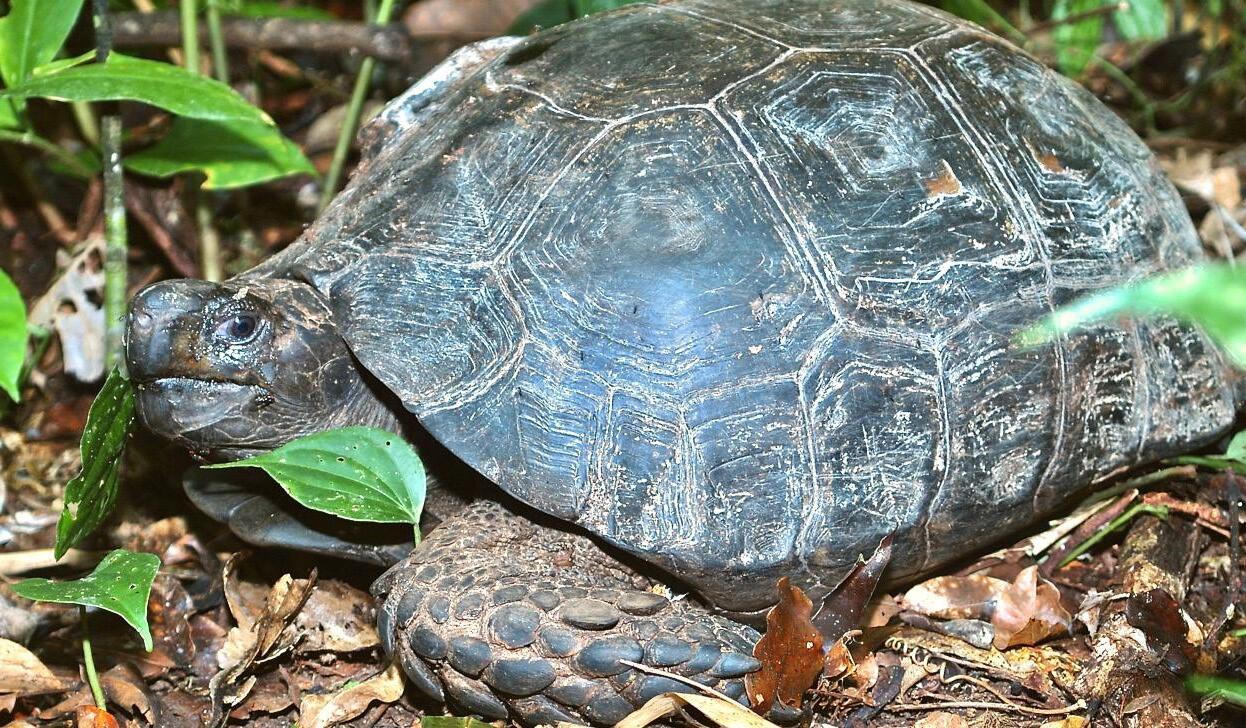
Asi A n Gi A nt t ortoise
Manouria emys (Schlegel & Müller 1840) Bangladesh, Brunei, India, Indonesia, Malaysia, Myanmar, Thailand
The largest tortoise in mainland Asia, the Asian Giant Tortoise, Manouria emys, can reach a mass of 25 kg in the wild. The species is a member of perhaps the most ancient tortoise lineage. It prefers mountainous wet forests, and unlike most tortoises, is very at home in and near water, sitting in cool flowing streams where it forages along stream banks for fallen fruit, bamboo shoots, and mushrooms. Its ability to scale steep slopes is legendary. It is unique among all chelonians in its breeding behavior; a female gathers nesting material together from the forest floor and builds a large mound, then sits atop her nest and buries a large clutch of eggs, sometimes 40 or more, deep inside. She will guard the mound against potential
IUCN
Red List: Critically Endangered
egg predators in the early days of incubation as well.
This species faces many threats in the wild, and is in certain decline throughout its range. The northern subspecies, the Burmese Black Giant Tortoise (M. e. phayrei), has been extirpated or nearly so from many former habitats in Myanmar and Thailand, and is still collected in some areas for meat and to sell into the pet trade. The southern subspecies, the Asian Brown Giant Tortoise (M. e. emys), has also suffered from forest clearing, human consumption, and illegal collection for the pet trade. The species is prolific and breeds well in captivity, but protecting wild populations is challenging.
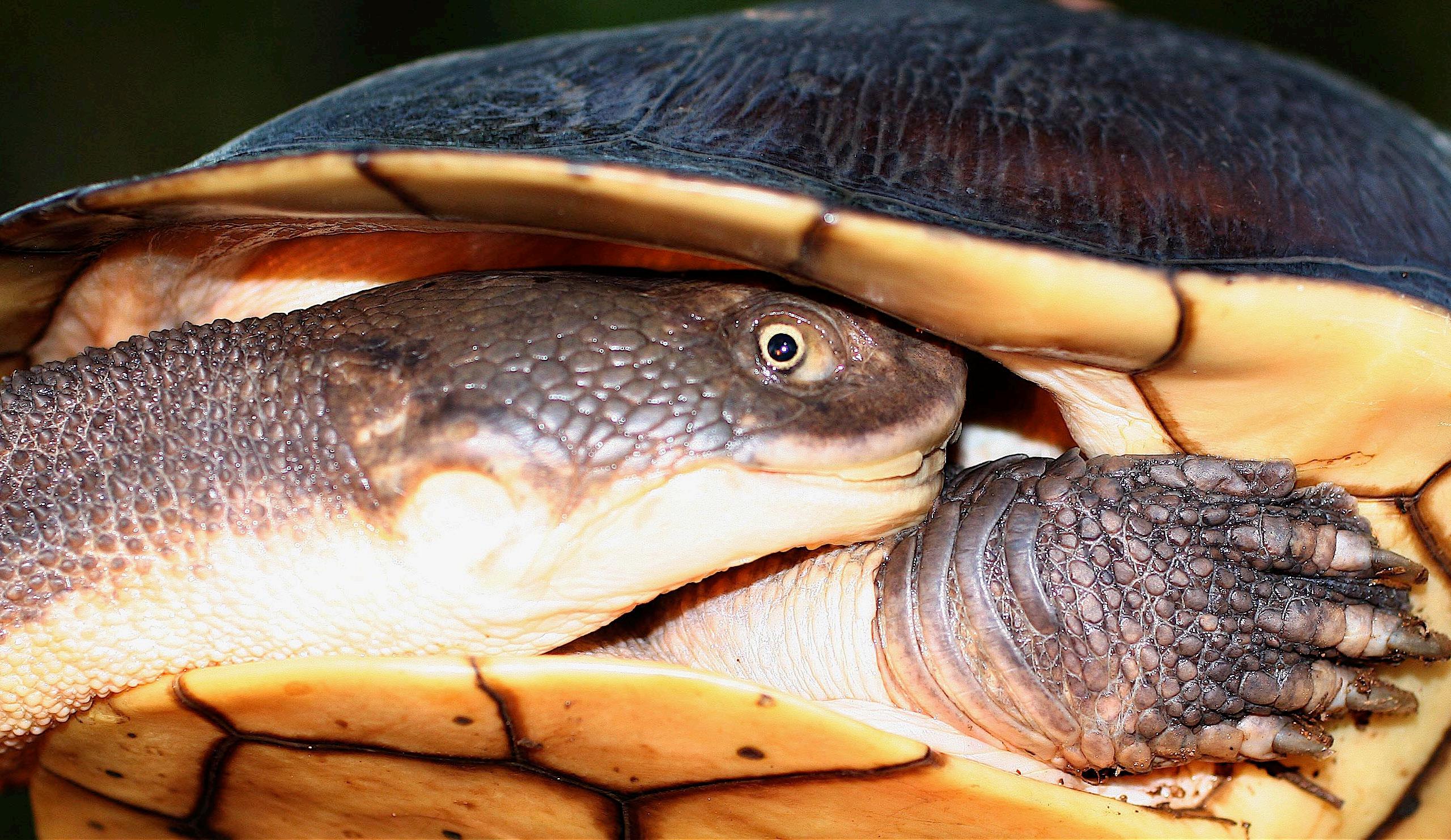
ro T i i sla N d s N ake-N ecked T ur T le
The Roti Island Snake-necked Turtle, Chelodina mccordi, is a species found on the small Indonesian island of Roti (Rote) as well as in Timor-Leste on Timor. Two subspecies are recognized: C. m. mccordi (described in 1994) and C. m. timorensis (Timor Snake-necked Turtle, described in 2007). Both subspecies have extremely limited ranges. The Roti subspecies has been subjected to intensive collection for the international pet trade, habitat loss from agricultural conversion, and predation by invasive fish species that preys on hatchlings. It became commercially extinct within 10 years of its description and essentially extinct in the wild within 20 years. The last known record in the wild was in 2009, despite many recent field surveys. The Timor-Leste subspecies appears to be more stable, as most of its distribution falls within the protected area of Nino Konis Santana National Park.
No protected areas existed on Roti until 2019, when three lakes where the species was formerly found were designated as Essential Ecosystem Areas by the Indonesian government and further protected under local traditional laws. A reintroduction program was also initiated, including a breeding and quarantine facility on Timor to house an assurance colony for eventual reintroduction efforts. Captive-bred turtles were brought in from North America, Europe, and Asia, with some of these turtles successfully breeding at the facility, and in 2024, a soft release repatriation program was initiated on Roti. Despite these efforts and the legal protection of the species and its remaining habitats, ongoing habitat restoration and the removal of invasive fish species and introduced Asian common toads remain critical to the success of the program.
Chelodina mccordi Rhodin 1994 Indonesia
IUCN Red List: Critically Endangered
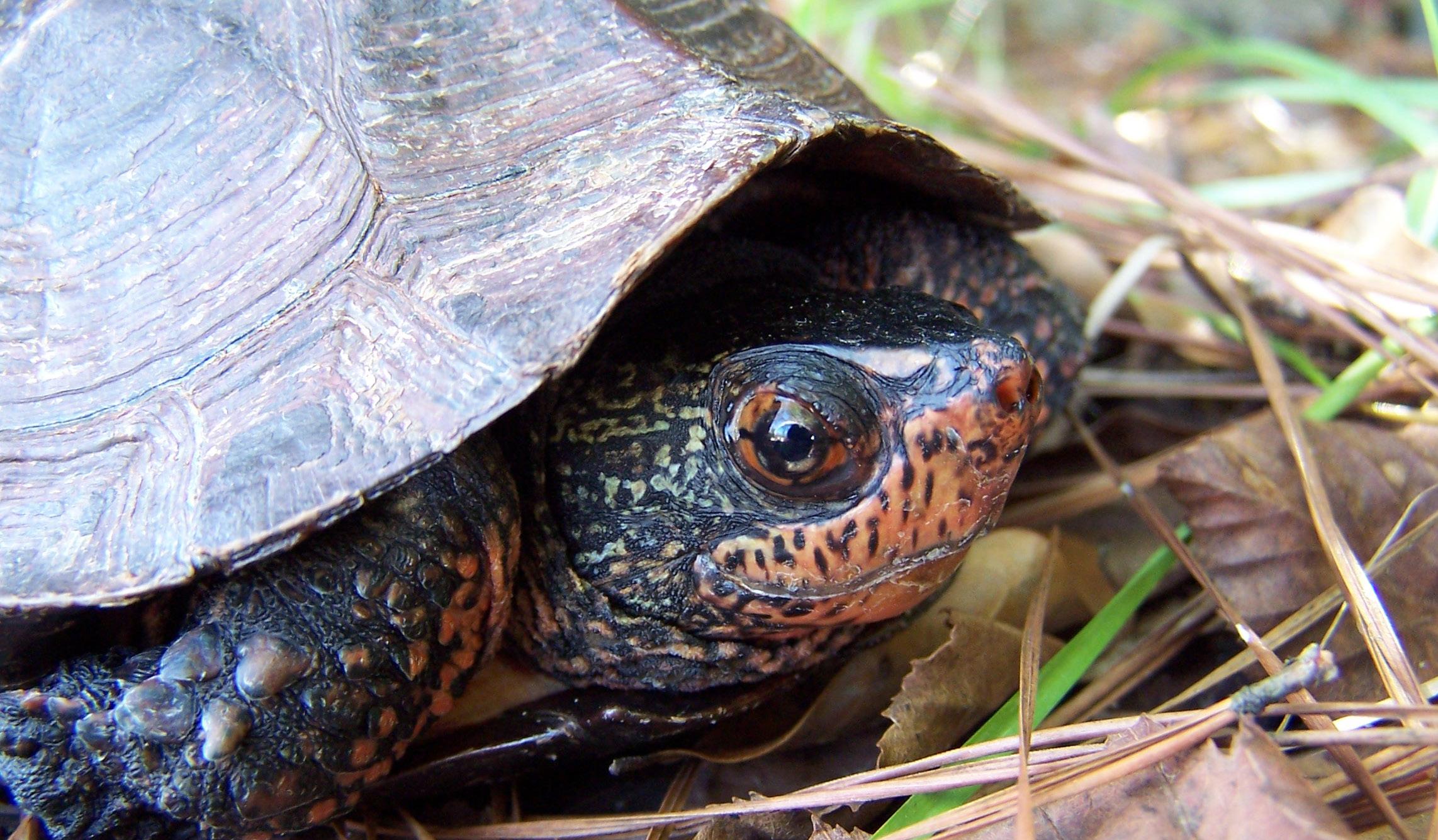
c hi N ese r ed-N ecked Tur T le
IUCN Red List: Endangered TFTSG Provisional Red List: Critically Endangered
The Chinese Red-necked Turtle, Mauremys nigricans, is one of the rarest freshwater turtles in China, if it even still exists in the wild. It has reached critically low numbers in its range and has not been seen in the wild for the past several decades. The species is sexually dimorphic, with females reaching over 28 cm while males do not generally exceed 19 cm. It previously occurred in streams of several river drainages in hilly forests of southern China at elevations of 300–700 m. Although it has apparently never been as widely eaten or used as much in traditional folk medicines compared to many other East Asian turtles, the species has been in demand in the pet trade for decades. Intense collecting over the past 30 years has
extirpated the species from nearly its entire range, and may have rendered it extinct in the wild.
The species hybridizes readily with other turtles of the genus Mauremys, posing a genetic risk if pets are released into the wild. Habitat degradation and loss are factors contributing to the species’ near-extinction, and at this point, captive breeding may be its only hope. More field surveys are urgently needed to ascertain if any wild populations persist. Since the species breeds readily in captivity, a large captive population exists, from which reintroductions could be attempted if its habitat can be protected and released animals not simply poached.
Mauremys nigricans (Gray 1834) China
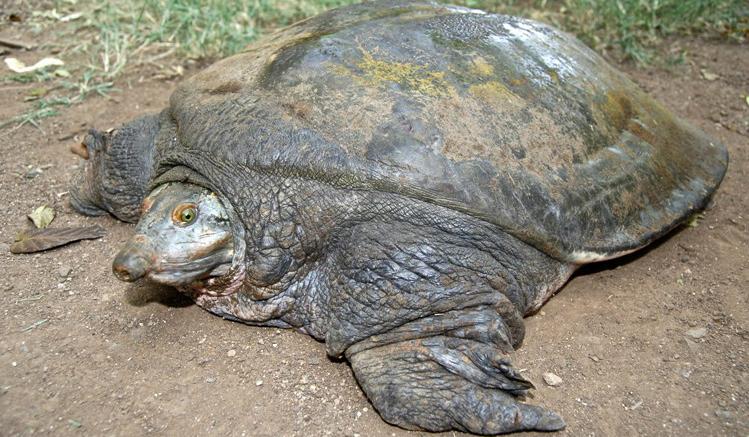
l ei T h’s s of T shell Tur T le
Leith’s Softshell Turtle, Nilssonia leithii , endemic to peninsular India, was once considered common, but has experienced severe declines across its range. Although no concrete population estimates exist, it is believed that over 90% of the species’ population has been lost. The primary threat to the species is local exploitation and illegal trade for meat and calipee (fibro-cartilaginous tissue of the shell and plastron). Habitat destruction from infrastructure development and sand mining has further exacerbated these declines. The species is now uncommon throughout its range, even within protected areas, leading to its uplisting from Vulnerable to Critically Endangered on the IUCN Red List in 2021, its inclusion in Schedule I of the Indian Wildlife (Protection) Act in 2022, and its transfer to Appendix I of CITES in 2023.
The ecology of the species remains poorly understood, with most available information derived from anecdotal observations, hindering efforts to devise effective management strategies. Past conservation efforts, such as those by local and international conservation organizations, proposed establishing captive assurance colonies in regional zoos within the turtle’s range. More recently, targeted initiatives have been undertaken in Maharashtra to develop conservation strategies in the Godavari River and in Tamil Nadu to assess the species’ population status in the Cauvery River. A comprehensive range-wide population assessment is urgently needed. Local communities should be engaged through awareness programs and integrated into conservation efforts to mitigate hunting and trade pressures. Critical habitats must also be identified and safeguarded to prevent further declines.
Nilssonia leithii (Gray 1872) India
IUCN Red List: Critically Endangered
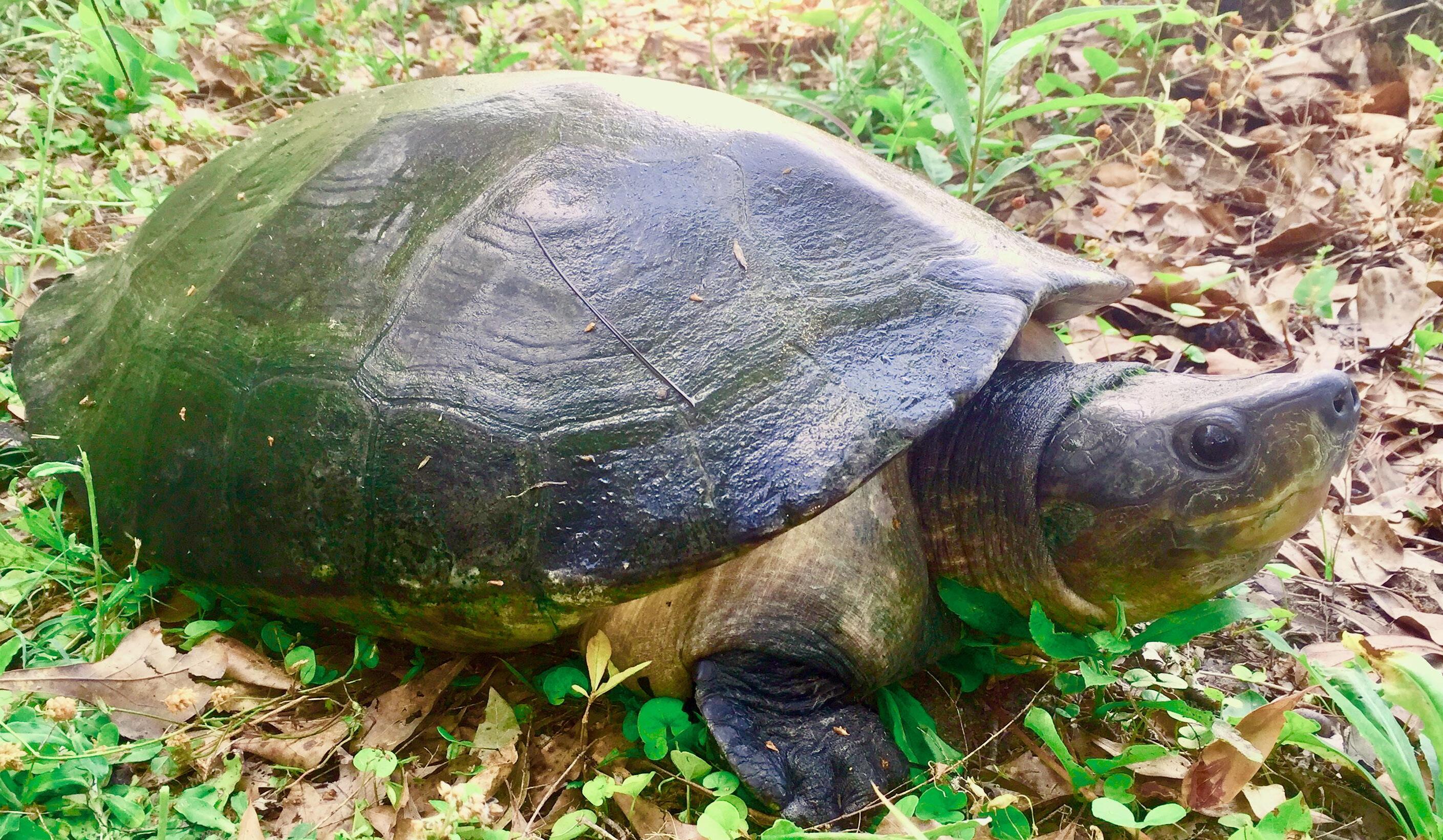
m alaysia N gia NT Tur T le
Orlitia borneensis (Gray 1873) Indonesia, Malaysia
The Malaysian Giant Turtle, Orlitia borneensis , is one of the largest freshwater turtles occurring in eastern Sumatra and Kalimantan in Indonesia, as well as peninsular Malaysia. This species occurs in large rivers, swamps, and wetlands. Anecdotal reports suggest that the species also occurs on the west coast of Sumatra, where more field surveys are needed.
Intensive hunting for consumption during the 1990s has caused a sharp decline in wild populations of the species. Incidental capture for food, particularly in Kalimantan, along with accidental entanglement in fishing gear and traps, are also major threats to wild populations. There are also reports of some ongoing illegal trade involving this species. The conversion of wetlands and swamps for agriculture has
IUCN Red List: Critically Endangered
contributed to habitat loss, although there is no accurate estimate of its impact on the species’ population status across its range.
This species has been protected in Indonesia since 1999. Community outreach and preliminary studies of its population biology and genetics have been conducted in Zamrud National Park and Belitung Island by local conservation organizations such as WRC Jogja, SatuCita Foundation, and Wildlife Observer Community, who work together with the Agency of Conservation of Natural Resources (BKSDA) in Indonesia. More surveys are needed to locate viable remnant populations across its range, along with additional research on threats and population ecology to inform sound conservation management strategies.
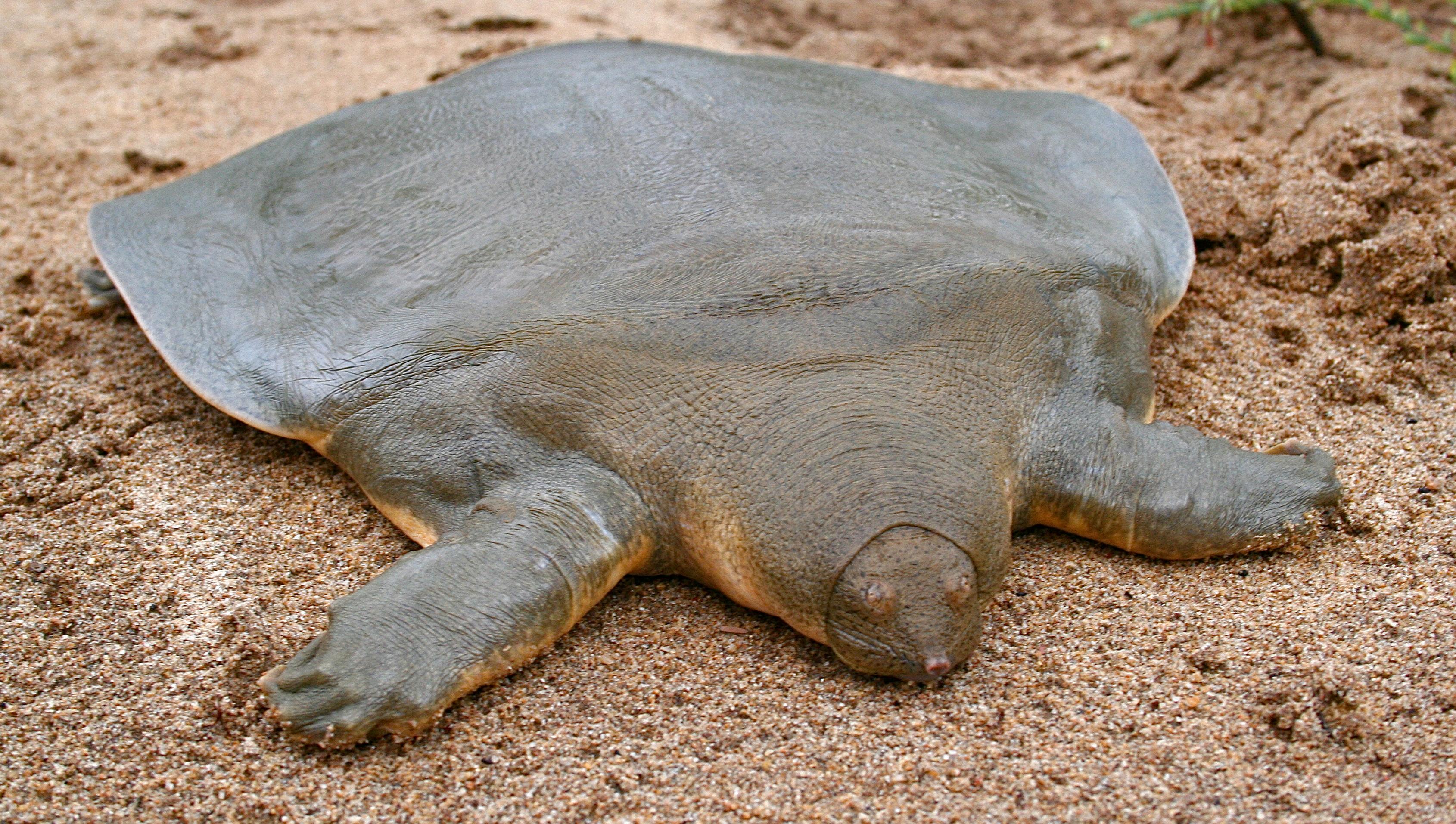
Asi A n Gi A nt s oftshell t urtle
Pelochelys cantorii (Gray 1864)
Bangladesh, Brunei, Cambodia, China, India, Indonesia, Myanmar, Philippines, Thailand, Vietnam
Widespread throughout the lowlands of tropical Asia, from India to Indonesia, the Asian Giant Softshell Turtle, Pelochelys cantorii, inhabits open rivers, large lakes, and estuaries, and some populations even share nesting beaches with marine turtles. Across this wide distribution range, subtle differences are known, and what we currently consider a single species may be a complex of several species or lineages. Predictably for a species complex that inhabits wetlands where human populations settle and grow, converting habitat to agricultural use and residential, industrial, and recreational development, populations of the species have steadily declined, and some have disappeared altogether. Targeted collection of the animals, and of their eggs from nesting beaches, accidental mortality as fisheries bycatch, and water pollution continue to further impact populations. While the species is protected under national legislation in
IUCN Red List: Critically Endangered
most countries of occurrence, and international trade is regulated under CITES Appendix II, practical in-habitat conservation work is limited to a few sites in Cambodia, China, and India. While it is difficult to work with the species because of its rarity and cryptic lifestyle, these softshells are a high priority for status surveys of remaining populations and for taxonomic studies. Efforts are also required to inform urgently needed improvements for in-situ conservation actions, protected area identification, establishment and management, and outreach work to reduce targeted and accidental collection. In-situ nest protection efforts in Cambodia have increased the influx of hatchlings into that population, and long-term monitoring for population recovery is needed, while similar management can also be applied at other remaining populations. Ex-situ conservation breeding, head-starting and release, and repatriation may also be needed.
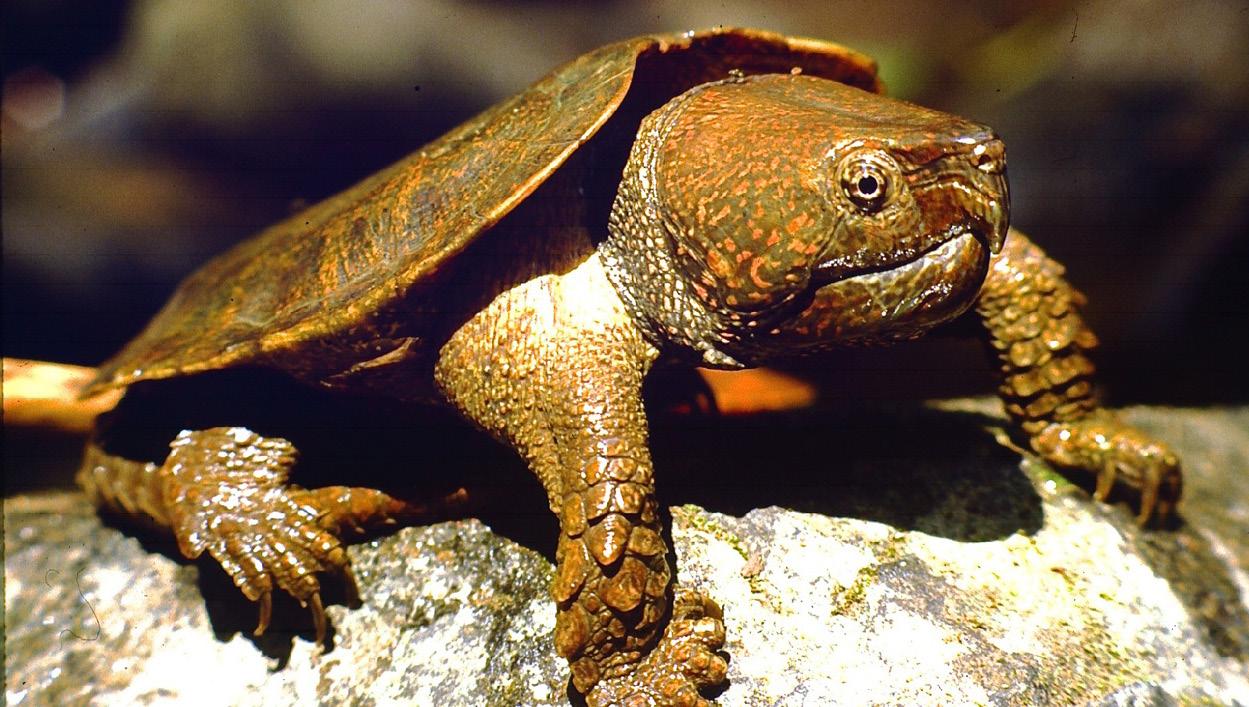
Platysternon megacephalum Gray 1831 Cambodia, China, Laos, Myanmar, Thailand, Vietnam
The Asian Big-headed Turtle , Platysternon megacephalum, is an evolutionarily distinct species, notable for its disproportionately large head, which cannot be retracted into its shell. This species inhabits fast-flowing mountain streams, where most other turtles are absent. As the only turtle species in many of these streams, it can thrive at high population densities if left unhunted, playing key ecosystem roles such as seed dispersal.
For decades, the species has been highly sought after in the food and pet markets. It is one of the more challenging species to keep and breed in captivity, with individuals that are sold in markets still mostly, if not exclusively, wild-caught. Over the past two decades, demand has seemingly surged in China, and vast numbers of individuals have been confiscated in Vietnam and Myanmar, highlighting the rampant and
persistent demand. As a result, most populations across its range have declined drastically, leaving the species rare in all but a few locations.
In recent years, some successful conservation efforts have been achieved for the Asian Big-headed Turtle, including the reintroduction of seized individuals into the wild and increased penalties for illegal hunting and trade. Nonetheless, the species remains in high demand, and the remaining wild populations continue to be hunted and illegally traded. Priority conservation actions should focus on reinforcing trade regulations to combat smuggling across borders and laundering of wildcaught turtles in trade and possession, strengthening enforcement against hunting, and enhancing inspections of turtle farms.
IUCN Red List: Critically Endangered
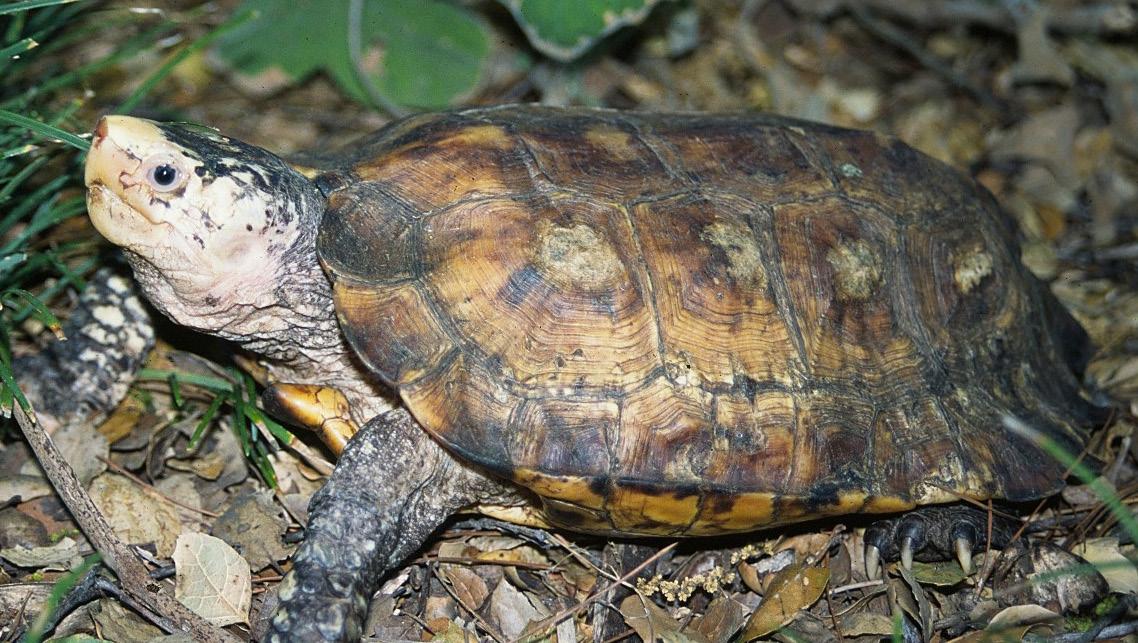
s ulawesi f ores T Tur T le
IUCN
The Sulawesi Forest Turtle, Leucocephalon yuwonoi, is a beautiful medium-sized semiaquatic turtle (up to 30.5 cm) endemic to the Indonesian island of Sulawesi. The species was formally described by scientists in 1995. Males are larger than females and distinguished by their larger whitish heads. Few field studies have been conducted; the species prefers narrow, shallow, flowing streams. These streams tend to be bordered either by forest or agriculture. According to one radiotelemetry study, both males and females are primarily nocturnal, with only males exhibiting some diurnal activity. Adults spend the daytime in the forest under dense canopy with generous ground cover, moving into the streams at night to forage, rest, and presumably mate. Hatchlings and juveniles are thought to stay in the streams at all times for their first few years. Females lay one or two large eggs, and lay multiple clutches in a year.
Habitat destruction from agriculture, logging, and forest clearing for palm plantations has eliminated much of the species’ habitat. Collection for meat and especially for the pet trade has devastated populations, with entire streams emptied of their turtles. The species fares poorly in captivity without proper care and many imported captives either die or, if they survive, rarely reproduce. The species’ low reproductive rate and limited range and habitat within the north-central area of Sulawesi have contributed to its rarity. Priorities include detailed surveys and continued work to improve their reproductive potential in captive assurance colonies. Habitat protection and an end to the rampant illegal collection for the domestic and international pet trade will be needed before captive-produced animals can be considered for release.
Leucocephalon yuwonoi (McCord, Iverson & Boeadi 1995) Indonesia
Red List: Critically Endangered
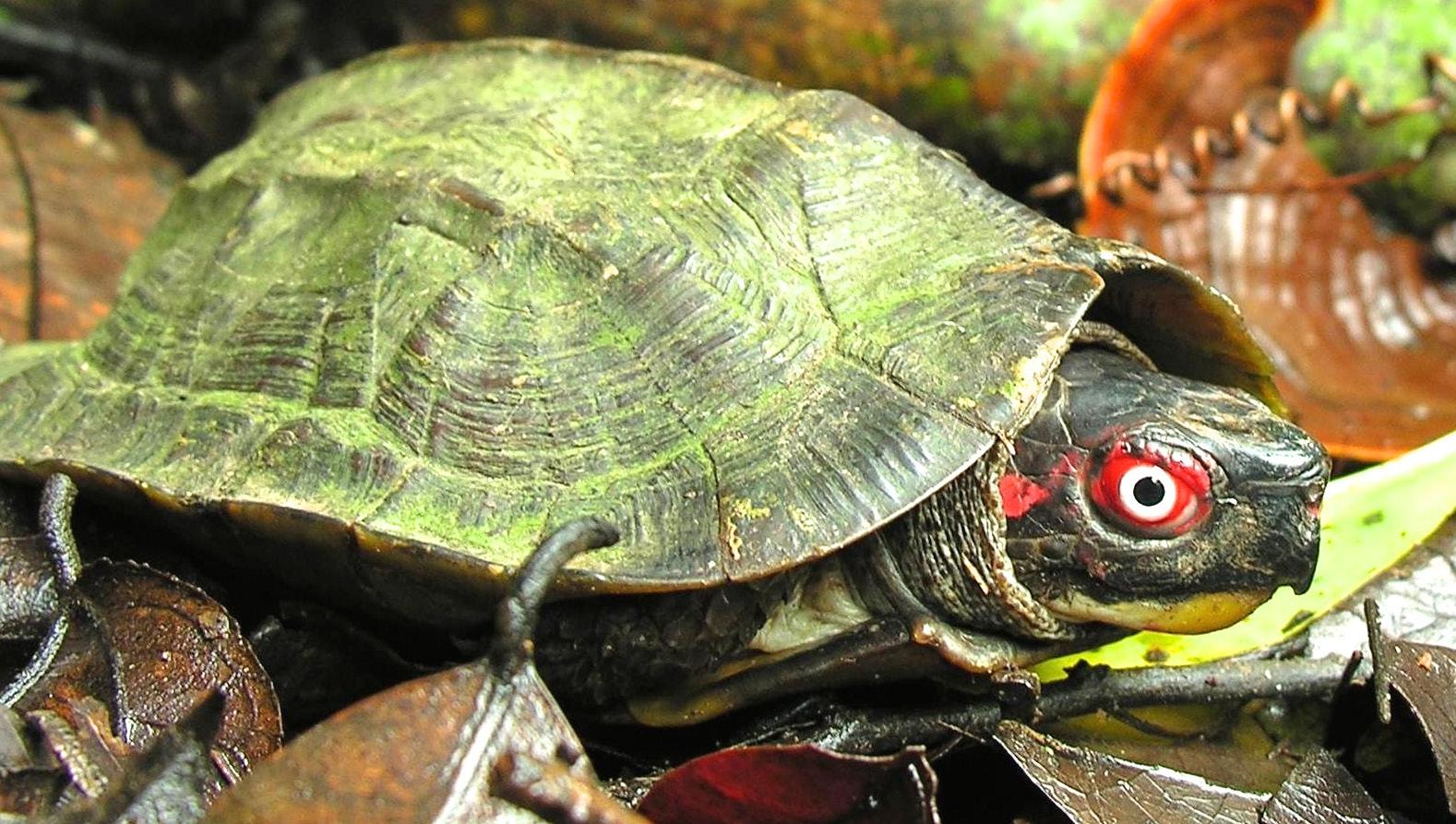
c ochi N f ores T c a N e Tur T le
The Cochin Forest Cane Turtle, Vijayachelys silvatica, is a small secretive species endemic to the evergreen and semi-evergreen forests of the Western Ghats in southwestern India, primarily found in the states of Kerala, Karnataka, and Tamil Nadu. With a maximum shell length of 14 cm, this cryptic turtle is often hidden among leaf litter, fallen logs, and dense vegetation. Its shell, often covered with extensive algal growth, indicates a strong association with moist, forest floor environments.
Currently, the species faces significant threats, with fewer than 2,500 mature individuals estimated to remain. It is primarily endangered due to overcollection for subsistence use and habitat loss from hydropower development, forest fires, and logging. Local communities often collect the species as a Non-Timber Forest Product, sometimes using dogs to track it. Forest fires and human consump-
tion are considered the greatest threats to the species, as reported in surveys of local ecological knowledge. The species is very difficult to maintain in captivity due to special dietary and climatic requirements.
Conservation efforts must focus on expanding Protected Areas by identifying small, community-owned or state-owned lands and improving connectivity between fragmented populations. Increasing awareness among wildlife protection staff and local communities about the species’ conservation status is crucial. Removing domestic dogs from Protected Areas will further reduce the risks to the species.
Research on the turtle’s populations, natural history, and genetic diversity is essential to guide efforts and ensure long-term survival. Population augmentation, including the development of assurance colonies, could further support the conservation of this rare species.
Vijayachelys silvatica ( Henderson 1912) India
IUCN Red List: Endangered
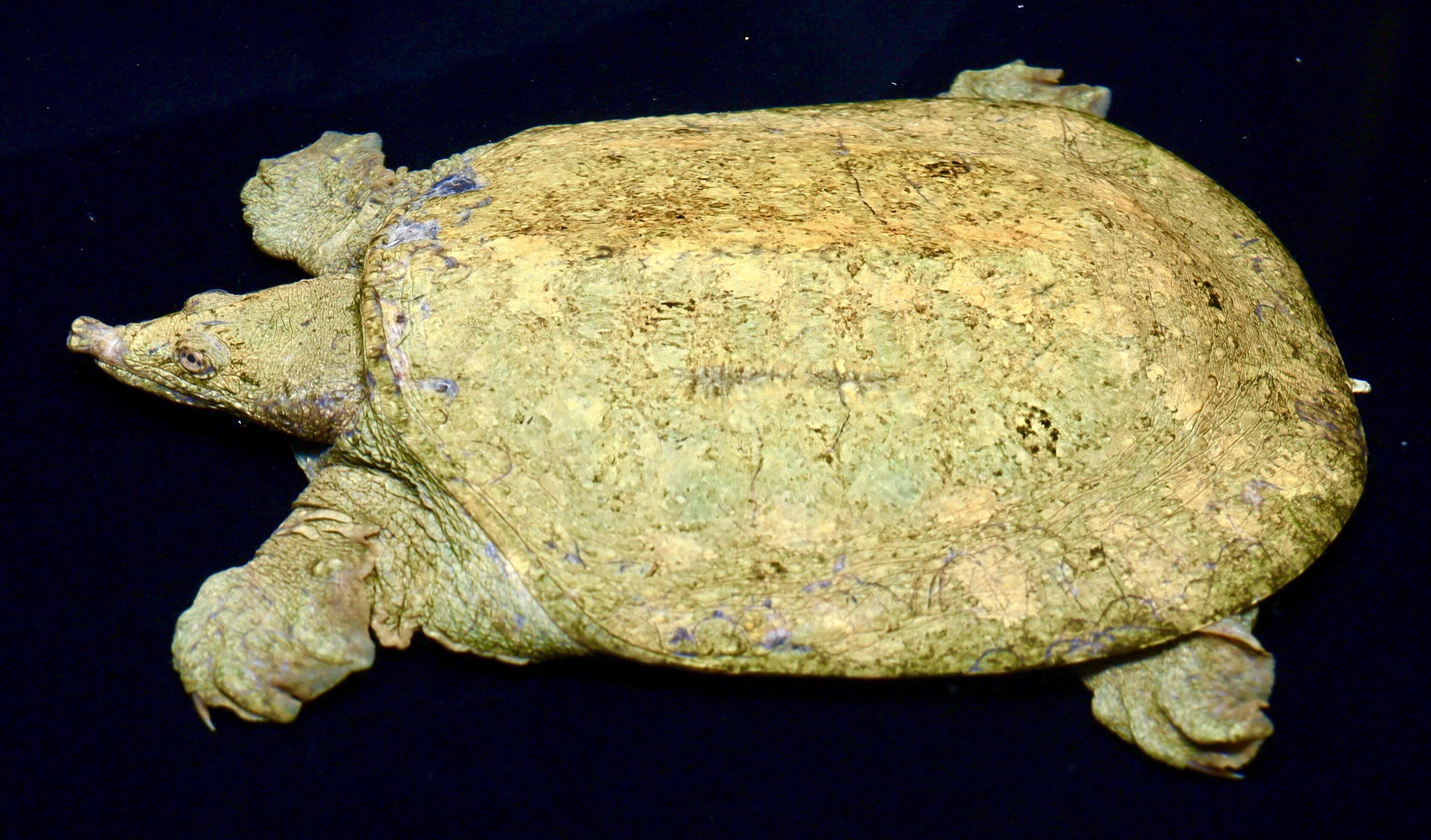
Chinese s oftshell t urtles
Genus Pelodiscus China, North Korea, South Korea, Russia, Vietnam
Traditionally, only a single species was recognized in the genus Pelodiscus, the Chinese Softshell Turtle, P. sinensis. While these softshell turtles are produced in huge volumes through aquaculture for consumption in China and elsewhere, remaining native wild populations are in decline as a result of targeted exploitation for consumption and as additional founder stock for aquaculture, as well as habitat loss, degradation and pollution.
However, over the past 30-odd years, it has become clear that the Chinese Softshell Turtle is in fact a species complex containing several separate species, most of which appear to be somewhat to extremely restricted in distribution range. In addition to the more widespread P. sinensis, these include P. axenaria in central China, P. huangshanensis (see photo above) in eastern China, P. shipian in east-central China, P. maackii in northeastern China, the Koreas, and Russia,
IUCN
P. parviformis in south-central China, and P. variegatus in Hainan and Vietnam. Few of these grow larger than 20 cm in shell length, with P. maackii exceptionally reaching up to 45 cm, while the largest known P. shipian is only 10.3 cm.
Ongoing taxonomic and distribution studies aim to clarify taxonomic identities and relationships, and geographic range and habitat use of the various taxa. Our understanding of the specific conservation status and needs is poor for the various forms, but it is clear that continuing exploitation and habitat impacts, as well as the risk of genetic pollution from interbreeding with escaped or released aquacultured specimens, threaten these various distinct forms. In-situ conservation action to protect and possibly augment native wild populations is needed for each of these range-restricted forms, as well as captive assurance colonies to safeguard their genetic lineages.
Red List: Vulnerable to Critically Endangered
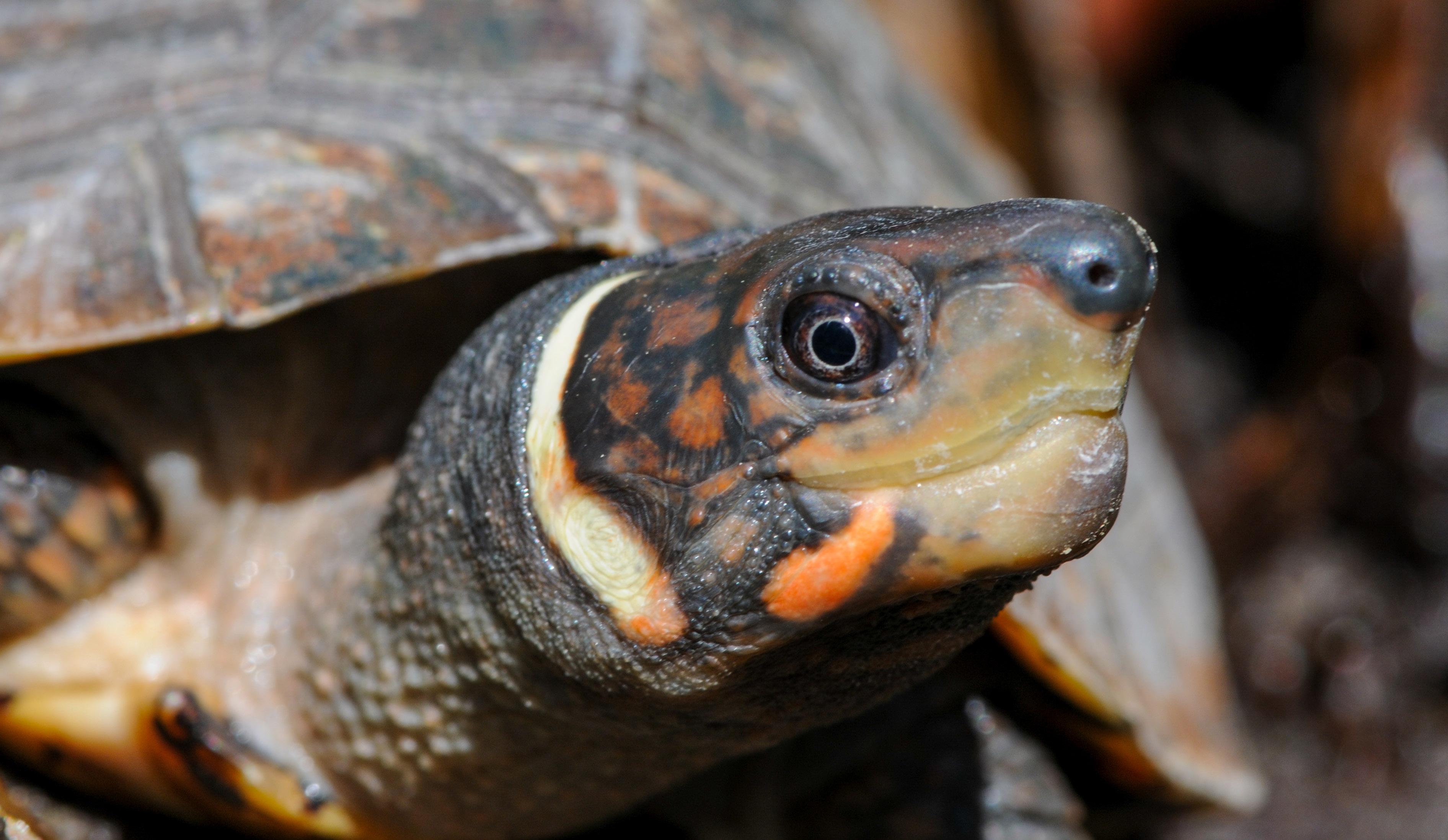
PA l AwA n f orest t urtle
The Palawan Forest Turtle, Siebenrockiellla leytensis, was mistakenly thought to come from Leyte in the Philippines when first described in 1920. Its true distribution on Palawan in the Phillippines was not discovered until the early 2000s. Since then, high demand for the species in the international pet trade has driven it to the brink of extinction.
The species is highly aquatic, resting during the daytime in burrows excavated into stream banks. It is an omnivorous, but predominantly herbivorous, bottom feeder that forages at night. It prefers slow-moving streams in the most threatened lowland ecosystems: Pandan swamp forests and primary rainforests. Its area of occupancy is limited to some 328 km2. Habitats are threatened by slashand-burn farming, agricultural encroachment, and development. The greatest threat is the illegal wildlife trade for pets, food, and traditional medicine use.
The species is protected nationally under the Wildlife Protection and Conservation Act 9147 of 2001, and its international trade is regulated by CITES, yet illegal harvest and trade trade, facilitated by online platforms and laundering of wild-caught individuals as captive-bred, continues. Over-exploitation has resulted in extirpation of some populations, an overall decrease in mean size of individuals, a biased sex ratio, and the dominance of immature over mature individuals in wild populations. With the aim to protect the species and its habitat and to hopefully downgrade it to Endangered, the local conservation organization, Katala Foundation, adopted the turtle as its flagship species in 2006 and has been implementing a holistic conservation program ever since. In-situ conservation measures are complemented by the establishment of an assurance colony and conservation breeding, which has been successful since 2018.
Siebenrockiella leytensis (Taylor 1920) Philippines
IUCN Red List: Critically Endangered
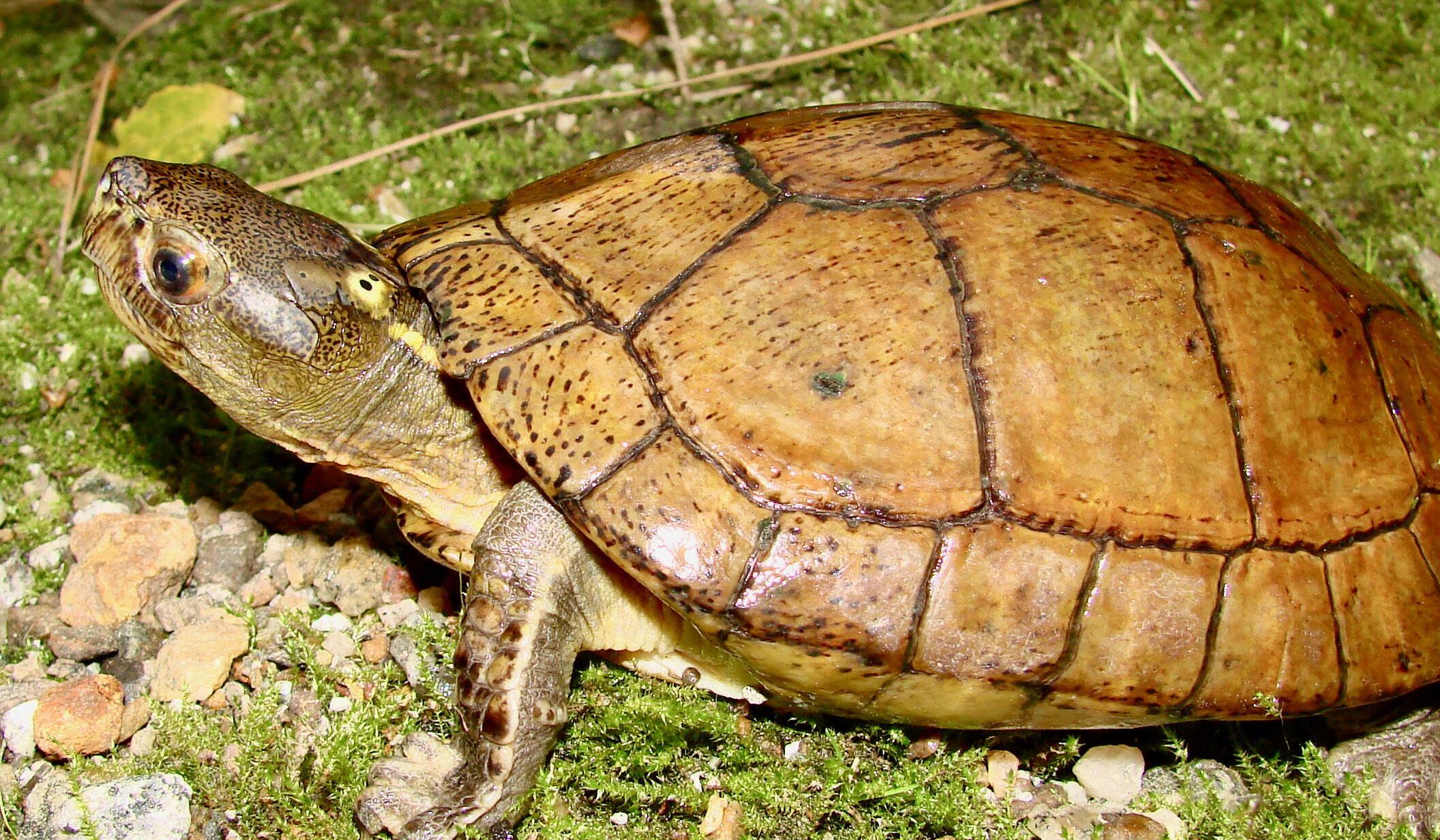
Beale’s e yed Tur T le
Sacalia bealei (Gray 1831) China
Beale’s Eyed Turtle, Sacalia bealei, is a small freshwater species, with a shell length that averages 13 cm, though some females reach 19 cm. It is easily identified by the two pairs of eye-like ocelli on top of the head, with the rear pair more prominent than the anterior pair. Bright vertical stripes are present on the neck. The shell margin is smooth, the carapace is light chocolate-brown with radial stripes and a slight median ridge; the plastron is yellowish, spotted, or marked with dark brown. In adult males, the head, neck, and eyes take on extensive orange markings, and the eyes are blood-red.
The species’ distribution is in southern China, including the provinces of Guizhou, Anhui, Jiangxi, Fujian, Guangdong, and Hong Kong. The turtle is aquatic, primarily inhabiting slow, clear, mostly sandy-bottomed streams in hilly areas below 400 m altitude. Its diet is omnivorous, consisting of fish, shrimp, snails, worms,
IUCN Red List: Endangered
TFTSG Provisional Red List: Critically Endangered
and fallen fruit. The species is increasingly popular among turtle hobbyists. Like many other turtle species, it is also consumed for its alleged health and longevity benefits. It is difficult to breed and successful captive breeding has been limited. Provenance of captive animals is mainly from wild populations, resulting in continued illegal hunting and trade. The species is extremely rare in the wild, officially listed as Endangered on the IUCN Red List (needs updating), provisionally assessed as Critically Endangered by the TFTSG, and listed as a second-class protected species in China’s 2021 List of Wildlife under Special State Protection, which leaves it open to commercial captive farming there. Urgent conservation needs include habitat protection and anti-poaching measures. Hong Kong is planning to restore the species’ local wild population through the reintroduction of captive-bred individuals.
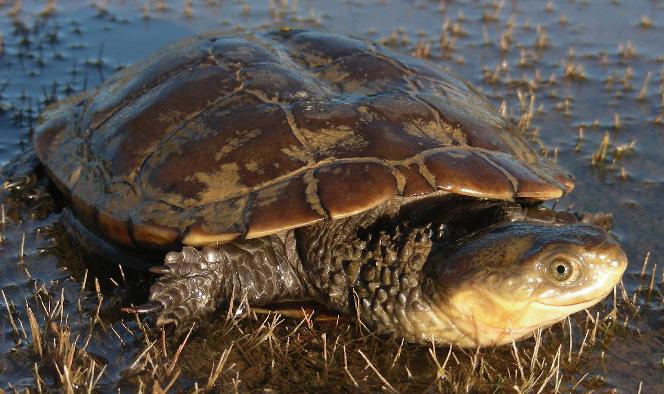
w es T er N s wam P Tur T le
Pseudemydura umbrina (Siebenrock 1901) Australia
The Western Swamp Turtle , Pseudemydura umbrina, is a long-lived, cryptic, slowreproducing specialist of ephemeral clay swamps, with its natural range largely confined to what is now the metropolitan area of Perth, Western Australia’s fast-growing capital city. Despite the creation in 1962 of two small nature reserves protecting fragments of habitat, the wild population dropped from over 200 in the 1960s to fewer than 30 individuals by 1987. A rescue operation began in 1988 and established a successful captive breeding and recovery program. Ongoing acquisition, restoration, and creation of adjacent habitat, combined with predator control in a reserve that is smaller than the home ranges of single individuals, has allowed the last tiny, self-sustaining wild subpopulation to slowly increase naturally. The reintroduction of captive-bred juveniles recovered a second wild subpopulation, and the
IUCN Red List: Critically Endangered
introduction of captive-bred juveniles to two additional protected sites north of its known range has increased the overall wild and rewilded populations about ten-fold since the 1980s. However, all translocation sites provide only marginal habitat, juveniles take 8–15 years to reach maturity, and the number of wild and rewilded adults still hovers around 50. The species remains under threat from continuing habitat loss and degradation, introduced predators (foxes, rats, pigs), poaching, and, due to climate change, increasing frequency and severity of droughts and bushfires. To address climate change, assisted colonization using captive-bred progeny has been trialed since 2016 at three sites on Western Australia’s wetter and cooler south coast, but it will take at least another decade of monitoring to evaluate if this can successfully establish naturalized populations.

m ary r i V er Tur T le
IUCN Red List: Endangered
TFTSG Provisional Red List: Critically Endangered
The Mary River Turtle , Elusor macrurus, is a highly distinctive species of large turtle (shell length to >40 cm), restricted to a small coastal drainage, the Mary River, in coastal Queensland, Australia. The species faces a serious threat due to its status as a relictual lineage, characterized by an exceptionally small distribution spanning only 290 river km, which is a critical factor constraining its ability to respond to climate change. It is also threatened by substantial changes in land use and clearing in the Mary River catchment, including the riparian zone, heavy predation on nests by the introduced European Red Fox, trampling of its discrete nesting banks by domestic
livestock, and water resource development, including construction of dams and weirs. These structures restrict turtle movement and reduce availability of riffle zones, which are important for oxygenation for this species, as it has evolved specialized structures for supplemental cloacal respiration through its unusually large tail. In 2024, the species was listed as Critically Endangered under the Australian Environment Protection and Biodiversity Conservation Act. Priorities for management intervention include the protection of nesting banks from foxes and livestock, protection of instream habitat important for hatchlings and young juveniles, and head-starting programs.
Elusor macrurus (Cann & Legler 1994) Australia
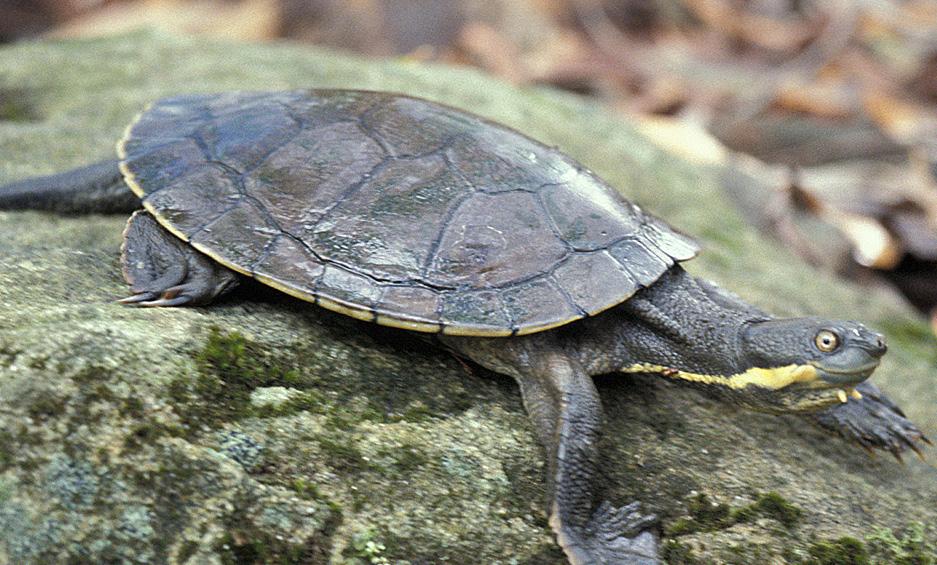
Belli
Nger r i V er sN a PPi Ng Tur T le
Myuchelys georgesi (Cann 1997) Australia
The Bellinger River Snapping Turtle, Myuchelys georgesi, is a species of smaller turtle restricted to a small coastal drainage, the Bellinger River in New South Wales, Australia. The species is restricted to a 35 km linear range. It is also threatened by changes in land use and clearing in the Bellinger catchment, including the riparian zone, leading to instream changes that favor the establishment of an introduced competing species, the Macquarie River Turtle, Emydura macquarii, which has been progressively increasing in abundance relative to M. georgesi. Unfortunately, E. macquarii was recently introduced to the Bellinger River, where it now hybridizes with M. georgesi, with the risk of genetic pollution and loss of genetic identity. In 2015, a disease swept through the range of the Bellinger River Snapping Turtle and killed almost all adult individuals in the population, but left the in-
IUCN Red List: Data Deficient TFTSG Provisional Red List: Critically Endangered
troduced Macquarie River Turtle unaffected. Known surviving adults of the Bellinger River Snapping Turtle currently reside in an assurance colony maintained by Taronga Zoo in Sydney, which has had success in breeding and release of hatchlings. In 2016, the species was listed as Critically Endangered under the Australian Environment Protection and Biodiversity Conservation Act. With only juveniles remaining in the wild, and uncertainty as to how they will be affected by the disease when they reach adulthood, the species’ wild population is considered at risk of imminent extinction. Priorities for research to guide management intervention are to determine if those adults surviving the virus did so because they avoided infection or because they are inherently resistant, and to assess the impact of the species’ hybridization with the Macquarie River Turtle.
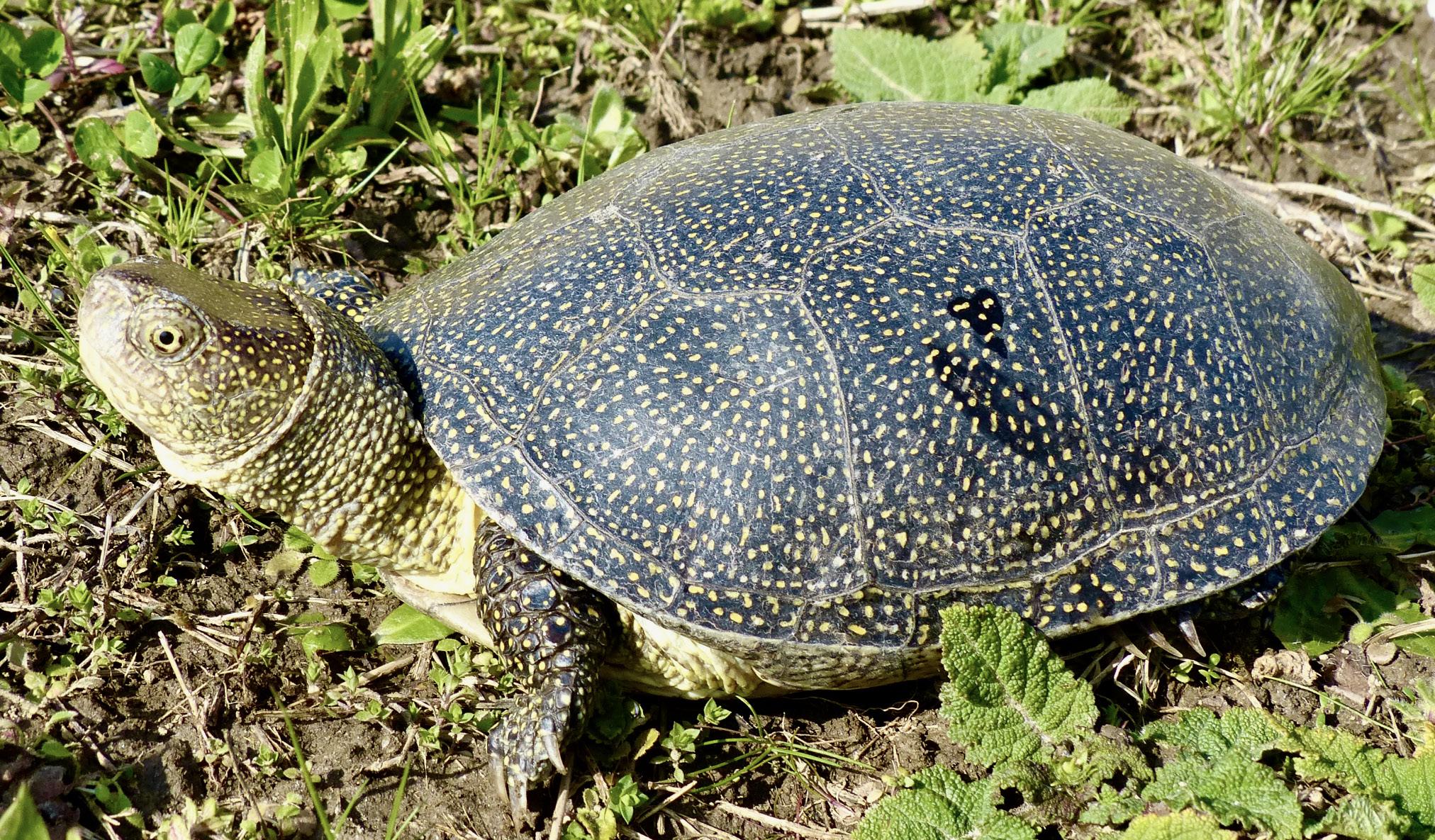
e iselT’s PoN d Tur T le
TFTSG Provisional Red List: Critically Endangered
Eiselt’s Pond Turtle, Emys orbicularis eiselti, a small-bodied subspecies of the wider ranging European Pond Turtle (E. orbicularis), is endemic to the region east of the Amanos Mountains in Türkiye (Turkey) and extending into Syria. First described in 1998, the subspecies was identified based on only four museum specimens collected during the 1960s and 1970s. With a maximum shell length of 13.1 cm, the species ranks among the 25 smallest turtle taxa.
Eiselt’s Pond Turtle is one of the least studied European Pond Turtle subspecies. Between 1998 and 2021, only 18 individuals were recorded. During field surveys in 2023 and 2024, an additional 26 specimens were located. Recently, with international support, local researchers conducted field studies to reassess the population status of the taxon, locating only two additional specimens in the Asi River.
Historically, the Amik-Maras Rift Valley, the original distribution area of the subspecies, comprised extensive marshlands connected to the Asi River. However, the majority of these wetlands have been destroyed, leaving the Asi River and its tributaries as the only remaining refuge for the subspecies. Its range within the Amik-Maras Rift Valley has shrunk by approximately 98%, from an original area of 11,612 km2 to a current range of just 206 km2. It is estimated that fewer than 100 mature individuals of Eiselt’s Pond Turtle remain in the wild.
Survey data over the past three decades document ongoing habitat loss and degradation for this species. There is an urgent need for habitat management, including the creation of protected areas, which are crucial for the subspecies’ survival. A combination of ex-situ and in-situ conservation measures, including land acquisition, are in progress of being developed.
Emys orbicularis eiselti Fritz, Baran, et al. 1998 Turkey, Syria
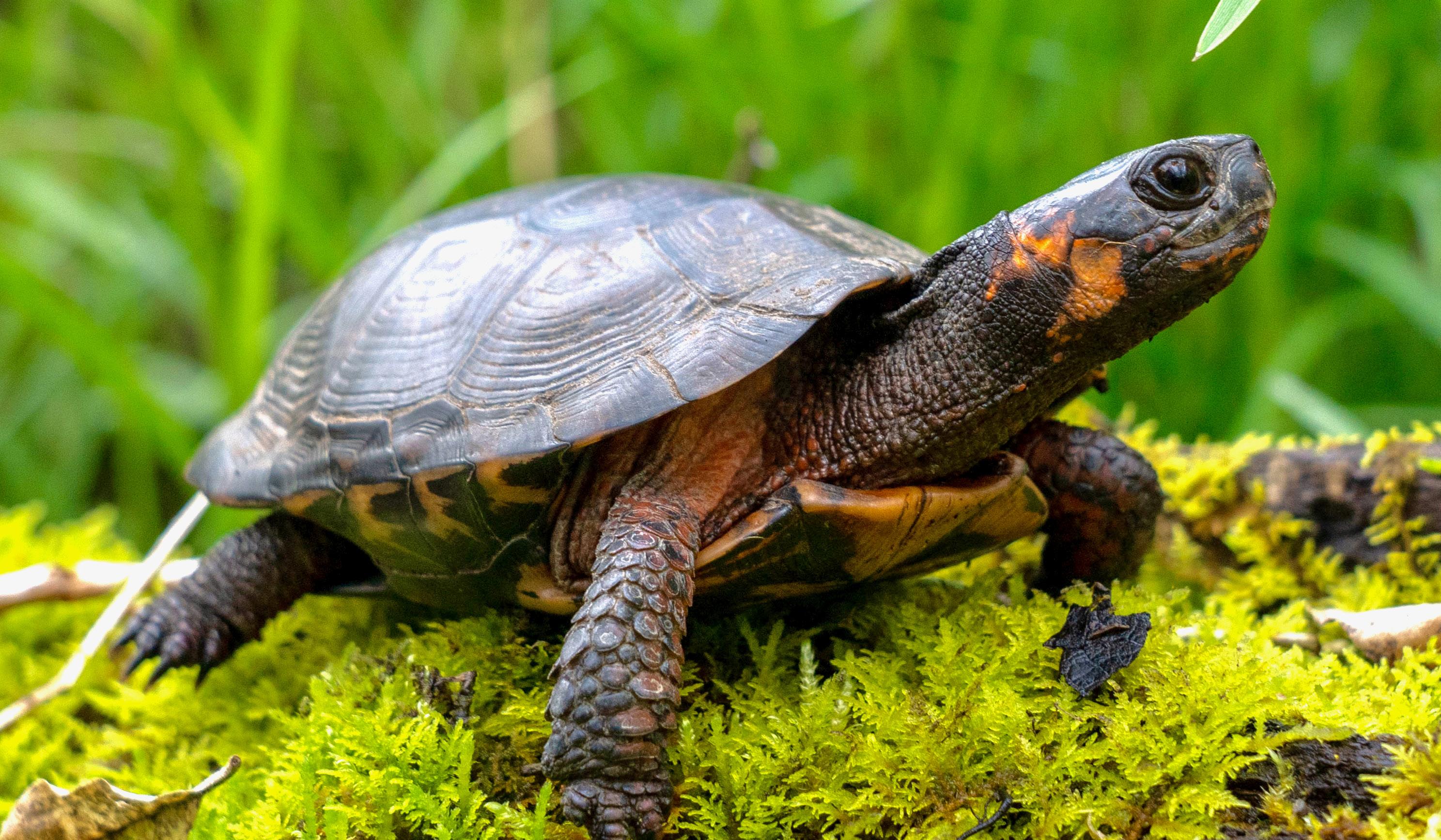
Bog Tur T le
Glyptemys muhlenbergii (Schoepff 1801) United States
The Bog Turtle, Glyptemys muhlenbergii , is one of North America’s smallest turtles, with a maximum shell size of 11.5 cm. The species lives in open-canopy, shallowly inundated bogs, fens, and wet meadows. These wetlands are often widely dispersed on the landscape. Habitat destruction and degradation is primarily driven by human-induced hydrological changes. There is a long history of drying out or ponding of Bog Turtle sites for agriculture, roads, development, and recreation. Severe droughts and flooding have impacted populations as well. Encroachment by woody vegetation and invasive plants is an ongoing issue in many sites. The increased rarity of suitable habitat makes connectivity between populations less likely. Relatedly, road mortality has
IUCN Red List: Critically Endangered
become an increasingly common occurrence for Bog Turtles attempting to move between sites. The species has a low reproductive rate, with females averaging only three or four eggs per year. The eggs are deposited just above the water line and are vulnerable to flooding. Eggs, juveniles, and adults are also experiencing elevated predation pressures by human-subsidized mesopredators such as raccoons, skunks, and opossums. Poaching is a serious threat as well. State and federal wildlife officials and local partners have worked to monitor Bog Turtle populations and to protect habitat. There is also ongoing habitat restoration and management work on both public and private lands.
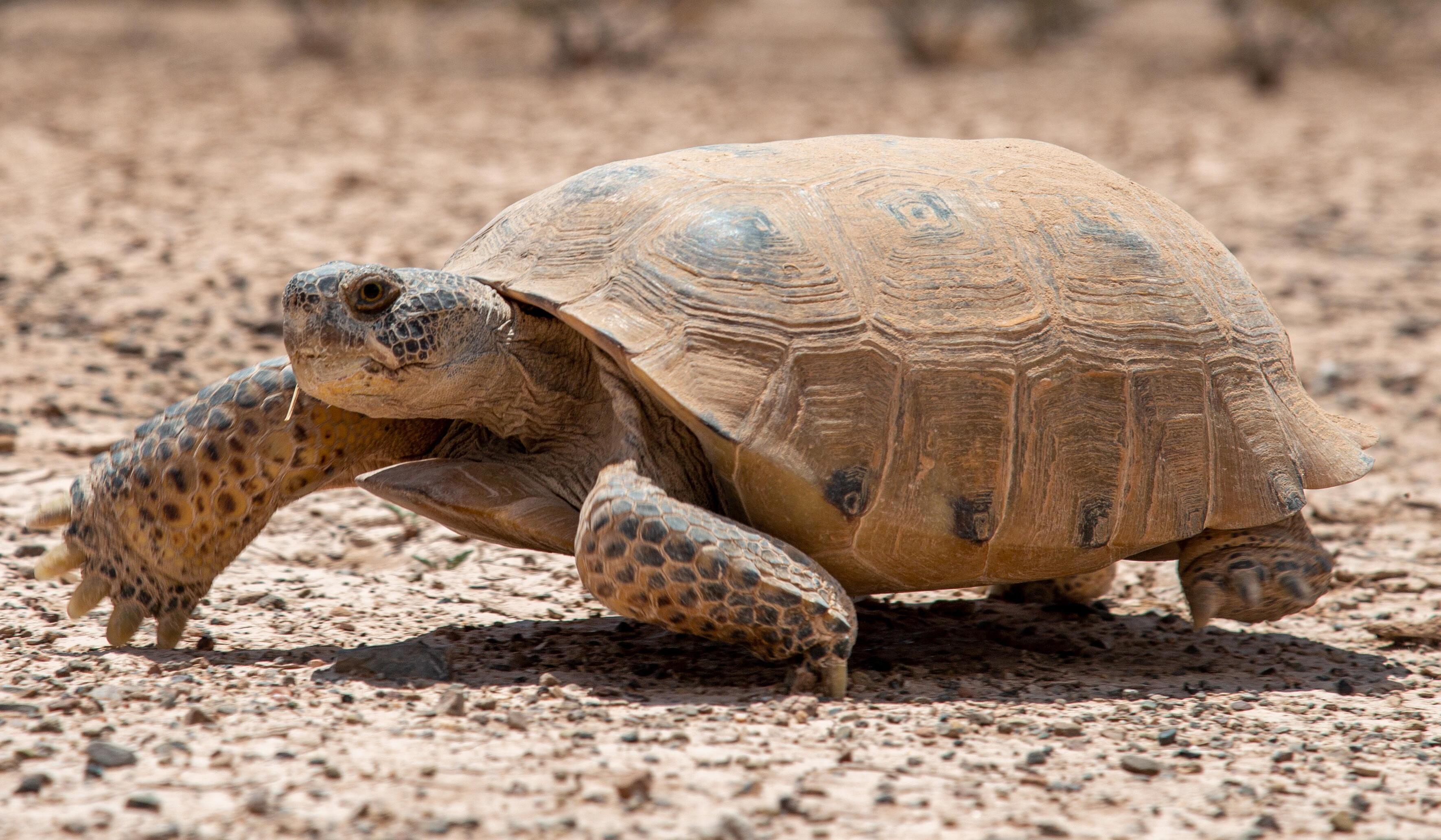
BolsoN Tor T oise
Gopherus flavomarginatus Legler 1959 Mexico
In the late Pleistocene and early Holocene, the Bolson Tortoise, Gopherus flavomarginatus, ranged throughout the Chihuahuan Desert from central Mexico to southern Texas, New Mexico, and Arizona. It now survives only in the Bolsón de Mapimí, a small interior basin in northern Mexico. The species is large, reaching 40 cm shell length, and digs large burrows, which it shares with a host of other animals, making it a keystone species for the Chihuahuan Desert. Animals take over 15 years to reach sexual maturity and females produce only 1–3 clutches of about 5 eggs each per year, so its populations only recover slowly from mortality events. This species is threatened most by agricultural development, but also by local use for food and pets. The Mapimí Biosphere Reserve was established in 1977 to protect the Bolson Tortoise and its ecosystem.
IUCN Red List: Critically Endangered
Within the Biosphere Reserve, land has been privately purchased by local and international conservation organizations, creating the Bolson Tortoise Ecosystem Preserve. The Preserve includes Rancho San Ignacio (17,540 ha), entirely within the Biosphere Reserve, and Rancho Guimbalete (7,794 ha), at the edge of the Biosphere Reserve. Both properties have substantial populations of the Bolson Tortoise. In New Mexico in the United States, the Turner Endangered Species Fund has captive-bred more than 800 animals for a rewilding / repatriation program. Over 150 animals have so far been released into the wild on private land. This experimental project has been very successful thus far, with less than 5% annual mortality. Further rewilding efforts are planned to include public as well as additional private lands in New Mexico, Texas, and eventually, Mexico.
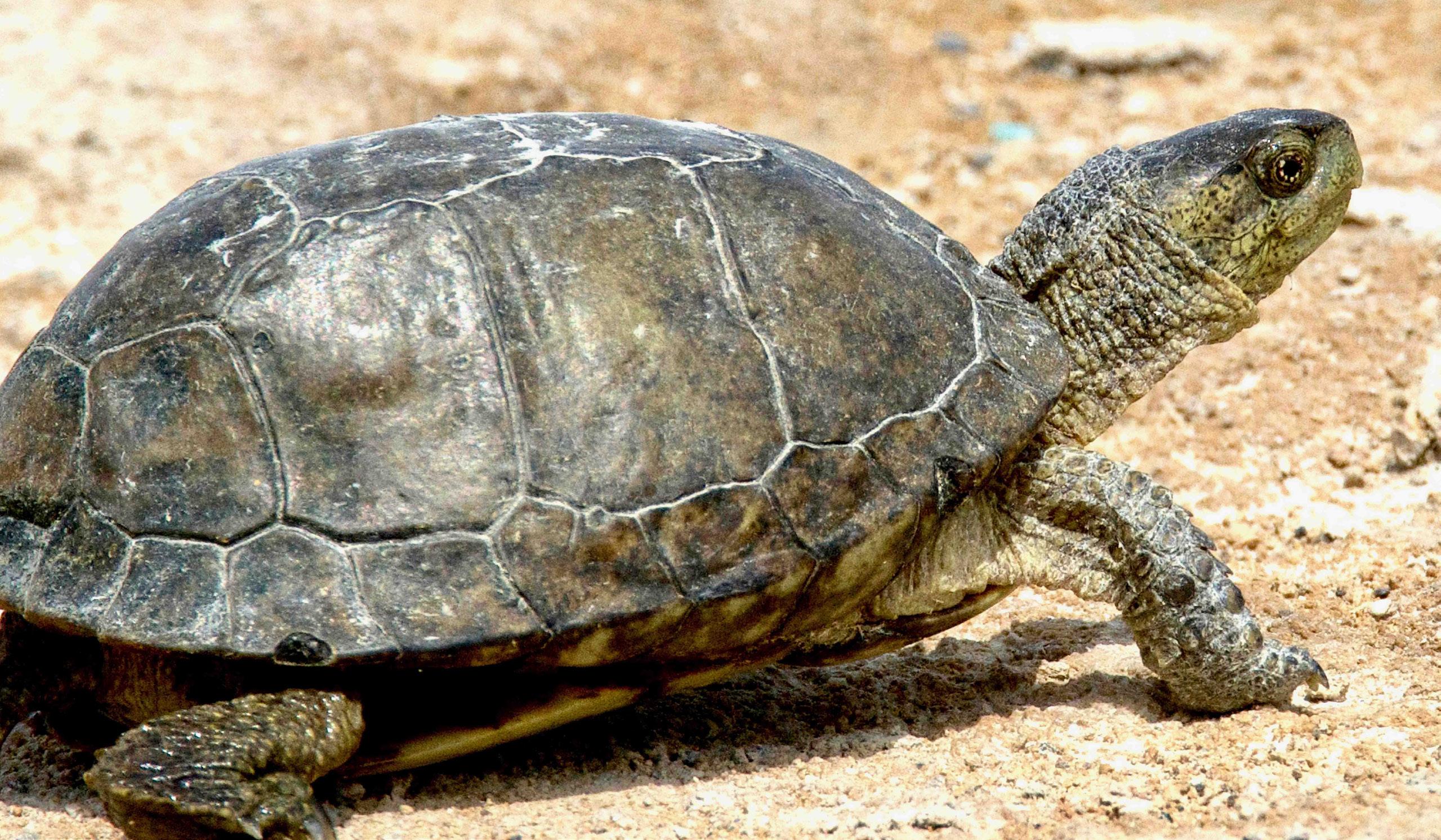
c oahuilaN Box Tur T le
The Coahuilan Box Turtle, Terrapene coahuila, has one of the most retricted ranges of any turtle in the western hemisphere, confined to ponds and wetlands in a narrow geographic distribution within the Cuatro Ciénegas basin in northern Mexico. It occupies no more than 7 km2 in small, scattered patches of water within the protected area of Cuatro Ciénegas. Its wetlands have suffered a dramatic water level decline for the last 30 years due to extraction for agriculture, causing habitat loss and fragmentation. The species is found in pools and shallow wetlands often no more than 10 cm deep, where it can be seen foraging for animal and plant foods. It is occasionally encountered on land moving between pools. The species has been found to migrate up to 10 km between wetlands.
Coahuilan Box Turtle populations have plummeted in most of the wetlands which they formerly occupied.
In 1974, the population density was estimated at 148 turtles per hectare in proper habitat, with a total population of approximately 10,000 turtles. A more recent estimate in 2008 indicated a dramatic reduction to between 1 and 67 turtles per hectare. Currently only one population has densities close to 25 turtles per hectare; most wetlands have densities as low as 3 turtles per hectare. Current population estimates are close to 2,000 individuals. Habitat loss and fragmentation are severe threats for the species. Water extraction is still lowering the water table, changing the landscape and reducing the habitat and food availability for the species. Local efforts are gaining commitment and landowners are becoming involved in local conservation efforts to promote its conservation, and a large tract of intact turtle habitat was recently purchased by an international conservation organization.
Terrapene coahuila Schmidt & Owens 1944 Mexico
IUCN Red List: Critically Endangered
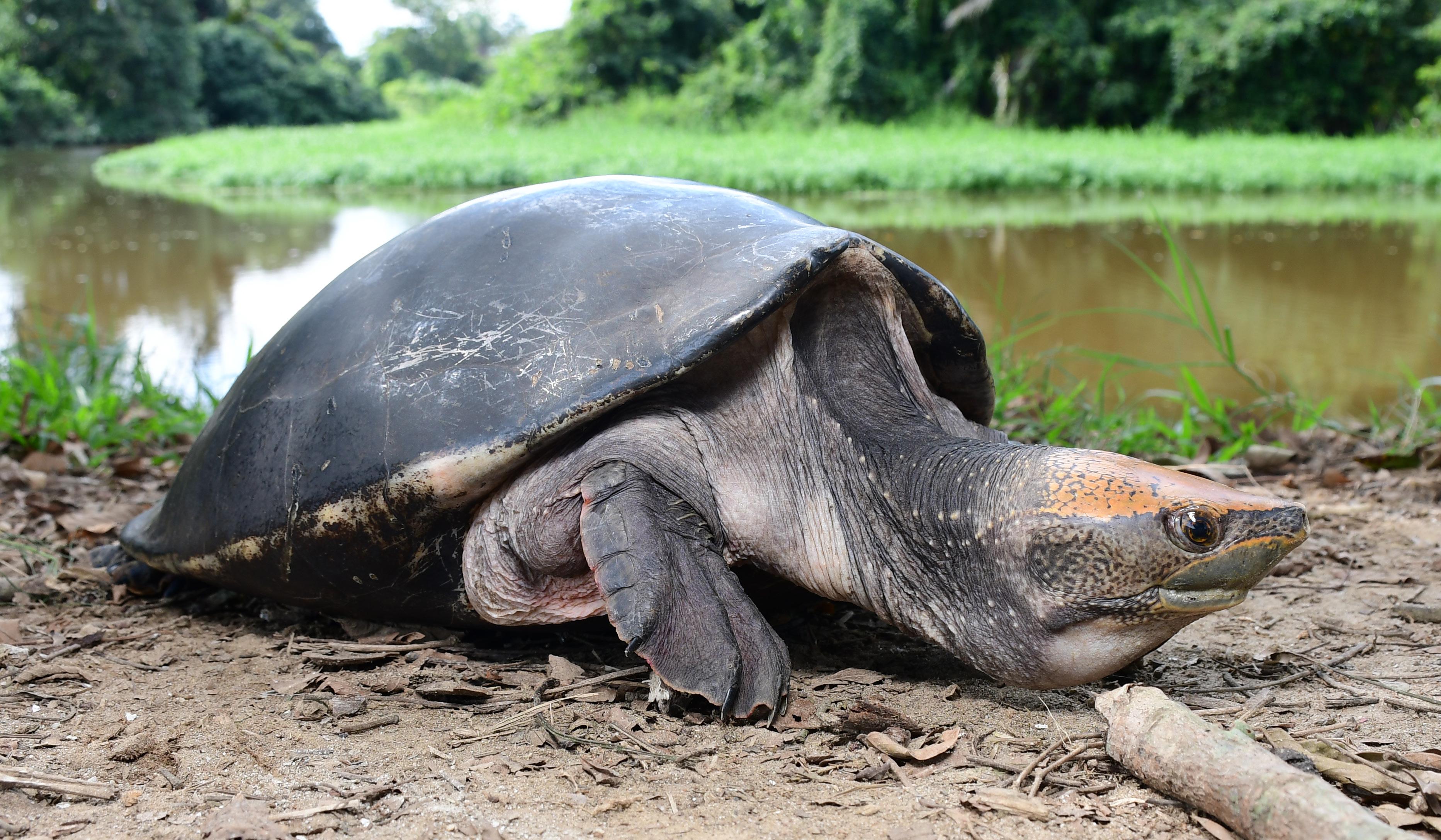
c e NT ral a merica N r i V er Tur T le
Dermatemys mawii Gray 1847
Belize, Mexico, Guatemala
The Central American River Turtle, Dermatemys mawii, is the last remaining representative of a turtle family that dates back 65 million years. The species reaches 65 cm in shell length and can weigh up to 22 kg. Males can be distinguished by their golden-yellow heads. The species is entirely aquatic, inhabiting freshwater systems in southern Mexico, Guatemala, and Belize. It spends most of its time on the bottom in deep water. Almost entirely herbivorous, it consumes shoreline vegetation (grasses, leaves), fallen fruit, and detritus. Females lay eggs at the water’s edge, primarily in December and January. Eggs remain underwater and begin development only when water levels drop. This period of embryonic diapause or dormancy may explain the wide range in incubation periods (115–223 days) reported under captive conditions. Reported mean clutch size ranges from 14.8 (wild) to 9.4 (captive).
IUCN Red List: Critically Endangered
Consumption of this species has driven intensive collection, particularly for Easter festivals. A range of conservation measures are urgently needed to preserve the future of this species. The highest priority includes enforcement of existing protection regulations, developing, coordinating, and implementing a comprehensive conservation and recovery strategy, and public education programs. The Belize Foundation for Research and Environmental Education (BFREE) established a captive facility with 45 adults to investigate the reproductive biology of this species and to build assurance colonies to aid in reintroductions in Belize. The facility has produced more than 1,400 turtles, of which more than 900 have to date been released into the wild. Conservation efforts and field surveys are also underway in southern Mexico and Guatemala.
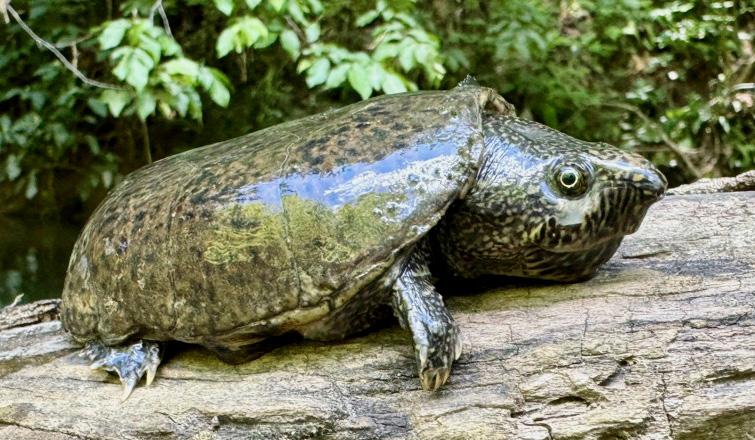
f
laTT e N ed m usk Tur T le
Sternotherus depressus Tinkle & Webb 1955 United States
Among the smallest and rarest of North America’s turtles, the Flattened Musk Turtle, Sternotherus depressus, is endemic to the rocky streams of the Black Warrior River system in north-central Alabama. Growing to only 10–12 cm in shell length, the low profile of its compressed carapace enables better access to rock crevice cover. Most of its small range coincides with the Warrior Coal Field in which mining has wreaked destruction over the better part of a century. Additionally, the expansion of industrial chicken production and urban development in recent decades has degraded nearly all remaining habitat. A hardwired affinity to rock crevices and freshwater mollusks leaves the species with a limited ability for adaptation to streams filled with
IUCN Red List: Critically Endangered
sediment and devoid of snails. Extirpated from a majority of the watershed, viable populations persist in less than 7% of their historic range while scattered relict groups blink out in isolation. In parts of its range, the species faces the added risk of genetic pollution through hybridization with the closely related Stripe-necked Musk Turtle (S. peltifer). Poaching for the pet trade is an ongoing threat to the limited number of turtles that remain.
Concern for the species in recent years has generated interest in research and conservation efforts. Plans for captive assurance colonies are being devised to preserve genetic diversity from fading populations and produce stock to reintroduce and augment wild populations in conjunction with ongoing stream restoration projects.
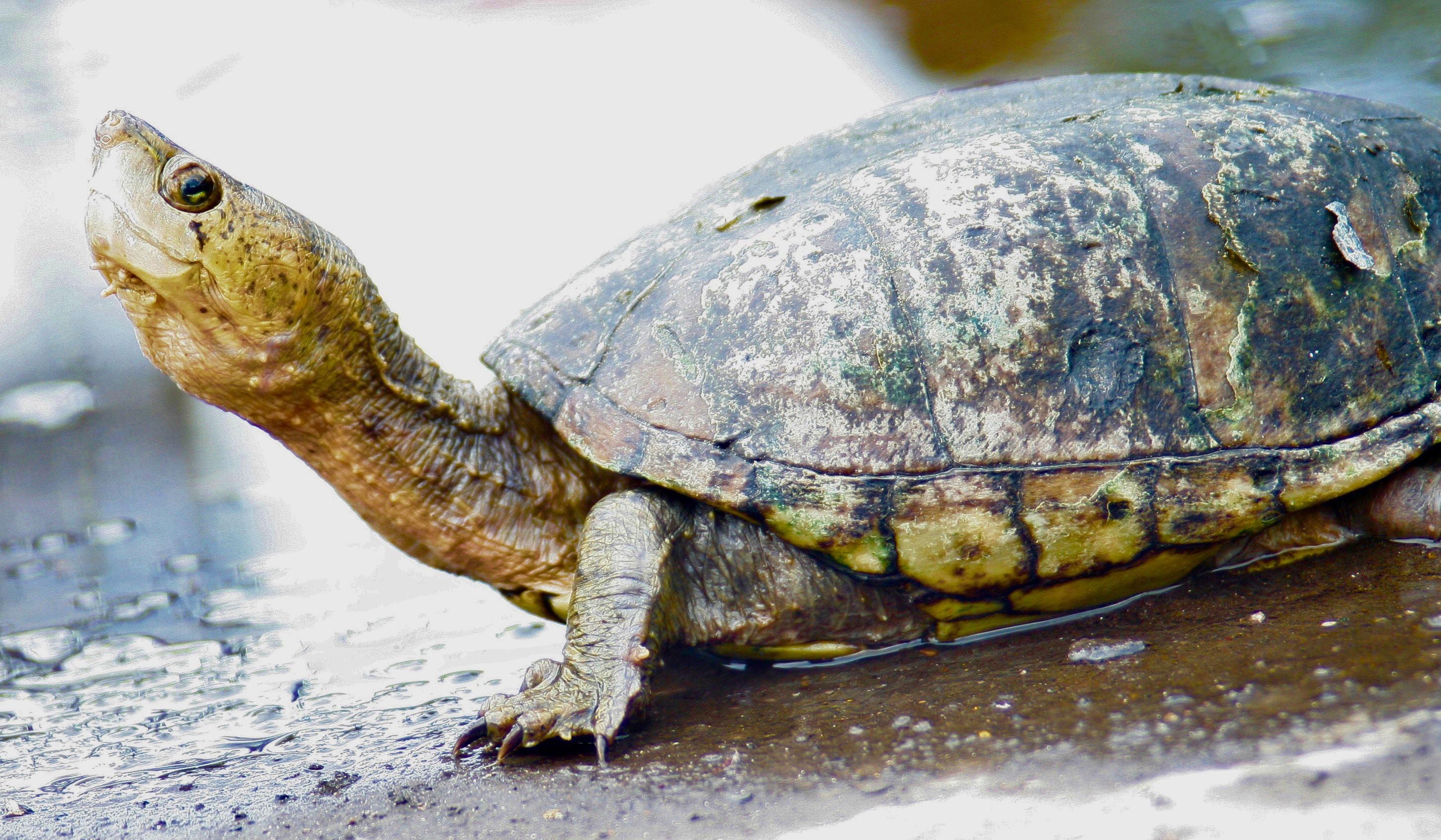
Valley of m exico m ud Tur T le
Kinosternon hirtipes hirtipes (Wagler 1830)
Mexico
The Rough-footed Mud Turtle, Kinosternon hirtipes, is a complex of several subspecies broadly distributed from central Mexico to southwestern Texas. The Valley of Mexico Mud Turtle, Kinosternon hirtipes hirtipes, is a medium-sized subspecies currently restricted to perennial wetlands in the eastern and southeastern parts of the Valley of Mexico. Its indigenous historical distribution area was about 5,620 km 2 , most of which has been lost to massive development and urbanization, as this taxon inhabits the most populated area of Mexico. The subspecies has been highly exploited since pre-Columbian times, which, along with habitat loss and degradation, made it almost impossible to find any animals since the mid-20th century. Recently, very few individuals have been captured in a small wetland in Mexico City, but it is still a very elusive and apparently
TFTSG Red List (in press): Critically Endangered
severely depleted subspecies. Several species of exotic turtles have been reported in its remaining habitat, including the ubiquitous Mexican Mud Turtle (K. integrum), and the invasive Red-eared Slider (Trachemys scripta elegans).
The taxon’s population ecology is unknown, but it was described as abundant in the early 20th century. No targeted conservation programs have been proposed to protect this taxon, but it is protected under Mexican Government Species Act and was recently included in CITES Appendix II. The wetlands inhabited by this turtle are protected under the RAMSAR convention on wetlands. Its specific population levels and trends are unknown, but it is currently considered Critically Endangered on the IUCN Red List (in press).
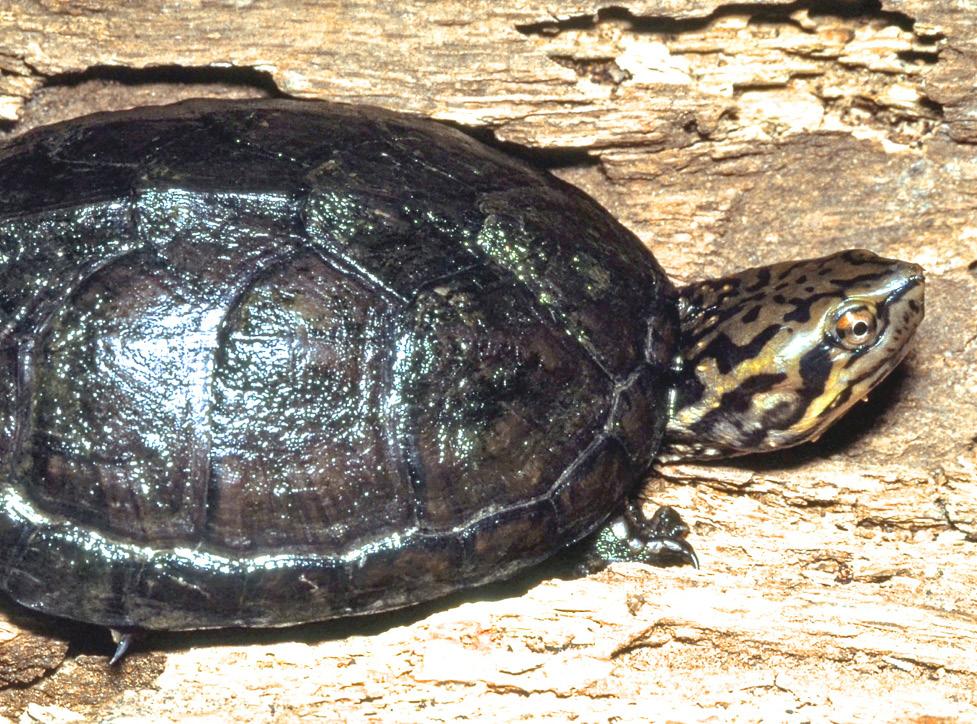
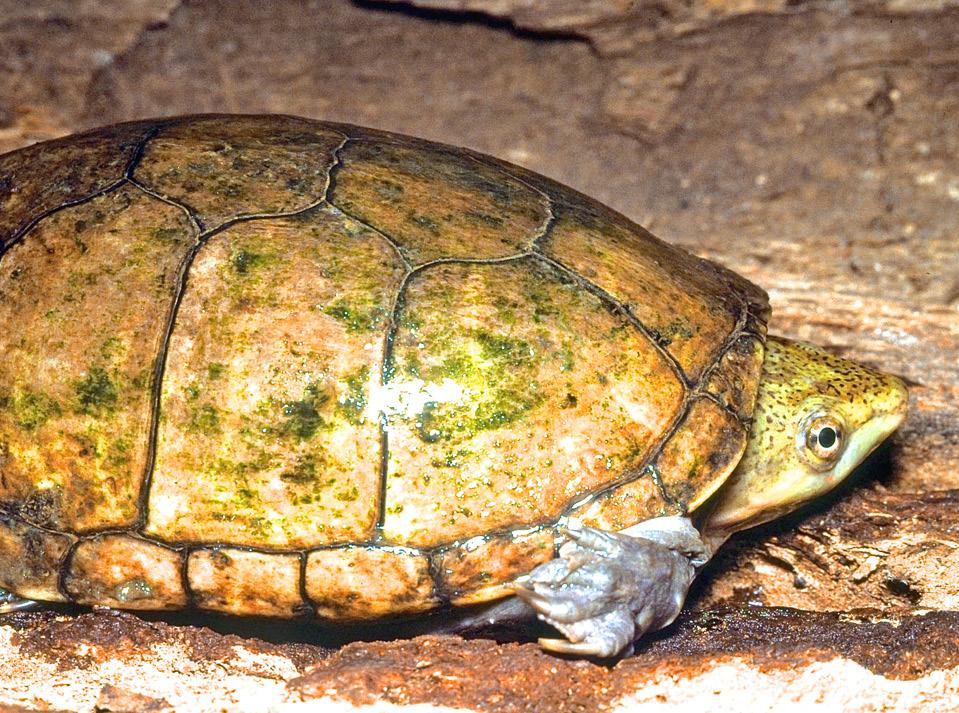
San JuaniC o m ud t urtle
Kinosternon hirtipes chapalaense
TFTSG Red List (in press): Critically
The Chapala Mud Turtle, Kinosternon hirtipes chapalaense, is a medium-sized, restricted-range subspecies that was found in freshwater wetlands of Lake Chapala and Lake Zapotlán in western Mexico. Its historical distribution covered approximately 5,359 km2 , but animals are now difficult to find. The taxon shares its habitat with its widespread related species, the Mexican Mud Turtle (K. integrum), which occupies lake margins, canals, springs, and other perennial aquatic habitats. Recent records of K. h. chapalaense exist only from Zapotlán Lake. Chapala Lake is heavily modified, degraded, and intensely used for fisheries. Seasonal aquatic habitats of Chapala are now dominated by K. integrum in high densities.
The Chapala Mud Turtle is slightly smaller than other members of the species; females are generally larger than males. Males have reduced plastrons, while females have larger ones, possibly indicating greater use of terrestrial environments. The population ecology of this subspecies is unknown, with very few records in the past decade. As with other members of the K. hirtipes species complex, this turtle is protected under the Mexican Government Species Act, listed in CITES Appendix II, and parts of its historical habitat are designated as RAMSAR sites.
TFTSG Red List (in press): Critically Endangered
The San Juanico Mud Turtle, Kinosternon hirtipes magdalense , is another restricted-range taxon that is found only in a 694 km 2 area. It is a small turtle that only occupies a few spring-fed wetlands and a small dam in the Magdalena basin in the vicinity of Jalisco and Michoacán states in west-central Mexico. The remaining populations face several threats, such as habitat loss and degradation, the introduced Mexican Mud Turtle (K. integrum), the presence of subsidized predators, and intense fishing using gillnets in the dam and springs in the area.
The ecology of this species is unknown, and the few individuals located in recent years showed signs of predation and scars of interactions with other turtles. The aquatic habitats, although degraded, are still viable and suitable for restoration for the potential recovery of the subspecies, which is also protected by Mexican Government and listed under CITES Appendix II. It does not occur in any protected areas. There is potential for initiating a management plan for this subspecies, but conservation work in its range is currently problematic due to drug cartel activity.
Iverson 1981
Cha Pala m ud t urtle
Kinosternon hirtipes magdalense
Iverson 1981 Mexico
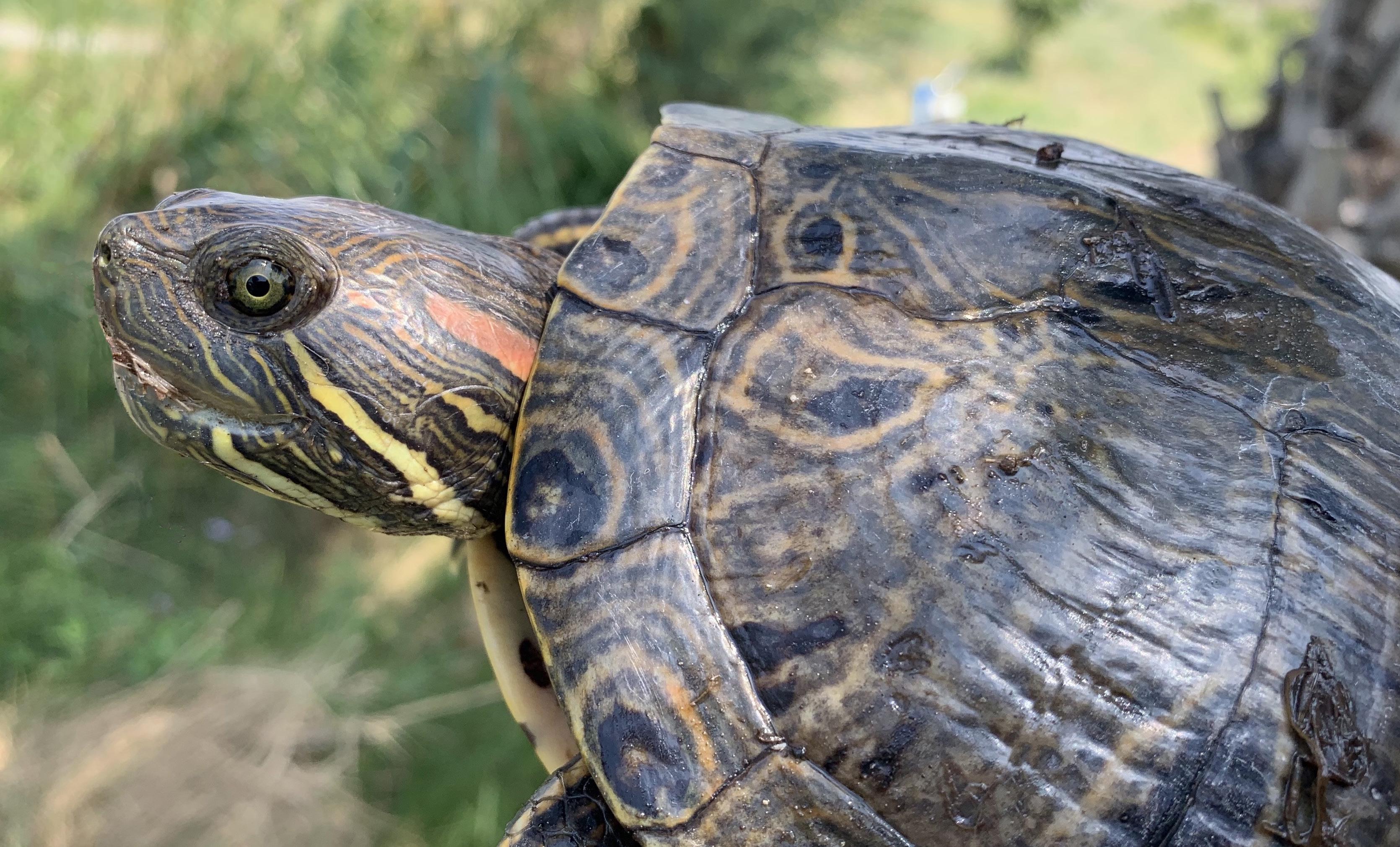
c uaT ro c ie N egas s lider
Trachemys taylori (Legler 1960) Mexico
The Cuatro Cienegas Slider, Trachemys taylori, is found in wetlands within the Cuatro Ciénegas Valley of northern Mexico. Some genetic analyses suggest it should be considered a subspecies of the Eastern Central American Slider, Trachemys venusta. In 1960, the Cuatro Cienegas Slider was reported to be more abundant—approximately 4.2 times more common—than other turtles in the valley. Conservationists worry about the species’ vulnerability to hybridization with invasive turtles, such as T. venusta and the Red-eared Slider, T. scripta. The latter has been documented in the valley on at least two occasions, in 2006 and 2024.
The Cuatro Cienegas Slider’s range is estimated at around 887 km2 , predominantly restricted to aquatic environments in the Cuatro Ciénegas Valley. Although current population densities are unknown, an effective
IUCN Red List (in press): Critically Endangered
population size of approximately 300 individuals was estimated in 2012, and was characterized by low genetic flow, high inbreeding, and minimal genetic differentiation among populations. Historical analyses suggested a population bottleneck. The species’ inhabited wetlands have been shrinking for the last 40 years. Local populations exhibit significant density variation. Populations seem to comprise mostly adults (>70%), though the presence of juveniles at some locations indicates some level of population recruitment. The Cuatro Cienegas Slider is classified as Critically Endangered on the IUCN Red List (in press) due to its susceptibility to hybridization, habitat loss, and fragmentation. Its current area of occupancy is less than 10 km2 in a heavily degraded ecosystem impacted by human activities.
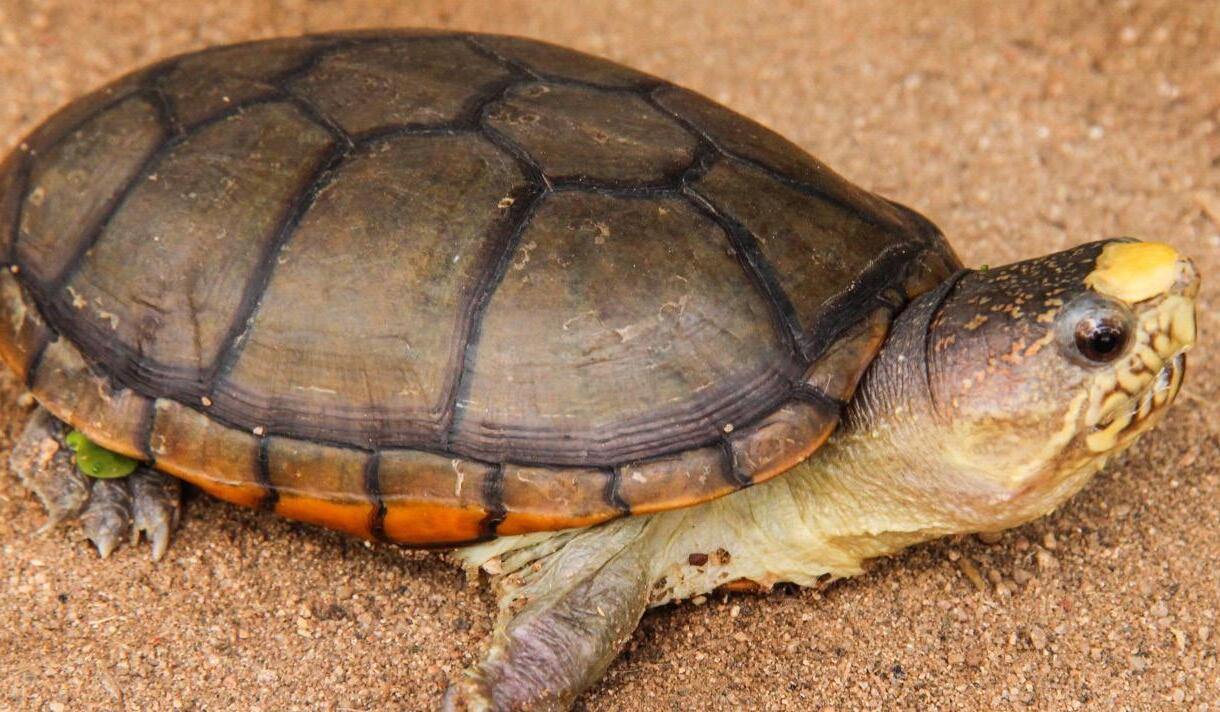
Vallar T a m ud Tur T le
Kinosternon vogti López-Luna, Cupul-Magaña, Escobedo-Galván, et al. 2018 Mexico
The recently described Vallarta Mud Turtle, Kinosternon vogti, is the smallest turtle species, rarely exceeding 9.5 cm in shell length. Its habitat is confined to the Bahía de Banderas Valley in western Mexico, and has been reduced to less than 0.25 km2 of suitable remaining wetland areas. The species’ habitat is under severe threat due to rapid urbanization, agriculture, and tourism development in this region, particularly in and around Puerto Vallarta. Over the past few decades, more than 99% of its native habitat has been lost.
The remaining habitat for the species is highly fragmented, and the turtle is now confined to small patches of wetlands. No formal protected areas exist for the species. It has been included in CITES Appendix I since 2022 to help curb the illegal trade in the species, which is further driven by its small size and appealing appearance, particularly the males’ bright yellow snout shield.
IUCN
The biggest threat to the species is the continued destruction of its habitat. Between 2022 and 2024, nearly 30% of the remaining wetlands were destroyed. Poaching, road mortality, competition from other turtle species, and wildfires also pose threats. It is currently estimated that fewer than 300 specimens remain in the wild. Conservation efforts include the creation of ex-situ assurance colonies, habitat protection and road mortality mitigation, increased law enforcement, local outreach and awareness, and stakeholder engagement. Protection of the remaining habitats and the creation of artificial wetlands are essential to save the species. The first-ever captive reproduction of this species was achieved in 2023, offering a glimmer of hope that the species might survive in captivity. Poaching and theft have increased since 2024 due to international demand, contributing to a sharp decline in the species’ wild population.
Red List: Critically Endangered
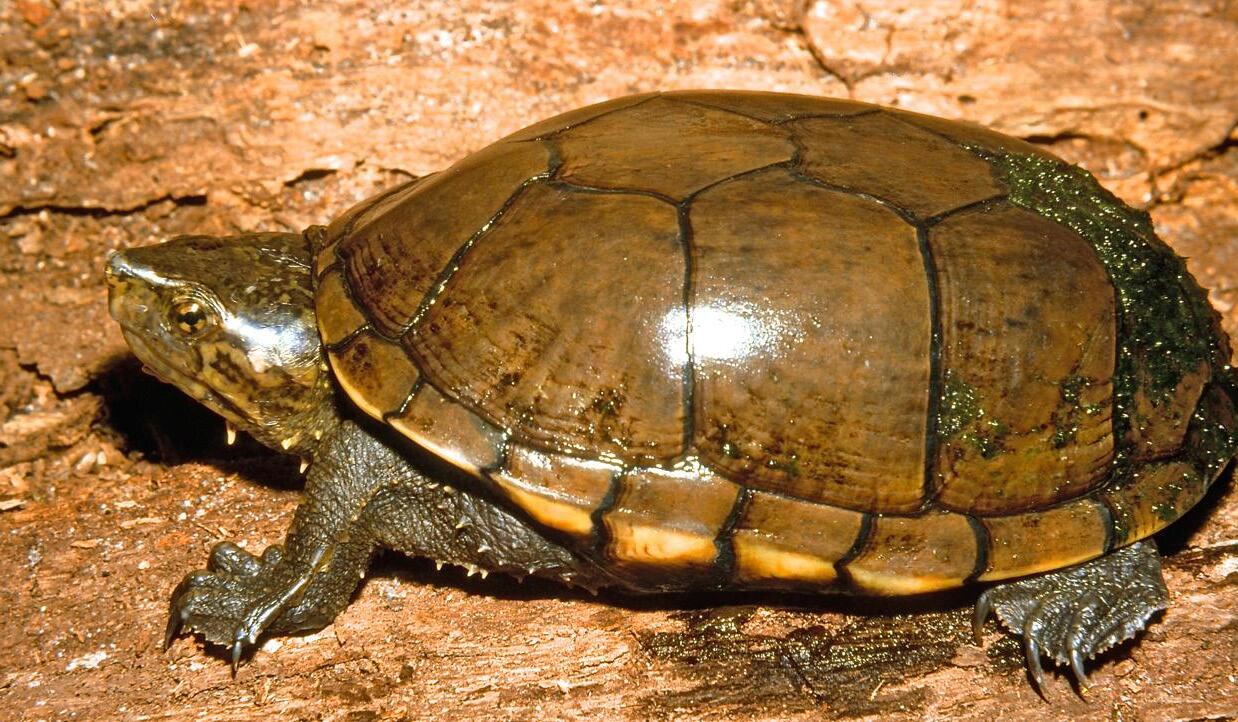
Sonoyta Mud t urtle
Kinosternon sonoriense longifemorale Iverson 1981 United States, Mexico
The Sonoyta Mud Turtle, Kinosternon sonoriense longifemorale, is a rare and localized subspecies of the more widely distributed Sonoran Mud Turtle, K. sonoriense. It occurs only in a small area straddling the international border between Arizona in the United States and the Mexican state of Sonora. On the American side, it occurs only in the small 5-hectare spring-fed pond at Quitobaquito in Organ Pipe Cactus National Monument, where a population of approximately 150 animals is monitored and maintained through periodic management of the pond and its water level. On the Sonoran side, the turtle occurs in drainages of the Rio Sonoyta and also on indigenous lands of the Tohono O’odham Nation.
IUCN Red List: Critically Endangered
On both sides of the border, the turtles are highly dependent on water levels in their habitats, and a dropping water table is the greatest threat to their survival. The small pond at Quitobaquito was given US federal protection in 2020, although the construction of the border wall less than 100 m away has had an undocumented, but undoubtedly harmful effect on the population’s status and future. Field surveys on the Mexican side of the border have only recently been undertaken. A captive breeding program at the Arizona-Sonora Desert Museum aims to establish a multi-location assurance colony to ensure the future of the taxon and to undertake eventual releases to bolster the remnant wild population.
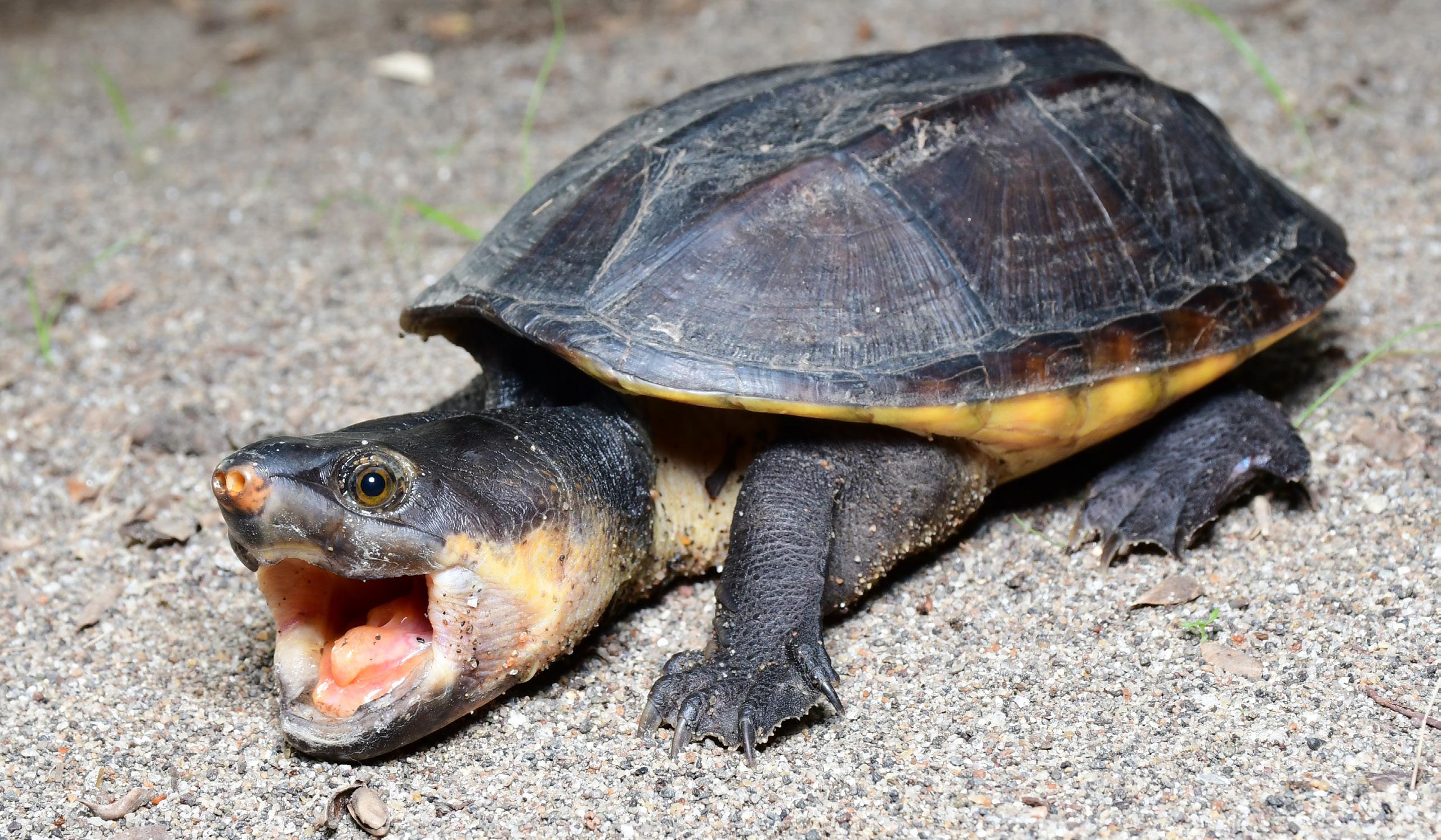
Pacific c oas T m usk Tur T le
Staurotypus salvinii (Gray 1864) Mexico, Guatemala, El Salvador
The Pacific Coast Musk Turtle, Staurotypus salvinii, is the smaller of the two species in the genus Staurotypus. This medium-sized turtle (females to 23 cm, males to 20 cm) is restricted to the lowlands (<150 m altitude) of the Pacific Coast of southeastern Mexico, Guatemala, and El Salvador. Females and males are similar but can be distinguished by the males’ thicker and longer tails.
The species is omnivorous, and primarily inhabits lentic, temporary, or permanent aquatic systems, including coastal wetlands with mangroves. Basic information on populations, movement patterns, reproduction, and habitat use are lacking. Previous studies that have been conducted took place between the 1980s and the early 2000s and assessed wild populations in Chiapas, Mexico. Current studies suggest a drastic decline in the survival of these wild populations, with more
IUCN Red List (in press): Endangered
than half of them extirpated from this region of Mexico. Nothing is known about the species in Guatemala or El Salvador.
Throughout its range, local people eat the species. Reasons for its consumption include alleged aphrodisiac properties, medicinal benefits (alleged cures for cancer or respiratory diseases), and religious significance (as part of a meal during Holy Week). At both national and international levels, this turtle is sold as a pet, with light-colored adults being the most sought after. Additionally, habitat loss, pollution, and frequent human-induced fires within its distribution area contribute to the dramatic decline of wild populations. Given the high levels of human consumption and habitat loss, there is a need to monitor wild populations to better understand their status, and establish local conservation programs.
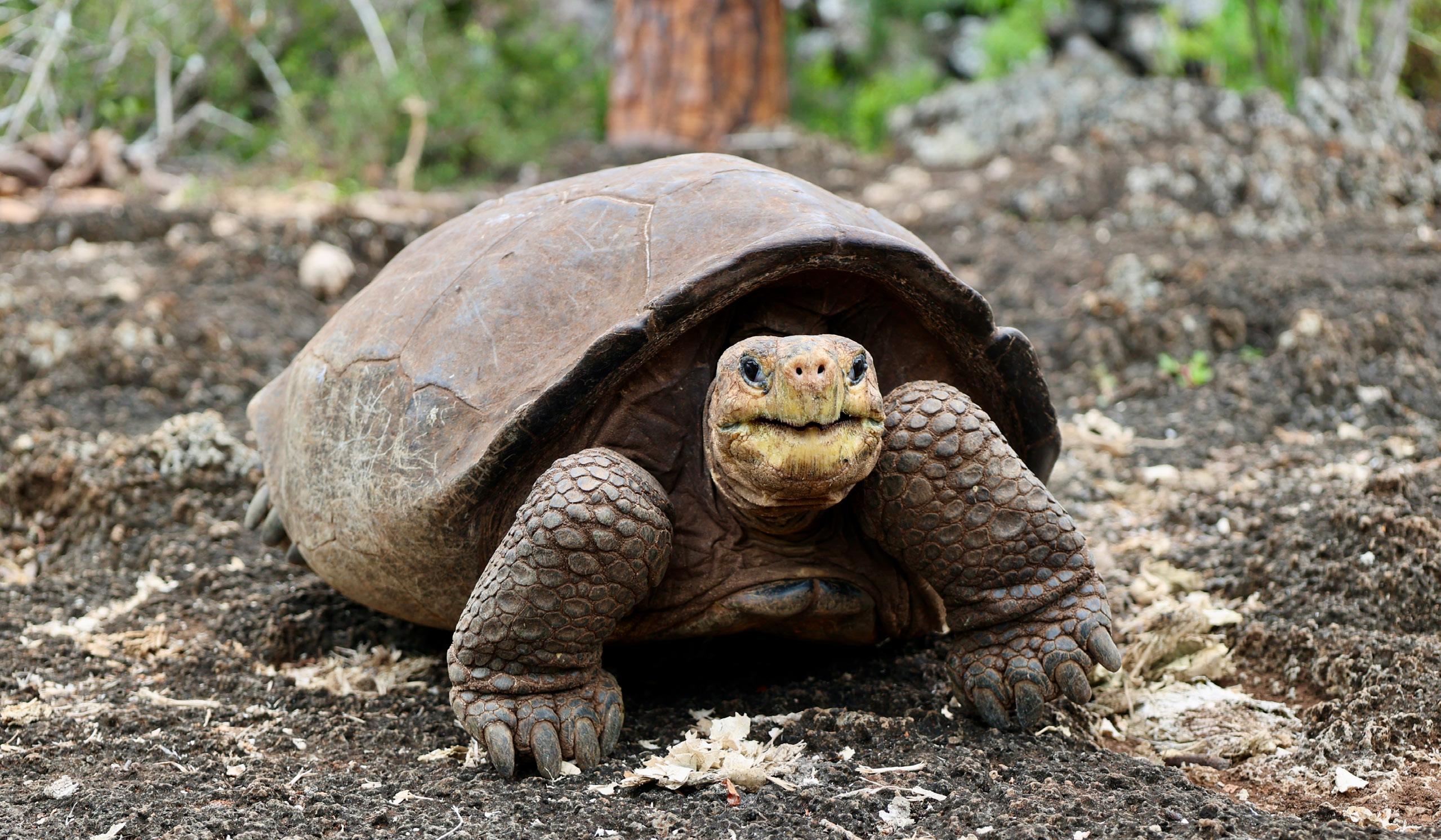
f er N a N di N a gia NT Tor T oise
Chelonoidis niger phantasticus (Van Denburgh 1907) Ecuador
The Fernandina Giant Tortoise, Chelonoidis niger phantasticus, previously known only from a single large old male collected in the Galápagos in 1906 and long thought possibly extinct, was rediscovered in 2019 with the finding on Fernandina of a single live smaller adult female, dubbed Fernanda. This rediscovery underscored the resilience of nature and raised hopes for the possible resurrection of the species.
Genomic analysis subsequently confirmed the female to be the same subpecies as the male, and genetically distinct from all other Galapagos Tortoises, thereby confirming the survival of the Fernandina Giant Tortoise.
Following Fernanda’s identification, four expeditions were conducted across all suitable tortoise habitats on Fernandina, but no additional tortoises were found. These findings indicate Fernanda’s status as potentially the last of her kind, likely following in the
IUCN Red List: Critically Endangered
tragic footsteps of Lonesome George, the last Pinta Giant Tortoise, who died in 2012.
Currently housed at the Galápagos National Park’s Tortoise Center, Fernanda’s future remains uncertain as Park authorities consider possible last-hope conservation measures.
The persistence of the Fernandina Giant Tortoise represents a delicate balance between hope and urgency. As genomic tools refine our understanding of species dynamics and offer some potential hope in the form of genetic back-breeding, as has already been initiated for two other “extinct” Galápagos tortoise subspecies, the Pinta Giant Tortoise (C. n. abingdonii) and Floreana Giant Tortoise (C. n. niger), Fernanda serves as a poignant reminder of the fragility of island ecosystems and the imperative to act decisively in a timely manner in conserving Earth’s biodiversity.
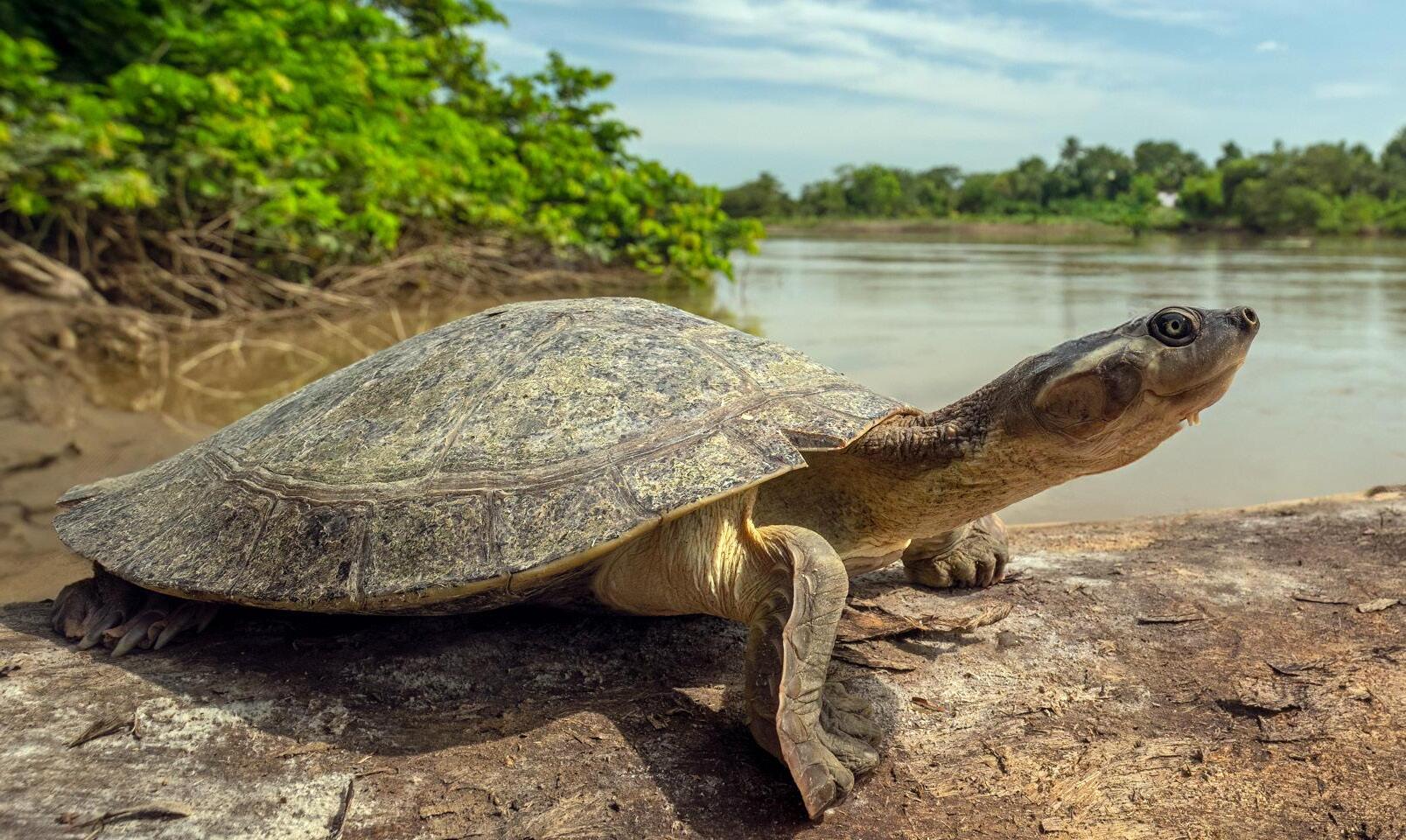
m agdale N a r i V er Tur T le
Podocnemis lewyana Duméril 1852 Colombia
The fairly large Magdalena River Turtle, Podocnemis lewyana , growing up to 50 cm in shell length, is endemic to Colombia. It is the only Podocnemididae species found northwest of the Andes. It faces major threats from hunting and commercial exploitation, leading to population declines, particularly among adult females. The species is highly vulnerable during Lent, when demand for turtle meat peaks. Habitat loss from deforestation, agriculture, and hydroelectric plants disrupts its life cycle, reducing food, nesting sites, and causing flooding that leads to egg mortality. Other threats include cattle trampling nests, domestic animals consuming eggs, and mercury contamination from illegal gold mining.
IUCN Red List: Critically Endangered
The geographic range of the Magdalena River Turtle lacks officially protected areas, leaving it vulnerable to various threats. However, in 2024, the lower basin of the Sinú River was designated as a Key Biodiversity Area (KBA) due to its importance in preserving half of the genetic diversity of this species. Despite laws prohibiting the commercial exploitation of this turtle, weak enforcement offers little protection. Environmental education and head-starting programs are in place to promote its value and boost juvenile survival. In the Sinú River, hatch-and-release initiatives help increase hatchling recruitment amidst hydroelectric flooding challenges. More conservation efforts are still urgently needed, including establishing protected areas and raising public awareness.
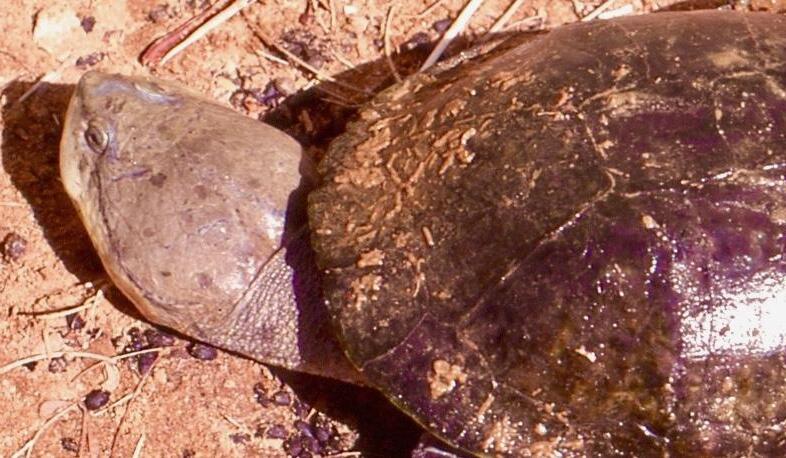
Zulia Toad-headed Tur T le
Mesoclemmys zuliae (Pritchard & Trebbau 1984) Venezuela
The Zulia Toad-headed Turtle, Mesoclemmys zuliae , is highly endangered and little known. In the 40 years since it was described, fewer than 30 individuals have been located. Geographic records have helped improve knowledge of its distribution area, but other key aspects of its biology remain unknown. It is a secretive, bottom-dwelling species, usually buried in the bottom of swamps and wetlands in lentic environments, and only occasionally sighted by local people. Specimens have been found in canals and swamps when earthworks are carried out with heavy machinery. It is undoubtedly rare, probably found only in particular microhabitats. Large-scale and persistent threats to
IUCN Red List (in press): Critically Endangered
this endemic species of the Lake Maracaibo basin in Venezuela include diversion of river channels, construction of walls and dams, sedimentation, expansion of banana and oil palm plantations, drying out of creeks, invasive and accelerated establishment of shrimp farms, water pollution, and introduction of exotic animal species. This turtle, predominantly dark grey, reaches shell lengths of 28 cm, with males smaller than females. It is capable of laying up to 10 eggs per clutch and feeds mainly on invertebrates. It is considered a relict taxon, probably originating from the Proto-Orinoco Basin, as are other species of aquatic or semi-aquatic vertebrates that currently inhabit the Lake Maracaibo basin.
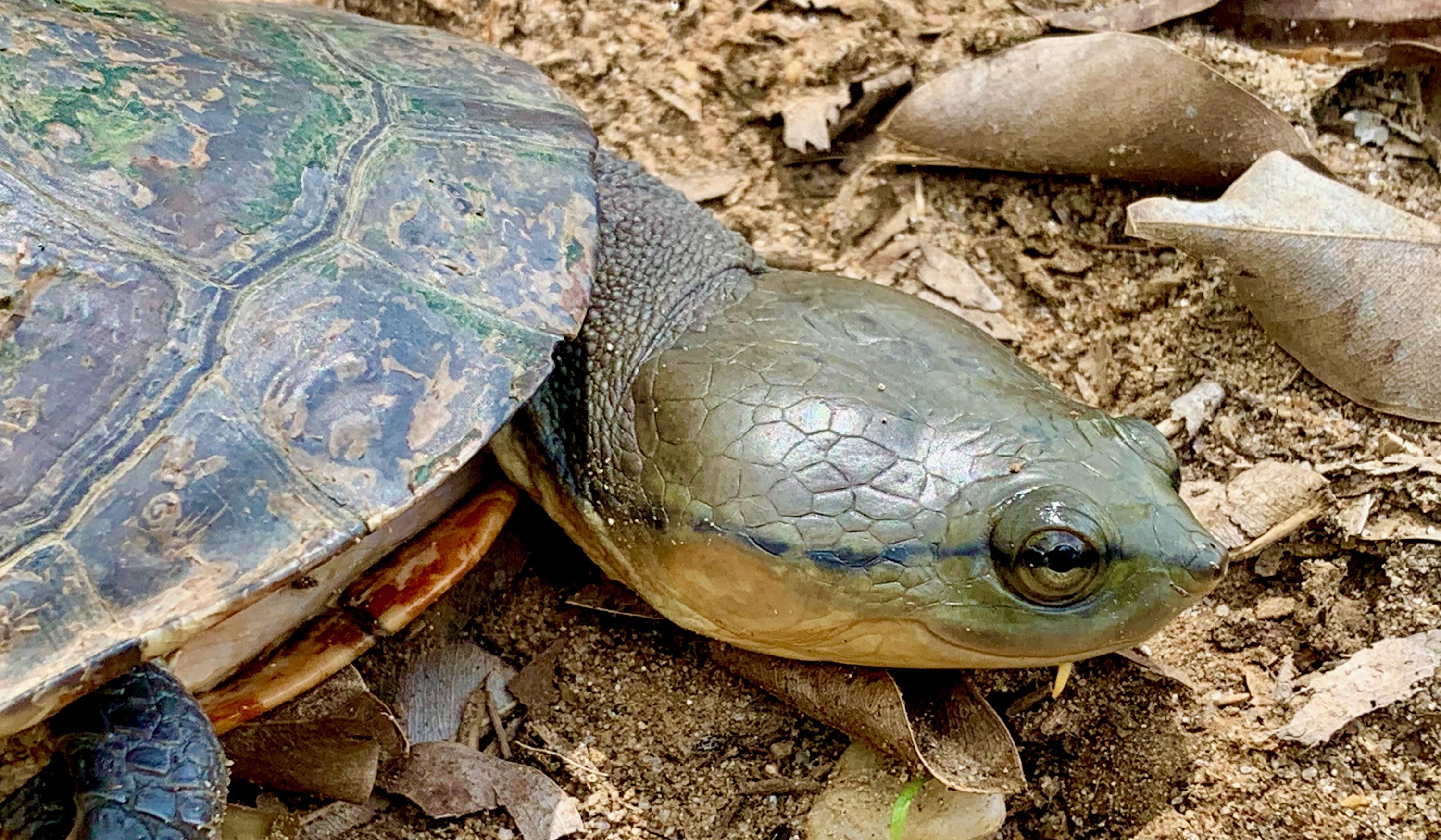
dahl’s Toad-headed T ur T le
Mesoclemmys dahli (Zangerl & Medem 1958) Colombia
Dahl’s Toad-headed Turtle, Mesoclemmys dahli , is a medium-sized (shell length up to 30 cm) semi-aquatic and rare species endemic to northern Colombia. It is the only member of the family Chelidae found northwest of the Andes. It inhabits creeks and ponds in Colombia’s Tropical Dry Forest, an ecosystem that has been heavily transformed, with only 4% of its original extent remaining. The turtle’s global population is very small, estimated to be in the hundreds, and habitat loss has led to isolated populations, resulting in inbreeding and low genetic diversity—factors that increase the risk of extinction by reducing adaptability and reproductive fitness. To address this, a 220-hectare private reserve was established in 2020, where ongoing habitat res-
IUCN Red List: Critically Endangered
toration efforts are expanding wetlands and recovering dry forest vegetation. A genetic rescue program is also underway, translocating turtles from other areas into the reserve to boost gene flow and reduce inbreeding. Agreements with private landowners at multiple sites within the species’ range are also in place to protect and restore riparian vegetation and water courses, improving habitat for the species. In 2024, the reserve was designated as a Key Biodiversity Area (KBA), safeguarding 30% of the species’ genetic diversity and serving as a vital refuge for its survival. A recent updated IUCN Red Listing reassessment of the species’ status has again designated it as Critically Endangered (in press).
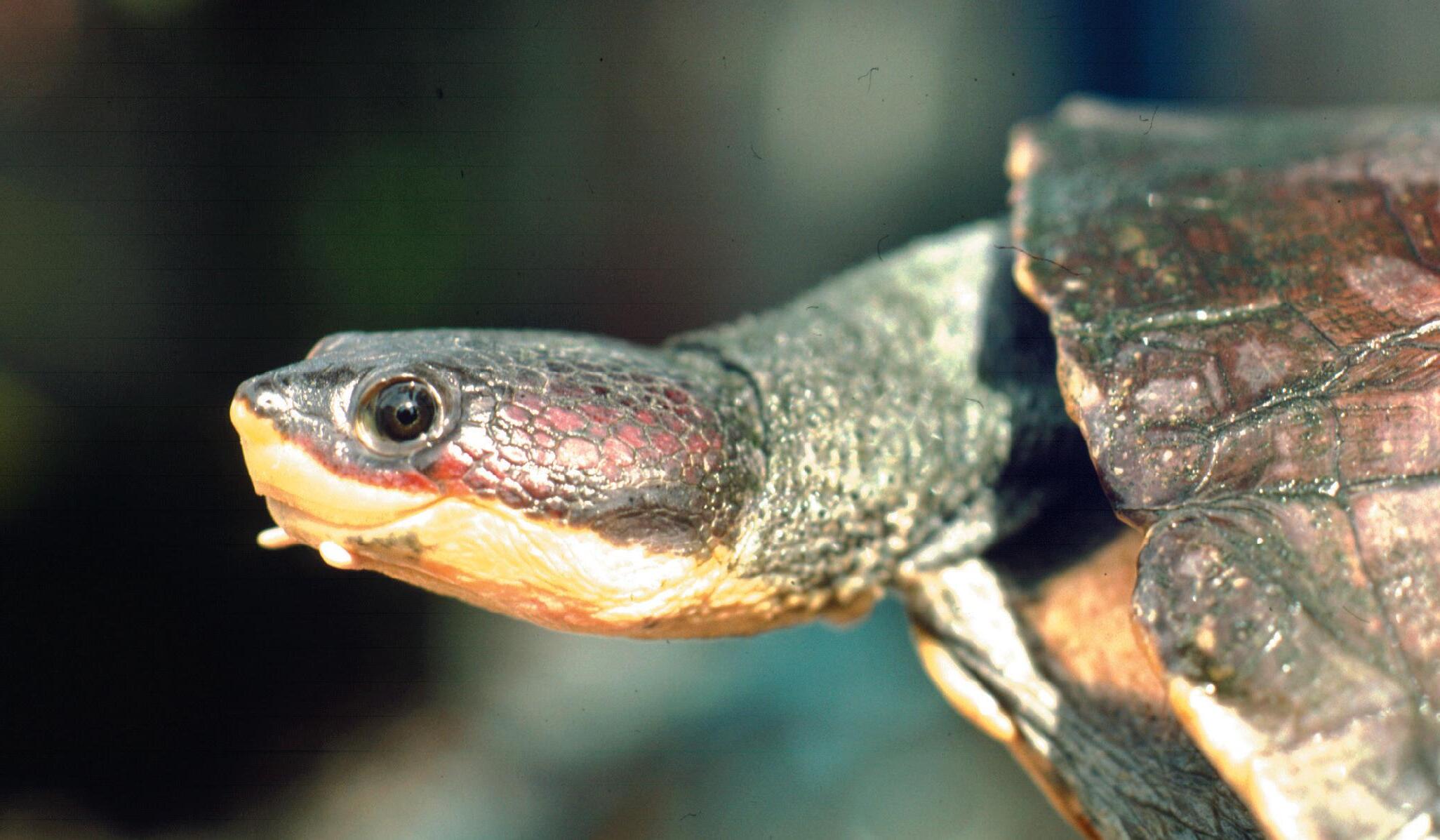
ho G e’s s ide-ne C ked t urtle
Hoge’s Side-necked Turtle, Ranacephala hogei, is a freshwater species endemic to the Atlantic Forest of southeastern Brazil. It reaches up to 36 cm in shell length, with males having a larger tail and a slightly concave plastron. It occurs in one of the most populous regions of the country, in the Brazilian states of Rio de Janeiro, Minas Gerais, and Espírito Santo. It inhabits the lower areas of the hydrographic basins of the Paraíba do Sul, Itabapoana, and Itapemirim rivers, as well as the Lagoa Feia basin and the São Salvador Creek microbasin. The rivers that make up these hydrographic basins have suffered severe impacts of development, with more than 75% of the species’ distribution area having been converted into human-used environments. Recently, field sur-
veys have expanded the species’ known distribution and detected its presence in areas where it was reported historically. These findings indicate its persistence in human-dominated rural landscapes where riparian vegetation still exists. The natural history of this species remains poorly understood, as do the effects of impacts such as habitat fragmentation, heavy metal accumulation, and capture by fishing hooks. Currently, a population of the species is being monitored in the Negro River, a tributary of the Paraíba do Sul River. In addition, an ex-situ management population is being established by the São Paulo Zoo, in partnership with the National Center for Research and Conservation of Reptiles and Amphibians and the Brazilian Association of Zoos and Aquariums.
Ranacephala hogei (Mertens 1967)
IUCN Red List: Critically Endangered
AUTHORS
• Ploughshare Tortoise (Astrochelys yniphora)
Eric V. Goode, Russell A. Mittermeier, and Craig B. Stanford
Photo by Anders G.J. Rhodin
• Radiated Tortoise (Astrochelys radiata)
Andrea Currylow, Craig B. Stanford, and Rick Hudson
Photo by Anders G.J. Rhodin
• Madagascan Big-headed Turtle (Erymnochelys madagascariensis)
Gerald Kuchling and Russell A. Mittermeier
Photo by Anders G.J. Rhodin
• Speckled Dwarf Tortoise (Chersobius signatus)
Victor J.T. Loehr
Photo by Victor J.T Loehr
• Nama Padloper (Chersobius solus)
James O. Juvik and Ernst Baard
Photo by Maurice Rodrigues
• Karoo Dwarf Tortoise (Chersobius boulengeri)
Victor J.T. Loehr
Photo by Victor J.T. Loehr
• Pancake Tortoise (Malacochersus tornieri)
Patrick Kinyatta Malonza and Marc DupuisDesormeaux
Photo by Fabian Schmidt
• Home’s Hinge-back Tortoise (Kinixys homeana)
Luca Luiselli
Photo by Pearson McGovern
• Geometric Tortoise (Psammobates geometricus)
James O. Juvik and Ernst Baard
Photos by Eric V. Goode
• Flat-tailed Tortoise (Pyxis planicauda)
Gerald Kuchling, Russell A. Mittermeier, and Rick Hudson
Photo by Miguel Pedrono
• Spider Tortoise (Pyxis arachnoides)
Andrea Currylow and Craig B. Stanford
Photo by Brett Bartek
• Egyptian Tortoise (Testudo kleinmanni)
Omar Attum
Photo by Basem Rabia
• Nubian Flapshell Turtle (Cyclanorbis elegans)
Luca Luiselli
Photo by Luca Luiselli
• Red River Giant Softshell Turtle (Rafetus swinhoei)
Gerald Kuchling and Luca Luiselli
Photo by Douglas Hendrie
• Painted Terrapin (Batagur borneoensis)
Joko Guntoro
Photo by Douglas Hendrie
• Northern River Terrapin (Batagur baska)
• Red-crowned Roofed Turtle (Batagur kachuga)
Shailendra Singh and Peter Praschag
Photo of Batagur baska by Rupali Ghosh
Photo of Batagur kachuga by Shailendra Singh
• Southern River Terrapin (Batagur affinis)
Sitha Som, Pelf-Nyok Chen, Phun Thorn, Christopher
Poyser, Steven G. Platt, and Andrew D. Walde
Photo by Eng Heng Chan
• Burmese Roofed Turtle (Batagur trivittata)
Steven G. Platt and Kalyar Platt
Photos by Rick Hudson and Kyaw Zaw Aung
• Burmese Star Tortoise (Geochelone platynota)
Steven G. Platt and Kalyar Platt
Photo by Brian D. Horne
• Black Softshell Turtle (Nilssonia nigricans)
Shahriar Caesar Rahman and Peter Paul van Dijk
Photo by Craig B. Stanford
• Golden-headed Box Turtle (Cuora aurocapitata)
Torsten Blanck
Photo by Gerald Kuchling
• Chinese Three-striped Box Turtle (Cuora trifasciata)
• Vietnamese Three-striped Box Turtle (Cuora cyclornata)
• Pan’s Box Turtle (Cuora pani)
Torsten Blanck
Photo of Cuora trifasciata by Paul Crow
• McCord’s Box Turtle (Cuora mccordi)
Torsten Blanck
Photo by Torsten Blanck
• Yunnan Box Turtle (Cuora yunnanensis)
Torsten Blanck
Photos by Zhou Ting, William P. McCord, and
Torsten Blanck
• Zhou’s Box Turtle (Cuora zhoui)
Torsten Blanck
Photo by Torsten Blanck
• Arakan Forest Turtle (Heosemys depressa)
Steven G. Platt and Kalyar Platt
Photo by Brian D. Horne
• Asian Narrow-headed Softshell Turtle (Chitra chitra)
Peter Paul van Dijk
Photo by Dian Sartika
• Sulawesi (Forsten’s) Tortoise (Indotestudo forstenii)
Craig B. Stanford
Photo by Jérôme Maran
• Vietnamese Pond Turtle (Mauremys annamensis)
Craig B. Stanford
Photo by Jeffrey E. Dawson
• Burmese Narrow-headed Softshell Turtle (Chitra vandijki)
Peter Paul van Dijk
Photo by Cris Hagen
• Asian Giant Tortoise (Manouria emys)
Craig B. Stanford
Photo by Craig B. Stanford
• Roti Island Snake-necked Turtle (Chelodina mccordi)
Maslim As-singkily, Oki Hidayat, and Anders G.J. Rhodin
Photo by Anders G.J. Rhodin
• Chinese Red-necked Turtle (Mauremys nigricans)
Craig B. Stanford
Photo by Cris Hagen
• Leith’s Softshell Turtle (Nilssonia leithii)
Ayushi Jain
Photo by Rahul Naik
• Malaysian Giant Turtle (Orlitia borneensis)
Joko Guntoro
Photo by Cris Hagen
• Asian Giant Softshell Turtle (Pelochelys cantorii)
Peter Paul van Dijk
Photo by Annette Olsson
• Asian Big-headed Turtle (Platysternon megacephalum)
Sung Yik Hei
Photo by Peter Paul van Dijk
• Sulawesi Forest Turtle (Leucocephalon yuwonoi)
Cris Hagen and Craig B. Stanford
Photo by Cris Hagen
• Cochin Forest Cane Turtle (Vijayachelys silvatica)
Shailendra Singh and Sreeparna Dutta
Photo by Veerappan Deepak
• Chinese Softshell Turtles (Pelodiscus)
Peter Paul van Dijk
Photo of Pelodiscus huangshanensis by Yan-An Gong
• Palawan Forest Turtle (Siebenrockiella leytensis)
Sabine Schoppe and Diverlie Acosta
Photo by Rafe M. Brown
• Beale’s Eyed Turtle (Sacalia bealei)
Haitao Shi
Photo by Cris Hagen
• Western Swamp Turtle (Pseudemydura umbrina)
Gerald Kuchling
Photo by Gerald Kuchling
• Mary River Turtle (Elusor macrurus)
Arthur Georges
Photo by Marilyn Connell
• Bellinger River Snapping Turtle (Myuchelys georgesi)
Arthur Georges
Photo by Arthur Georges
• Eiselt’s Pond Turtle (Emys orbicularis eiselti)
Dincer Ayaz and Yusuf Bayrakcı
Photo by Peter Praschag
• Bog Turtle (Glyptemys muhlenbergii)
Michael Knoerr and Robert Zappalorti
Photo by Nathanael Stanek
• Bolson Tortoise (Gopherus flavomarginatus)
A. Ross Kiester, Christiane Wiese, and Scott Hillard
Photo by Maximilian S. Maurer
• Coahuilan Box Turtle (Terrapene coahuila)
Gamaliel Castañeda Gaytán and Craig B. Stanford
Photo by Gamaliel Castañeda Gaytán
• Central American River Turtle (Dermatemys mawii)
Rick Hudson
Photo by Eduardo Reyes Grajales
• Flattened Musk Turtle (Sternotherus depressus)
Joseph Jenkins and James Godwin
Photo by Seamus O'Brien
• Valley of Mexico Mud Turtle (Kinosternon
hirtipes hirtipes)
Rodrigo Macip Ríos
Photo by Sergio Nolasco-Perez
• Chapala Mud Turtle (Kinosternon hirtipes chapalaense)
Rodrigo Macip Ríos
Photo by John B. Iverson
• San Juanico Mud Turtle (Kinosternon hirtipes magdalense)
Rodrigo Macip Ríos
Photo by John B. Iverson
• Cuatro Cienegas Slider (Trachemys taylori)
Gamaliel Castañeda Gaytán and Craig B. Stanford
Photo by Craig B. Stanford
• Vallarta Mud Turtle (Kinosternon vogti)
Torsten Blanck
Photo by Carolina Sánchez Arias
• Sonoyta Mud Turtle (Kinosternon sonoriense longifemorale)
Craig B. Stanford and Cristina Jones
Photo by John B. Iverson
• Pacific Coast Musk Turtle (Staurotypus salvinii)
Eduardo Reyes Grajales
Photo by Eduardo Reyes Grajales
• Fernandina Giant Tortoise (Chelonoidis niger phantasticus)
Washington Tapia and Anders G.J. Rhodin
Photos by Galapagos Conservancy
• Magdalena River Turtle (Podocnemis lewyana)
Vivian P. Páez and Natalia Gallego-García
Photo by Jhonattan Vanegas
• Zulia Toad-headed Turtle (Mesoclemmys zuliae)
Gilson Rivas
Photo by Peter C.H. Pritchard
• Dahl’s Toad-headed Turtle (Mesoclemmys dahli)
Natalia Gallego-García and Germán Forero-Medina
Photos by Cris Hagen and Mauricio Salcedo
• Hoge’s Side-necked Turtle (Ranacephala hogei)
Clodoaldo L. Assis and Rafael M. Valadão
Photo by Russell A. Mittermeier
Crawford, N.G., Parham, J.f., SellaS, a.B., fairCloth, B.C., GleNN, t.C., PaPeNfuSS, t.J., heNderSoN, J.B., haNSeN, m h., aNd SimiSoN, W.B. 2015. A phylogenomic analysis of turtles. Molecular Phylogenetics and Evolution 83:250–257.
iSaaC, N.J.B., turvey, S.t., ColleN, B., watermaN, C., aNd Baillie, J.e m 2007. Mammals on the EDGE: conservation priorities based on threat and phylogeny. PloS One 2(3):e296.
JoyCe, w.G., Parham, J.f., lySoN, t r., warNoCk, r.C.m., aNd doNoGhue, P.C.J. 2013. A divergence dating analysis of turtles using fossil calibrations: an example of best practices. Journal of Paleontology 87(4): 612–634.
horNe, B.d., Poole, C.m., aNd walde, a d. 2012. Conservation of Asian tortoises and freshwater turtles: setting priorities for the next ten years. Recommendations and conclusions from the Workshop in Singapore. Singapore Zoo and Wildlife Conservation Society, 32 pp.
loviCh, J.e., eNNeN, J.r., aGha, m., aNd GiBBoNS, J.w. 2018. Where have all the turtles gone, and why does it matter? BioScience 68:771–781.
rhodiN, a.G.J., StaNford, C.B., vaN diJk, P.P., eiSemBerG, C., luiSelli, l., mittermeier, r.a., hudSoN, r., horNe, B.d., Goode, e.v., kuChliNG, G., walde, a., Baard, e h w., Berry, k h., Bertolero, a., BlaNCk, t e.G., Bour, r., BuhlmaNN, k a., Cayot, l.J., Collett, S., Currylow, a., daS, i., diaGNe, t., eNNeN, J.r., foreromediNa, G., fraNkel, m.G., fritz, u., GarCía, G., GiBBoNS, J.w., GiBBoNS, P.m., GoNG, S., GuNtoro, J., hofmeyr, m d., iverSoN, J.B., kieSter, a r., lau, m., lawSoN, d.P., loviCh, J.e., moll, e o., Páez, v.P., Palomo-ramoS, r., Platt, k., Platt, S.G., PritChard, P.C.h., QuiNN, h r., rahmaN, S.C., raNdriaNJafizaNaka, S.t., SChaffer, J., SelmaN, w., Shaffer, h.B., Sharma, d.S.k., Shi, h., SiNGh, S., SPeNCer, r., StaNNard, k., SutCliffe, S., thomSoN, S., aNd voGt, r.C. 2018. Global conservation status of turtles and tortoises (Order Testudines). Chelonian Conservation and Biology 17(2):135–161.
SChwitzer, C., mittermeier, r a., rylaNdS, a.B., Chiozza, f., williamSoN, e a., Byler, d., wiCh, S., humle, t., JohNSoN, C., myNott, h., aNd mCCaBe, G. (Eds.). 2019. Primates in Peril: The World’s 25 Most Endangered Primates 2018–2020. Washington, DC: IUCN SSC Primate Specialist Group, International Primatological Society, Global Wildlife Conservation, and Bristol Zoological Society, 130 pp.
Shaffer, h.B., mCCartNey-melStad, e., Near, t.J., mouNt, G.G., aNd SPiNkS, P.Q. 2017. Phylogenomic analyses of 539 highly informative loci dates a fully resolved time tree for the major clades of living turtles (Testudines). Molecular Phylogenetics and Evolution 115:7–15.
StaNford, C.B., iverSoN, J.B., rhodiN, a.G.J., diJk, P.P.v., mittermeier, r a., kuChliNG, G., Berry, k h., Bertolero, a., BlaNCk, t e.G., BJorNdal, k a., BuhlmaNN, k a., Burke, r l., CoNGdoN, J.d., diaGNe, t., edwardS, t., eiSemBerG, C.C., eNNeN, J.r., forero-mediNa, G., fraNkel, m.G., fritz, u., GalleGo-GarCía, N., GeorGeS, a., GiBBoNS, J.w., GoNG, S., Goode, e v., Shi, h., hoaNG, h., hofmeyr, m d., horNe, B.d., hudSoN, r., Juvik, J.o., koval, P., kieSter, a.r., le, m., liNdemaN, P.v., loviCh, J.e., luiSelli, l., mCCormaCk, t e m., meyer, G.a., Páez, v.P., Platt, k., Platt,
S.G., PritChard, P.C.h., QuiNN, h r., rooSeNBurG, w m., SemiNoff, J.a., Shaffer, h.B., SPeNCer, r., dyke, J.u v., voGt, r.C., aNd walde, a.d. 2020. Turtles and tortoises are in trouble. Current Biology, https://doi.org/10.1016/j.cub.2020.04.088
tCC [turtle CoNServatioN CoalitioN: rhodiN, a.G.J., walde, a.d., horNe, B.d., vaN diJk, P.P., BlaNCk, t., aNd hudSoN, r (Eds.)]. 2011. Turtles in Trouble: The World’s 25+ Most Endangered Tortoises and Freshwater Turtles–2011. Lunenburg, MA: IUCN/SSC Tortoise and Freshwater Turtle Specialist Group, Turtle Conservation Fund, Turtle Survival Alliance, Turtle Conservancy, Chelonian Research Foundation, Conservation International, Wildlife Conservation Society, and San Diego Zoo Global, 54 pp.
tCC [turtle CoNServatioN CoalitioN: StaNford, C.B., rhodiN, a.G.J., vaN diJk, P.P., horNe, B.d., BlaNCk, t., Goode, e v., hudSoN, r., mittermeier, r.a., Currylow, a., eiSemBerG, C., fraNkel, m., GeorGeS, a., GiBBoNS, P.m., Juvik, J.o., kuChliNG, G., luiSelli, l., Shi, h., SiNGh, S., aNd walde, a. (Eds.)]. 2018. Turtles in Trouble: The World’s 25+ Most Endangered Tortoises and Freshwater Turtles–2018. Ojai, CA: IUCN SSC Tortoise and Freshwater Turtle Specialist Group, Turtle Conservancy, Turtle Survival Alliance, Turtle Conservation Fund, Chelonian Research Foundation, Conservation International, Wildlife Conservation Society, and Global Wildlife Conservation, 80 pp.
TCF [turtle CoNServatioN fuNd]. 2003. Top 25 Turtles on Death Row: New List Spotlights Most Endangered Turtles and Action Plan to Save Them. Washington, DC: Conservation International and Turtle Conservation Fund. https://turtleconservationfund.org/ wp-content/uploads/2008/02/top25.pdf.
tewG [turtle extiNCtioNS workiNG GrouP: rhodiN, a.G.J., thomSoN, S., GeorGaliS, G.l., karl, h.-v., daNilov, i.G., takahaShi, a., de la fueNte, m.S., BourQue, J.r., delfiNo, m., Bour, r., iverSoN, J.B., Shaffer, h.B., aNd vaN diJk, P.P.]. 2015. Turtles and tortoises of the world during the rise and global spread of humanity: first checklist and review of extinct Pleistocene and Holocene chelonians. Chelonian Research Monographs 5(8):000e.1–66.
tftSG [iuCN SSC tortoiSe aNd freShwater turtle SPeCialiSt GrouP]. 2007. Turtles in Trouble: the World’s Top 25 Most Endangered Tortoises and Freshwater Turtles – 2007. https://iucntftsg.org/wp-content/uploads/file/Top%2025/Turtles-in-TroubleTop_25_2007.pdf.
TTWG [turtle taxoNomy workiNG GrouP: rhodiN, a.G.J., iverSoN, J.B., Bour, r., fritz, u., GeorGeS, a., Shaffer, h.B., aNd vaN diJk, P.P.]. 2021. Turtles of the World: Annotated Checklist and Atlas of Taxonomy, Synonymy, Distribution, and Conservation Status (9th Ed.). Chelonian Research Monographs 8:1–472.
TTWG [TurTle Taxonomy WorkinG Group: rhodin, a.G.J., iverson, J.B., FriTz, u., GalleGo-García, n., GeorGes, a., shaFFer, h.B., and van diJk, P.P.]. 2025. Turtles of the World: Annotated Checklist and Atlas of Taxonomy, Synonymy, Distribution, and Conservation Status (10th Ed.). Chelonian Research Monographs 10:1–575.
van diJk, p p., sTuarT, B.l., and rhodin, a.G.J. (eds.). 2000. Asian Turtle Trade: Proceedings of a Workshop on Conservation and Trade of Freshwater Turtles and Tortoises in Asia. Chelonian Research Monographs 2:1–164.
IUCN SSC Tortoise and Freshwater Turtle Specialist Group
(TFTSG; www.iucn-tftsg.org)
The IUCN SSC Tortoise and Freshwater Turtle Specialist Group (TFTSG) was formed in 1987 by the merger of the IUCN Freshwater Chelonian Specialist Group and IUCN Tortoise Specialist Group, both founded in 1981 by the Species Survival Commission (SSC) of the International Union for the Conservation of Nature (IUCN). The focus of the TFTSG is to provide the scientific foundation necessary to assess the survival status of all species of tortoises and freshwater turtles, to identify and document the threats to their survival, and to help catalyze conservation action to ensure that none become extinct and that viable populations persist in the wild. The TFTSG provides expertise and science-based recommendations with conservation relevance to IUCN and other institutions.
The TFTSG is the official IUCN Red List Authority and works closely with the IUCN Red List Programme to assess, evaluate, and determine appropriate categorizations of the risk of extinction for these species on the IUCN Red List of Threatened Species. The TFTSG has been at the forefront of efforts to ensure that native turtle populations are adequately regulated and protected under domestic and international legislation. It has also worked extensively with partners to include more species in the CITES Appendices, while working to ensure that legal trade is sustainable and illegal trade is prosecuted. In 2001, the TFTSG helped found the Turtle Survival Alliance (TSA) as a Task Force of the TFTSG, before the TSA became an independent NGO, and in 2002, the TFTSG, in conjunction with Conservation International and the TSA, created the Turtle Conservation Fund.
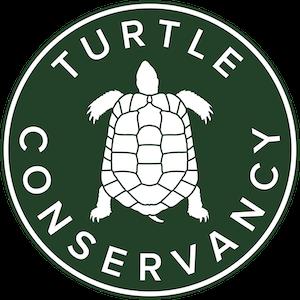
Turtle Conservancy
(TC; www.turtleconservancy.org)
The Turtle Conservancy is dedicated to protecting threatened turtles and tortoises and their habitats worldwide, and to promoting their appreciation by people everywhere. We meet this mission by conserving species in their natural habitats including land protection, helping to prevent trade that threatens species, maintaining captive breeding programs to help restore natural populations, developing the capacity of turtle conservationists working in key areas, and promoting global appreciation for the wonder of turtles. The Conservancy was established in 2005 as a 501(c)(3) public charity, is certified by the Association of Zoos and Aquariums, and is an International Member of the IUCN.
As turtle extinctions continue, the Conservancy has alerted tens of millions of people around the world about the crisis, catalyzing a global movement in support of turtle conservation. We maintain assurance colonies of 42 threatened chelonian species, have successfully bred 34 species, and performed the first-ever international repatriation of a turtle or tortoise species for conservation. The Conservancy’s Geometric Tortoise Preserve protects more than 800 acres of Fynbos in South Africa, one of the most biologically diverse and endangered of all the world’s ecosystems. Our Goode’s Thornscrub Tortoise Preserve in Sonora, Mexico, protects 1,000 acres of threatened tropical dry forest. Our Bolson Tortoise Preserve in Durango, Mexico, rescued 43,540 acres of Chihuahuan Desert from encroaching industrial agriculture, thereby safeguarding one of North America’s most threatened ecosystems from exploitation by humans. Our most recent land acquisition is nearly 2,500 acres in the Cuatro Ciénegas Valley in northern Mexico, to protect three endemic threatened species that live there and nowhere else.
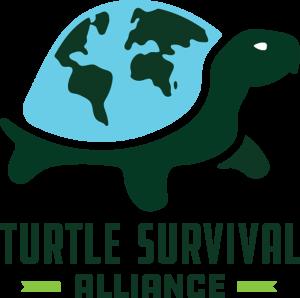
Turtle Survival Alliance (TSA; www.turtlesurvival.org)
Formed in 2001 and gaining nonprofit status in 2004, Turtle Survival Alliance (TSA) is a global conservation organization with a mission to protect and restore wild populations of tortoises and freshwater turtles through science-based conservation, global leadership, and local stewardship. TSA has prioritized more than 150 species, selected based on their level of endangerment, our understanding of their conservation needs, and the resources available to support them. This strategy is built on three foundational pillars: Species Protection, Community Engagement, and Best-in-Class Practices. Our science-based initiatives are directed by local leaders, inspiring sustainable, community-based stewardship to prevent extinctions. Where populations cannot yet thrive in the wild, our conservation breeding programs preserve critical genetic diversity and the potential for future recovery.
Turtle Survival Alliance operates or supports projects in 20 countries around the world, protecting critical habitats and providing on-the-ground resources to safeguard the most imperiled turtle and tortoise species. As part of this integrated approach, TSA established and manages the Turtle Survival Center in South Carolina, a facility dedicated to saving species that are functionally extinct in the wild or require assurance colonies to persist. Today, the Center manages more than 800 specimens representing 30 species and subspecies ranked Critically Endangered or Endangered on the IUCN Red List. With an unwavering commitment to zero turtle extinctions, TSA unites global partnerships, expert knowledge, and community-based action to transform passion for turtles into effective conservation outcomes.
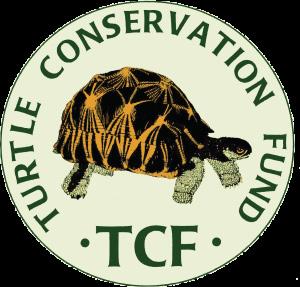
Turtle Conservation Fund (TCF; www.turtleconservationfund.org)
The Turtle Conservation Fund (TCF) is a strategizing and funding partnership coalition of leading turtle conservation organizations and individuals focused on ensuring the long-term survival of tortoises and freshwater turtles. The TCF was established in 2002 as a non-aligned collaborative partnership of Conservation International, IUCN SSC Tortoise and Freshwater Turtle Specialist Group, and Turtle Survival Alliance. It has over the years been supported by several other turtle-focused conservation organizations, including the Shellshock Campaign of the European Association of Zoos and Aquaria, Humane Society International of Australia, Turtle Conservancy, Global Wildlife Conservation, Re:wild, Chelonian Research Foundation, Panaphil Foundation, the Gregory Family Trust, the Andrew Sabin Family Foundation, and several generous individual donors. TCF produced a Global Action Plan in 2002, and in 2003 compiled the first list of the Top 25 Endangered Turtles, and has since then provided strategic funding for many conservation projects from all over the world, focused primarily on Critically Endangered or Endangered tortoises and freshwater turtles, as well as some Data Deficient species. To date the TCF has disbursed over $1.6 million in small seed grants (average grant ca. $4,300) to about 380 projects focused on endangered turtles and tortoises in 65 nations. Since TCF is not a formal legal entity, Re:wild and Chelonian Research Foundation serve as its financial umbrella organizations.
Chelonian Research Foundation (www.chelonian.org)
Founded in 1992 in Massachusetts and now based in Vermont, Chelonian Research Foundation (CRF) is an IRS-designated 501(c)(3) private operating foundation. The mission of CRF is the production, publication, and support of worldwide turtle and tortoise research, with an emphasis on the scientific basis of chelonian diversity and conservation biology. CRF has published the peer-reviewed professional turtle journal Chelonian Conservation and Biology since 1993 (distributed by Allen Press since 2006) as well as the book-length Chelonian Research Monographs series since 1996. The monograph series includes the ongoing comprehensive publication project on Conservation Biology of Freshwater Turtles and Tortoises compiled in association with the IUCN SSC Tortoise and Freshwater Turtle Specialist Group (TFTSG) since 2008, as well as its associated checklist authored by the Turtle Taxonomy Working Group (Turtles of the World: An Annotated Checklist and Atlas). In 2017, CRF joined forces with the Turtle Conservancy to co-publish both Chelonian Conservation and Biology and Chelonian Research Monographs. CRF also provides support for various turtle ecology, taxonomy, and conservation endeavors and programs, including administering the Congdon-Dickson Turtle Ecology Fund (www.chelonian.org/ cdrf/), the Turtle Taxonomy Fund (www.chelonian.org/ttf/), the Behler / Pritchard Turtle Conservation Awards (www.iucn-tftsg.org/behler/), and the Student Presentation Awards at the TSA/TFTSG Annual Symposium. CRF also serves as a nonprofit financial umbrella organization for the TFTSG, the Turtle Conservation Fund, and the Eastern Box Turtle Conservation Trust.

Re:wild (www.rewild.org)
Re:wild protects and restores the wild. They have a singular and powerful focus: the wild as the most effective solution to the interconnected climate, biodiversity, and human well-being crises. Founded by a group of renowned scientists together with Leonardo DiCaprio, Re:wild is a force multiplier that brings together Indigenous peoples, local communities, leaders, NGOs, governments, companies, and the public to protect and rewild at the scale and speed needed.
Solutions to climate change, biodiversity loss, and threats to human health lie in nature. Re:wild and its global network of more than 500 partners in more than 80 countries are working to conserve more than 565 million acres of the wild. They focus on solutions—such as creating and managing protected areas, restoring ecosystems, and preventing wildlife crime—that are tailored to local ecological, cultural, and socioeconomic contexts, and implemented by local partners. This collaborative approach enables Re:wild to scale impact through the replication and amplification of proven solutions, and to act quickly where need meets opportunity. With partners, Re:wild is driving targeted conservation action for 265 threatened species and benefitting an additional 31,000 species. Learn more at www.rewild.org.
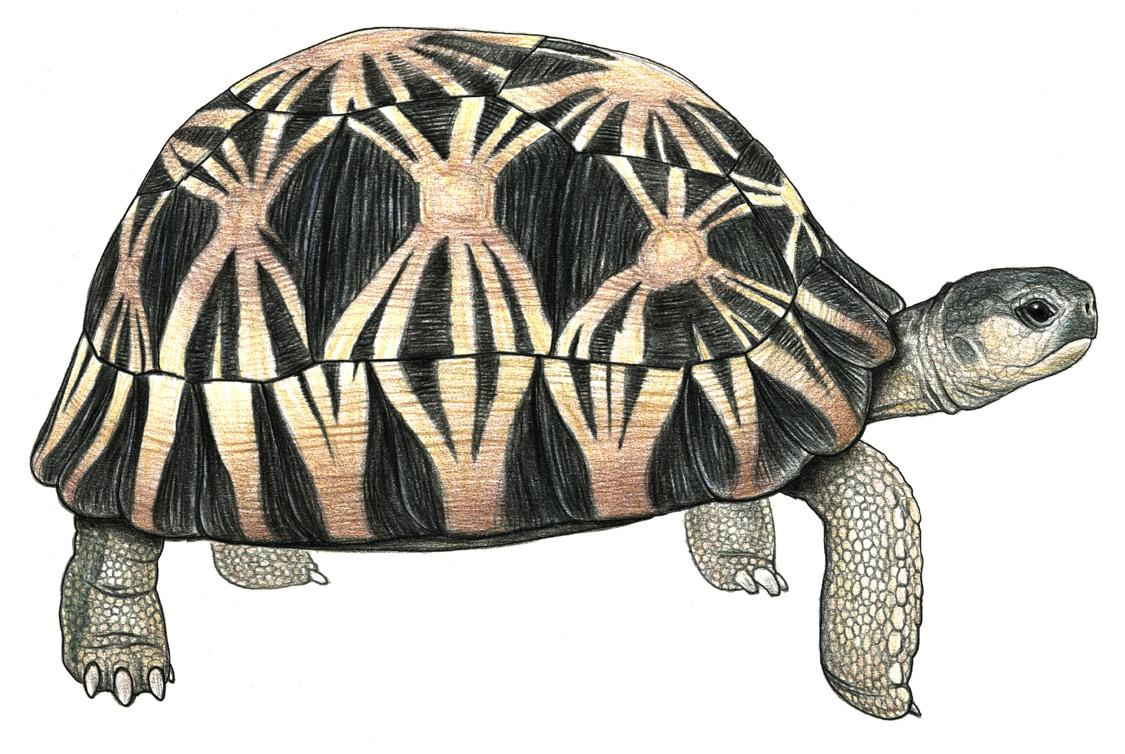



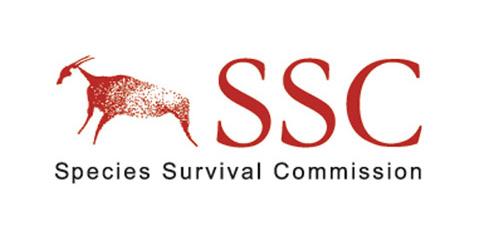
Stephen D. Nash
Young Buddhist nuns holding a Critically Endangered Arakan Forest Turtle (Heosemys depressa) in Mandalay, Myanmar
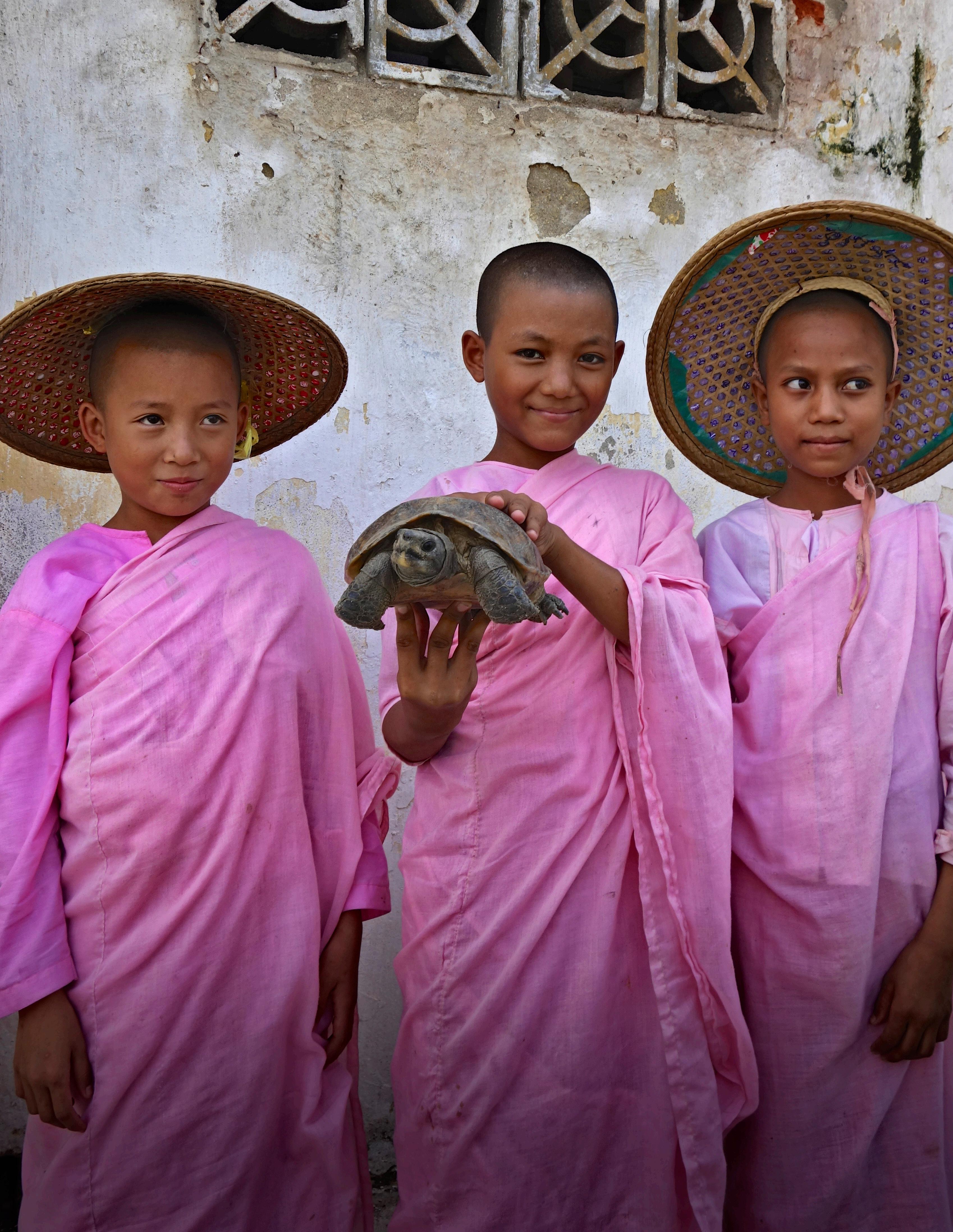
Citation: TCC [Turtle Conservation Coalition: Stanford, C.B., rhodin, a.G.J., van diJk, P.P., BlanCk, t., Goode, e.v., hudSon, r., Walde, a.d., Gray, J., MitterMeier, r.a., and Páez, v.P. (Eds.)]. 2025. Turtles in Trouble: The World’s Most Endangered Tortoises and Freshwater Turtles – 2025. Ojai, CA: IUCN SSC Tortoise and Freshwater Turtle Specialist Group, Turtle Conservancy, Turtle Survival Alliance, Turtle Conservation Fund, Re:wild, and Chelonian Research Foundation, 77 pp.
